

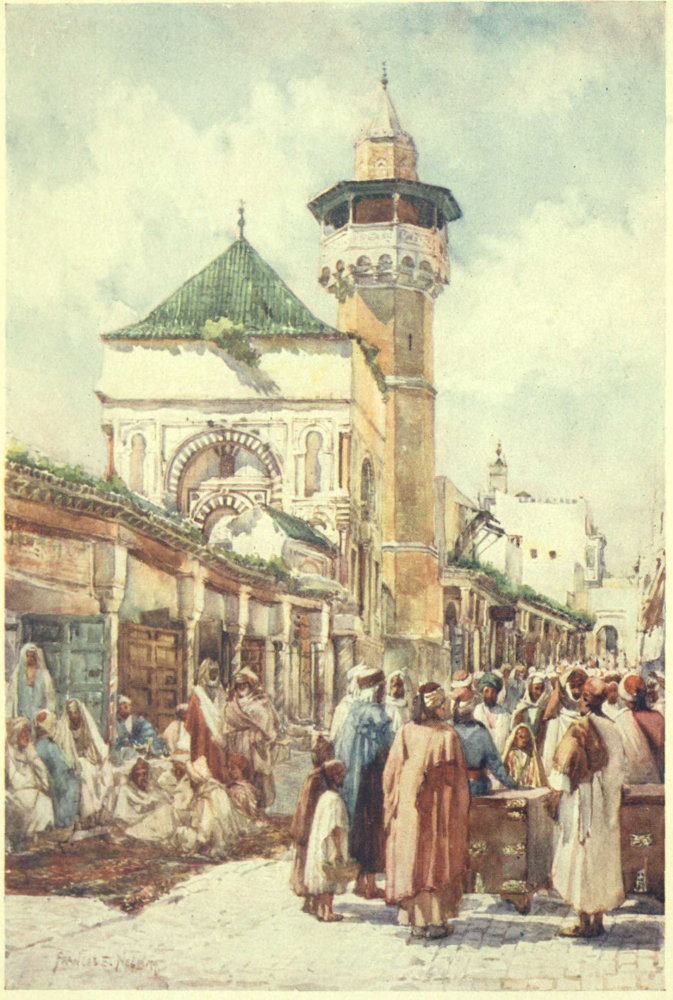
MOSQUE OF SIDI ZIAD, TUNIS
The Auction Day
PAINTED & DESCRIBED
BY FRANCES E. NESBITT
PUBLISHED BY A. AND C.
BLACK · LONDON · MCMVI
The Illustrations in this volume have been engraved and printed in England by The Hentschel Colourtype, Limited.
Algiers is such a city of contrasts, of dark memories and present prosperity, of Christian slavery and Christian rule, brilliant sun and tropical rain, of wide modern streets and networks of narrow alleys, with the slow dignity of movement of the old race and the rapid vivacity of their new rulers, that it makes all the difference in the world in what spirit and at what moment you arrive. At times the city is all sunshine, “a diamond in an emerald frame,” as the Arabs call it; at others only a dim outline is visible blotted out by the tropical rain.
When first we saw Algiers, after a dreamy, peaceful voyage from Gibraltar, the city was in its most brilliant mood. Having started in glorious spring weather, we watched the Sierra Nevada actually fulfilling all childish dreams of snow mountains, seemingly suspended in the soft cloudy distance with a suggestion of a double horizon, which some people called a mirage. Blue sky, bluer sea, still and calm,—nothing 4 discordant but the notes of the bugle-calls to meals. By nightfall the mountains had faded away, and all we saw was a long line of blue African coast, mysterious and dim. But in the morning there was excitement and bustle enough, the bugles beginning at dawn—a lovely dawn and sunrise. Then the joy of coming into harbour and seeing the white terraces of the town gleaming in the sunshine. General impression all charm, brightness, and colour. The next time we felt the full force of contrast. Grey drizzling weather at Marseilles, a rolling sea, cold winds and general depression as the keynote of the voyage, to be followed by a late landing on a winter evening, the bright green of the hills dim with rain, the houses looking as grey and chill as ourselves standing forlornly under umbrellas on dripping decks, and almost wet through in the short run from the steamer to a carriage; for a downpour in Algiers is a downpour, just as sunshine is really sunshine, and not the faint flickering of light and shade we sometimes mistake for it at home. So that we could fully sympathise with our fellow-travellers’ distress, whilst remembering the loveliness we knew might return at any moment. In any case landing is rather a disappointment, because the first impression is so entirely French, with scarcely a touch of the East. The harbour, quay, and houses behind are all modern, and might belong to any city of southern France; the only difference at first is the sight of the boys, with their smiling faces and queer clothes, who fight for the privilege of carrying the luggage—such nondescript clothes, half European, half Eastern. Old coats, old boots, the coats generally too small, the boots too large, worn with a variety of Eastern garments and nearly always with a scarlet Manchester handkerchief wound round their heads.
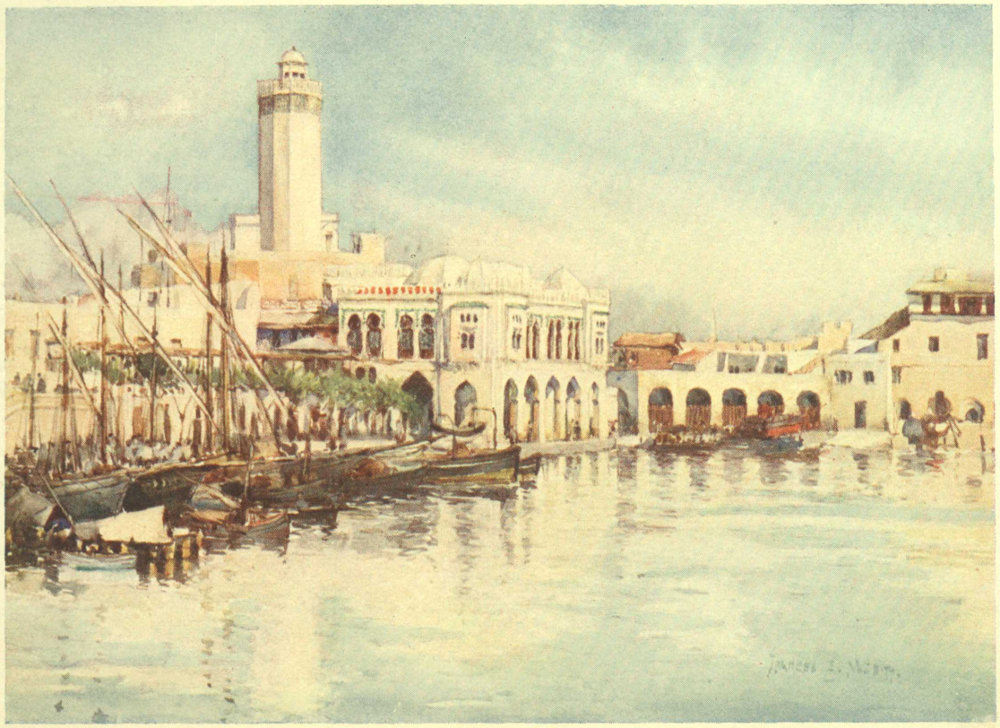
THE PENON, ALGIERS
Driving through the town, the French touch dominates everywhere—very wide streets, high houses, electric trams, motor cars, shops all entirely European; and then, as Mustapha is reached, the white houses, the gardens, even the view over the Bay to the mountains beyond, suggest Italy, the Bay of Naples, not the home of those dreaded pirates who so recently held their reign of terror here. In fact, those who like to do so might imagine they had never left the Riviera. But for those who love exploring strange scenes, there is a great deal more than this: for behind those tiresome modern houses the Arab quarter lies hidden, little altered and yet fast disappearing. The winding Rue de Rovigo cuts through it again and again on its way from the harbour to the Casbah, and yet it is still quite easy to get lost in the mazes of the narrow streets. In old times, when the Dey still ruled and the walls ran triangular fashion from the broad base of the harbour to the great fortress, or Casbah, at the top of the hill, the city must have been charming to look at, however terrible to live in. Now it is possible to go safely into even the darkest and remotest corners—and they are dark indeed. A first visit leaves one breathless but delighted. Breathless, because all the streets are staircases on a more or less imposing scale; the longest is 6 said to have at least 500 steps; delighted, because at every turn there is sure to be something unusual to a stranger’s eye. The newer stairs are wide and straight and very uninteresting. But only turn into any old street and follow its windings, in and out between white walls, under arches through gloomy passages, here a few stairs, there a gentle incline always up, and always the cool deep shade leading to the bright blue of the sky above. Being so narrow and so steep, there are of course no camels and no carts. Donkeys do all the work, and trot up and down with the strangest loads, though porters carry furniture and most of the biggest things. Up and down these streets comes an endless variety of figures—town and country Arabs, Spahis in their gay uniforms, French soldiers, Italian workmen, children in vivid colours, Jewesses with heads and chins swathed in dark wrappings, and interesting beyond all these the Arab women flitting like ghosts from one shadowy corner to another, the folds of their haïcks concealing all the glories of their indoor dress, so that in the street the only sign of riches lies in the daintiness of the French shoes, and the fact that the haïck is pure silk, and the little veil over the face of a finer material, as the enormous Turkish trousers are all alike and of cotton. Still, it is hardly a satisfactory crowd from a picturesque standpoint, as everything seems so mixed up, and so many of the people do not even appear to know themselves what their nationality is, or their dress should be. Bazaars there are none, only the usual Eastern-looking little shops, and the Moorish cafés crowded with men drinking their tiny cups of coffee and smoking cigarettes.
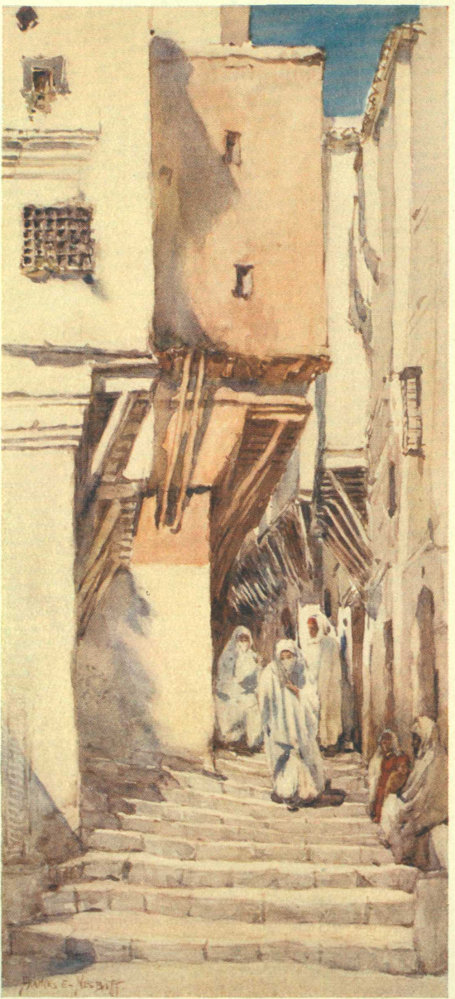
AN OLD STREET, ALGIERS
The architectural peculiarity of Algiers is the curious arrangement of poles, all supposed to be of cedar wood, supporting the upper stories of the houses, which are built to project over and shade the lower, and nearly meeting overhead. Occasionally a fine gateway, rarely a decorative window, breaks the white surface of the walls, which are whitewashed and rewhitewashed continually. Generally the outer windows are mere holes, and the doors are hidden in the darkest corners. To the uninitiated nothing suggests riches or poverty; the walls are like masks. But once inside and through the dark entrance corridor, some of the houses are most beautiful. They are much alike, with their cloistered courts, with delicate, twisted columns and fine capitals. The reception-rooms have wide openings into the court, so that the cool fountain, and the flowers and trees, if there are any, may be enjoyed. The upper rooms open in a similar fashion upon a wooden balcony, generally beautiful with carving. The court and all the rooms are decorated with tiles of old designs, very rich and soft in colour, and many of the rooms have stucco work in the style of the Alhambra, only rougher and coarser in handling. Such houses or palaces or fragments of them are numerous. The Archbishop’s Palace, the Governor’s Palace, the old library, and the curiosity shops are the best known.
Even some of the schools are in fine old houses. The embroidery school was the prettiest, and was a charming 8 sight with the court full of tiny children sitting on the matting and bending over their low embroidery frames—beautiful embroideries hanging over the balcony; and if one chose to climb up to the roof, a fine view of old Algiers, its roofs and terraces. Now the school has moved to larger quarters—another old house, pretty also, but not so interesting. The carpet school is most picturesque: there is a big doorway and the usual dark passage, then the door opens into the court, which is quite a small one with very strong light and shade. Between the pillars all round stand the big looms, and on low benches in front sit the little girls at work. The floor of the court is marble, the pillars are very curiously cut in varying designs, and are all coloured a rich yellowish orange. The balcony of the upper story has some good carved work, but very little of it is visible owing to the carpets of every tone and tint which hang over it. There are carpets on the floor, carpets in rolls, carpets and children everywhere; for upstairs also are more looms, and everywhere little workers, mostly girls, with here and there a very small boy—odd little things, with their long full Turkish trousers, white or in bright colours, their loose jackets, also mostly white, and their little heads veiled in white or else bound round with the gayest of handkerchiefs. The effect is often spoilt by common European blouses and quite hideous check shawls. Carpet-making looks easy enough, and the children seem to enjoy threading the bright wool through the web and tying the knots; for a little while that is, then like a little flight of butterflies they all come in a whirl to see what the stranger is doing in the dark inner room. This was alarming at first, as many are the stories of sketches destroyed and artists tormented by the irate victims of their brushes, and these innocent-looking little people, with their sweet smiles and pretty ways, were said to be most troublesome. But either they did not understand or they liked to be painted, for the smiles never died away till the mistress ordered them back to work, though for a few minutes one little maid propped up her pattern so as to hide her face. However, she soon forgot and things went on as before.
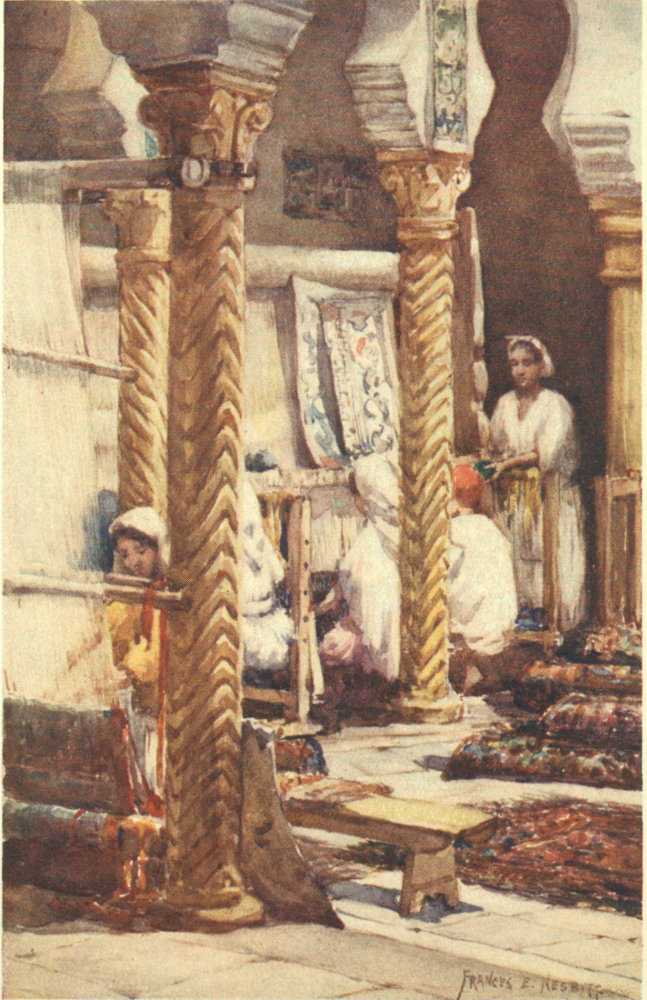
THE CARPET SCHOOL, ALGIERS
This was not always the case, for in the garden of one of the mosques the small boys climbed a tree and threw stones at the drawings, because, as they excitedly explained, “The Mosque belongs to us, and no stranger has any business even to look at it.” This is rather a hard saying, as the tomb-mosque in question—that of the Saint called Sidi Mohammed Abder Rahman-el-Telebi—is decidedly attractive to the poor despised foreigner. To reach it there is a good climb up many steps through the old town to a bare and dusty spot on one of the new roads—a most unpromising road to look at if it were not for a glimpse of blue over the roofs below. Until last year there was only a plain white wall and then a gateway, and outside the gateway, squatting in the dust, a sad company all sick or infirm, and all beggars striving and struggling for compassion and un petit sou. Now the gateway is dwarfed and hidden by the domes of the new schools of the mosque, 10 white with an absolutely blinding whiteness, making the importunity of the beggars seem less annoying than this aggressive newness. From the gateway a narrow staircase descends towards the sea, and at the first white domed tomb there is a turn, a door is pushed open, and a strange little burying-place is seen, with many sacred tombs, the most important of which is decorated with tiles and a projecting roof. Many of the smaller tombs are covered completely with tiles, mostly green and blue. There are also bands of old faience round the minaret, which is a very graceful one, having three tiers of slender colonnades running round it. A little grass, a few trees, a great cypress, a budding fig-tree, and the Arab women moving softly, for this is one of their favourite places of prayer, complete the picture. The mosque itself is small, the tomb seen dimly in the darkness, which gives a mystery and charm to the abundance of queer things hanging as votive offerings, and to the rich colours of the tiles and the carpets. It is not an important mosque, but it is a place full of character and attraction, partly from its situation and partly from the irregularity and strangeness of the buildings. The other mosques have none of this undefined charm, being simply large, bare, whitewashed buildings, with, in the case of the great mosque, some fine old columns and a very pretty fountain in the court with a tree shadowing it, and bright tiles as decoration. There is also a tiny mosque in the old town, which is always full of women praying for babies. It is the tomb of another saint, and so small that the best way to see it is to stoop and look in through a window and watch the women, who are not so absorbed in prayer as to prevent their smiling and returning the gaze with interest.
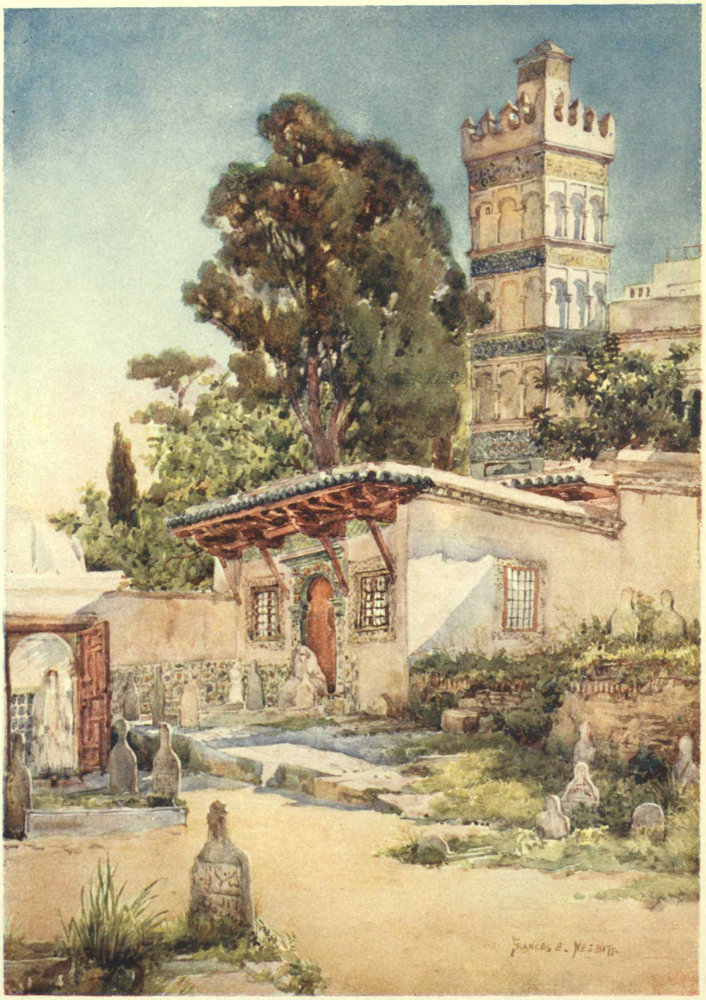
MOSQUE OF SIDI ABDER RAHMAN, ALGIERS
For the rest, there is a sad feeling that most of the Oriental life is dying slowly out, that the quaintness is disappearing, and that the tendency is greater here than elsewhere to cover over and hide the old life and manners with a sort of cloak of modern civilisation. It is even said that all the better-class Arabs have already emigrated to Tunis, Egypt, or Constantinople. The walls have gone, the gates also. Nothing now is left but the great fortress itself upon the highest point of the city, now used for barracks, a few fragments of the walls, and most beautiful of all, the old harbour. It is almost impossible to believe that such a small harbour ever sheltered so strong a pirate fleet that it could ravage the coasts of Corsica, Sardinia, Sicily, the ports of Italy and Spain, and even penetrate as far as England. Although Mr. Eaton, an American Consul who was sent with arrears of tribute (four vessels) due from the United States in 1798, did say, “Can any man believe that this elevated brute has seven kings of Europe, two Republics, and a Continent tributary to him, when his whole naval force is not equal to two line of battleships?” Yet these Barbary pirates literally spread terror around from their earliest beginnings in 1390 down to the time when Lord Exmouth brought the Dey to reason by bombarding Algiers in 1816 and freeing the slaves. But that was only a temporary improvement, and the bad state of affairs only came to an 12 end with the French occupation in 1830. The whole history of the Barbary State is very sad and humiliating reading, with its accounts of the bargaining of the various Powers for the release of the Christian slaves, of whom there were often as many as twenty thousand to thirty thousand in Algiers itself. Now the harbour is full of innocent-looking coasting craft with lateen sails, many pleasure-boats and yachts, and a few torpedo boats. The serious business of shipping goes on in the outer harbour, which is full of steamers and merchantmen, whose dark hulls and smoking funnels form another striking but not attractive contrast.
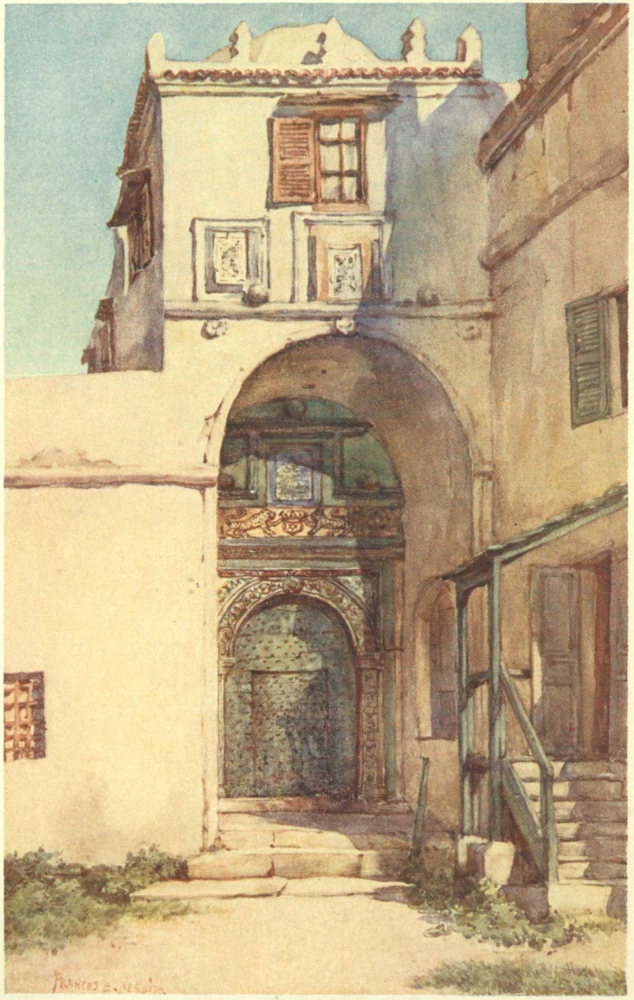
THE LEOPARD DOOR, ALGIERS
The beautiful Moorish tower called the Penon, and now used as a lighthouse, was built in 1544 on the site of the old Spanish fort, and rises from the midst of a group of old buildings, with here and there a fine bit of Moorish work amongst them, though, as they are used by the Admiralty, there is much that is modern and business-like as well. In the wall is a characteristic fountain; a flat surface decorated with inscriptions in Arabic and carvings in marble in very slight relief, with a simple spout for the water. Farther on, rather hidden up in a corner under an arch, is the famous Tiger or Leopard gateway—a very curious bit of work, the chief peculiarity of which is that these two odd heraldic animals guarding a shield are supposed to be of Arab workmanship. Now, as it is strictly forbidden by their religion to make images of living moving things, a legend has been invented to the effect that the decoration was done by a Persian slave, and that his masters found it so surpassingly beautiful that they had not the heart to destroy it. However, it really looks much more like Spanish work done during their occupation of the place, and though quaint, decorative, and rather unusual, is not really beautiful at all. These and many more are the old-world nooks and corners in the city which the modern builder has not yet overthrown, and where it is quite easy for a few moments to dream oneself back into the old life, though the dreams generally end in a sudden shock—the noise of an electric tram, the hooting of a motor, a cyclist’s bell, or the appearance of some thoroughly Western figure who could never have had any sympathy with the Arabian Nights.
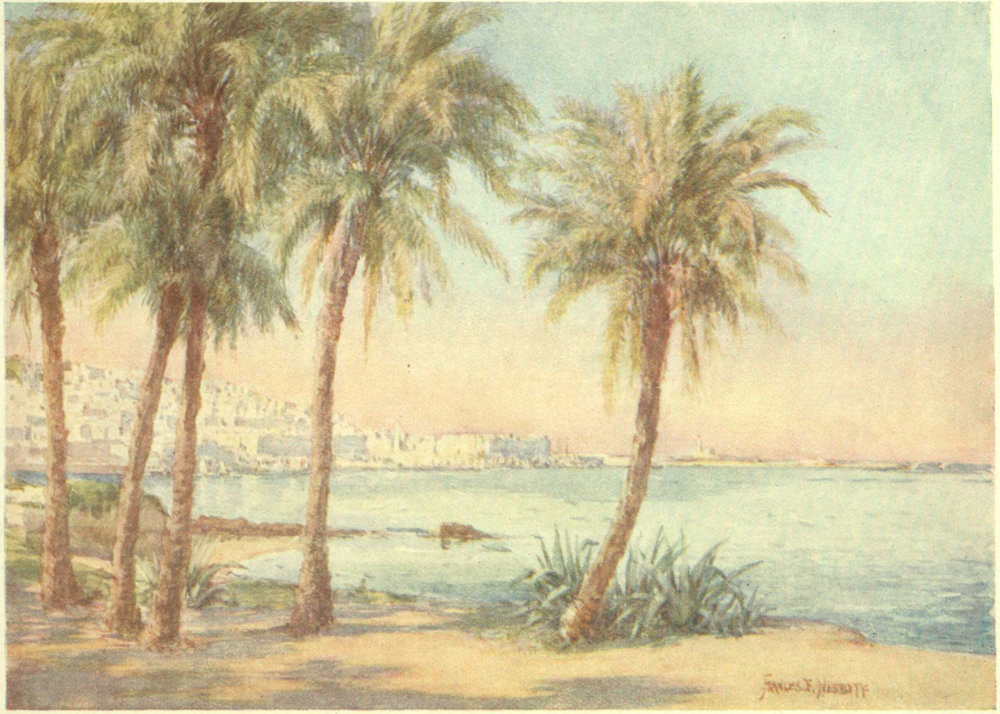
ALGIERS FROM THE JARDIN D’ESSAI
Whatever people may think of Algiers itself,—whether they are most attracted by its old-world side, or its up-to-date would-be Paris quarter, with the wide, handsome boulevards and quays, the arcaded streets, the crowded squares, or even by the endless pleasure of treasure-hunting in the many curiosity shops, and the yet more endless bargaining that this entails,—still it is generally with a sigh of relief that they turn from the noise and clatter of the stone-paved streets, and wind their way towards the heights of Mustapha Supérieur and El Biar, where most of the foreign visitors and residents live.
At first the way is weary, up-hill as usual, and along a prosaic street, almost the only interest being a few fragments of the city wall near the English church, which till only a few years ago stood at the meeting-place of town and country, and is now quite swallowed up by the ever-growing town.
But though the ascent may be steep, the way long, and the streets not very interesting, these little matters 18 are soon forgotten as the road passes quite suddenly at last into a region of shady trees and gardens, and winds on and up past hotels and villas till at last the heights are gained, and lovely, ever-varying views open on every side. It is a joy to live in one of these white houses half-hidden by a mist of green, to stand on the sunny terrace in the early part of the day and look out over the sea—a joy which is new every morning and which increases day by day.
In the distance, above the exquisite curve of the bay, is a long line of mountains, imposing enough, and fine in form, sometimes dark and gloomy with storm cloud, at other times so faintly blue that their outlines barely show against the pale lightness of the sky. These nearer mountains are things of every day, and their changing moods are always visible, but above and beyond these come and go, for a few fleeting moments, like a vision, the great snow mountains of Kabylia. Mysterious, delicate, elusive, hardly to be distinguished from cloud masses, and yet grand and majestic in outline as any in Switzerland—a strange, unwonted sight to those who only know North Africa as it appears in Egypt. For though we all know better, snow mountains on this scale will suggest a northern landscape with pines and fir trees, and not the sort of vegetation this garden land supplies as a foreground. As far as one can see, a rich plain and softly wooded heights, olives and almonds, palms and pepper trees, sycamores, stone pines in endless variety, and closer still are tropical flowers, strange to see with a snow background. It seems wrong, somehow, and the fact of its being January adds to the oddness of the feeling.
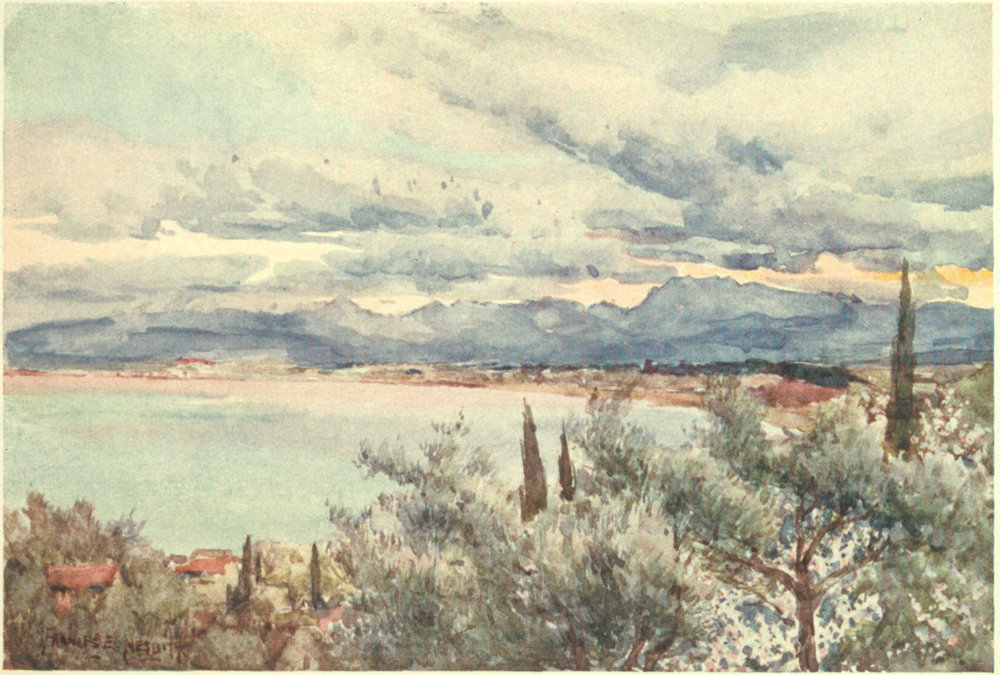
VIEW FROM MUSTAPHA, ALGIERS
But the view cannot be said to be all charm and dreamy beauty, for unfortunately, or fortunately, there is a great deal more. Lower Mustapha also lies spread like a map before you—a prosperous town, with factories, government and otherwise, smoking chimneys, and barracks. This is why early morning is the best moment, for then the veil of smoke and mist hides the ugliness, and prevents the counting of those odious chimneys, and leaves Upper Mustapha alone to act as foreground, where it is still country, in its own way, the hills covered with trees and gardens, and the endless houses simply showing as sparkles of light. Still, it is one of those places that makes the new-comer long to have seen and known a few years ago, before this sudden great prosperity; for in those days when the factories did not exist, the villas were all beautiful, and few and far between, and it was possible to walk through fields, and over the hillside, gathering wild flowers all the way, to the very gates of the city. And all this is a question of a few years, so rapid has been the success of the colony when once it really started; before that, the old descriptions of the place held true and still do so, if only a little judicious shutting of the eyes is used occasionally, such as the glowing picture, drawn by one of the English officers of the squadron that came to Algiers in 1674, of the beautiful country, houses white as chalk on either side of the town, with 20 gardens and vineyards abounding in all kinds of fruit and vegetables. Oranges and lemons had only lately been planted, but they produced so abundantly, that “he bought sixty for a royal”; although it was Christmas they had apples, cauliflowers, roses, carnations, and “most sorts of ffruights, flowers and salating.”
It would now take an immense catalogue, as large as any of the bulky volumes issued by our English seedsmen, to sum up all the trees, flowers, and fruits that can be found not only in the beautiful gardens, or in the great Jardin d’Essai, but also growing wild on the whole country-side. In January the trees and hedges along the roads and by-ways are festooned by masses of white clematis growing like our traveller’s joy, but with flowers whose petals are at least an inch long. A little later there are irises everywhere: a dwarf kind with large lilac-coloured flowers, and also, but rarely, a white variety has been found. Then comes one of the chief pleasures of spring—drives far out into the country, where the rolling hills, the coombes, and the rich, red soil bring memories of Devonshire (memories a little disturbed by the vineyards that clothe the hills, and the distant snow-clad mountains). The object of these drives is to gather the wild narcissus, which is found growing in marshy hollows on the wildest parts of the hillside beyond Dely Ibrahim. They grow in such quantities, that large bunches can be made in a few minutes at the expense of a little agility and some rather muddy boots. Later on, the asphodel covers every waste space with flowery spikes and ribbon leaves.

ON MY BALCONY, ALGIERS
The roads, as is the way of French roads, are wide and good, with gradients suited to military needs; but the lanes of Mustapha and El Biar are a feature of the place—narrow, sometimes very steep, often more like the bed of a torrent than a path, with stone walls full of plants and ferns, overarched by trees, with aloes and prickly pear crowning the banks; shady and cool in the heat, damp like a tunnel in the wet, lonely and not always very safe—a point which perhaps adds something to their fascination.
The real delight of the whole place lies for most people in the possession of a villa, Moorish or otherwise, and a garden—and the garden is the thing. This is why there are many who cannot feel the indescribable charm which makes Egypt what it is. They talk of the monotony of sand and hill, palm and river, and miss those months of winter passed amidst the flowers and trees, and can hardly realise that the still water, and the sunsets which seem to open the very gates of heaven, can ever compensate even slightly for their loss. Naturally they have sunsets too; only to enjoy them properly you must dwell on the heights of El Biar and arrange to have a western outlook across the plain. Then and then only can you sometimes feel that the glories, and now and then the calm of the East reach even here. Flowers are better is their cry, and perhaps this is true; at any rate it is good to live all through what should be winter with the white walls of your house aglow 22 with colour, draped with purple Bougainvillæa, or, as in one well-known, well-loved garden, with a fiery cross of the more uncommon terra cotta variety upon that same fine whiteness, with the blue sea far beyond, and peeps of mountains, plain, and harbour as a background, whilst all around comes the scent of violets, sweet peas and roses, not to speak of calycanthus and other fragrant shrubs. Here there are irises and narcissus, and all the old-world English flowers, mingling in friendly fashion with strange companions: cactus and aloes of every variety, arum lilies, the white hanging bells of the datura, the birdlike brightness of the strelitzia, the gorgeous scarlet of the Indian shoe-flower, all flourishing happily together. The very fountains bring thoughts of Egypt and Greece—full as they are of waving globes of feathery papyrus. There are bamboos from Japan; eucalyptus or blue gum from Australia; oranges, lemons, and bananas of the South; apples and pears from the North; and stately groups of stone pines, a purely Italian feature. Strange fruits are also to be found in this dream garden; the strangest of all, one that rejoices in the name of Monstera deliciosa. It has large thick leaves, slit somewhat like a banana, flowers resembling the wild arums of our English lanes magnified exceedingly, the fruit a cross between a pine-apple and a cone in appearance, and having a taste of the former mixed with something quite its own.
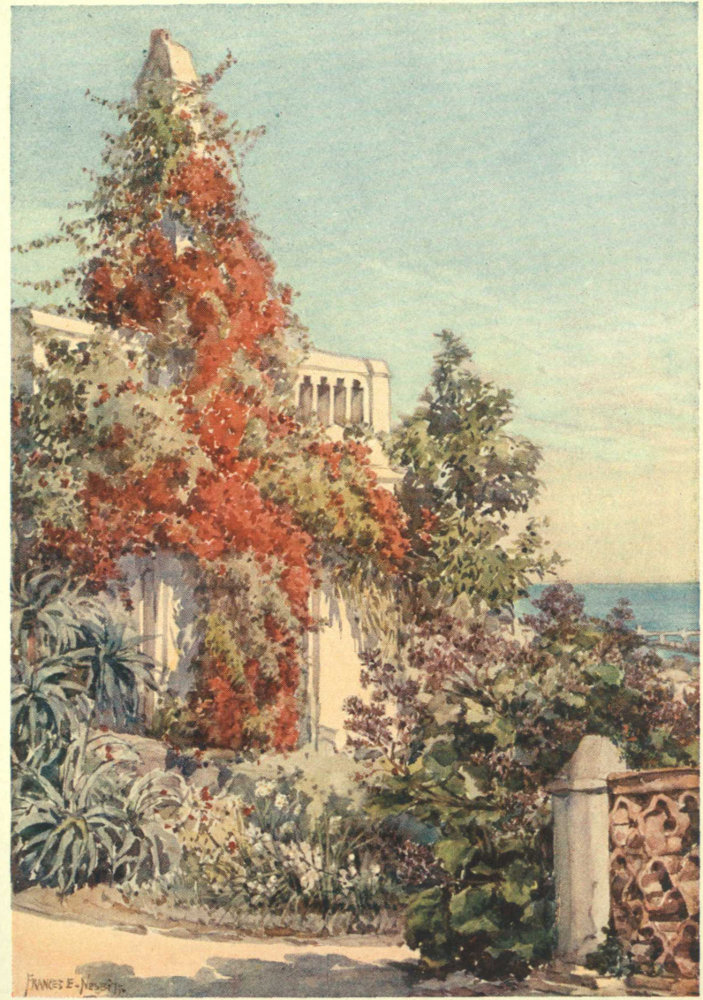
BOUGAINVILLEA, ALGIERS
Other gardens give lovely “bits”: in one a long border of arum lilies, growing as freely as Madonna lilies in a cottage garden, backed by flames of montbretia, and small queer aloes with paler flame-coloured flowers edging the path before them. The great scarlet aloe is the centre of many pictures, either solitary on a terrace, with trees and the bay, or in an old garden amongst cypresses, its red-hot pokers contrasting brilliantly with the rich green, or, better still, perhaps in masses on a long border under an open avenue of olives on a hillside, seen in the glow of evening, standing gemlike in the still blueness of sea and sky. Roses may be seen everywhere, festooning walls and forming hedges. The eye will rest with pleasure on some Moorish doorway surrounded by goodly bushes of pomegranate, their bright orange-red blossoms harmonising with the tones of the old building and with the violets; for here even they come into the picture, as Algerian violets are not occupied modestly hiding under their leaves, for they raise their heads proudly on long stalks, carpeting the ground with their fine purple, and the scent rises to the terrace far above them.
The old Moorish villas are all built on much the same plan as the houses in the town, collections of white cubes from without, and within a two storied arcaded court, on to which the various rooms open. In some there is also a women’s court, and occasionally a garden court as well. One of the most beautiful of these houses contains, under a glass let into one of the walls, a most remarkable record, said to be the only contemporary one of Christian slavery known to exist in Algiers. It was discovered during some repairs done by its first English owner, when a flake of plaster 24 fell off and disclosed this writing roughly scratched as if by a nail on a wet surface:—
John Robson
(wi)th my hand this 3rd day
Jany. in the year
1692.
This John Robson is known to have been released and restored to his family and friends by William Bowlett, who paid £11:2s. for his freedom—not a very high value for an Englishman even in those days. This same villa has a beautiful garden-court, which as you walk into it makes you feel as if you stepped backwards through the ages into a world of old romance, solemn and stately; and as you look from the cool shadow to the cloister arches and white twisted columns covered with bright creepers, you hardly realise that old tiles upon the wall, old red pavement at your feet, trees laden with oranges, a fountain covered with maiden-hair, and surrounded by a square pool of water, like a mirror reflecting the papyrus which grows in it, are the details that make up the picture, so entirely do the stillness and the peace throw their enchantment over all. Then with the opening of the great doors comes a vision of sunlit paths and brightest green, formal almost to stiffness in its lines—the old Harem garden. Many of the villas have beauties such as these, though few so perfect as a whole; often only a doorway or a window remains that still tells its tale of olden days.
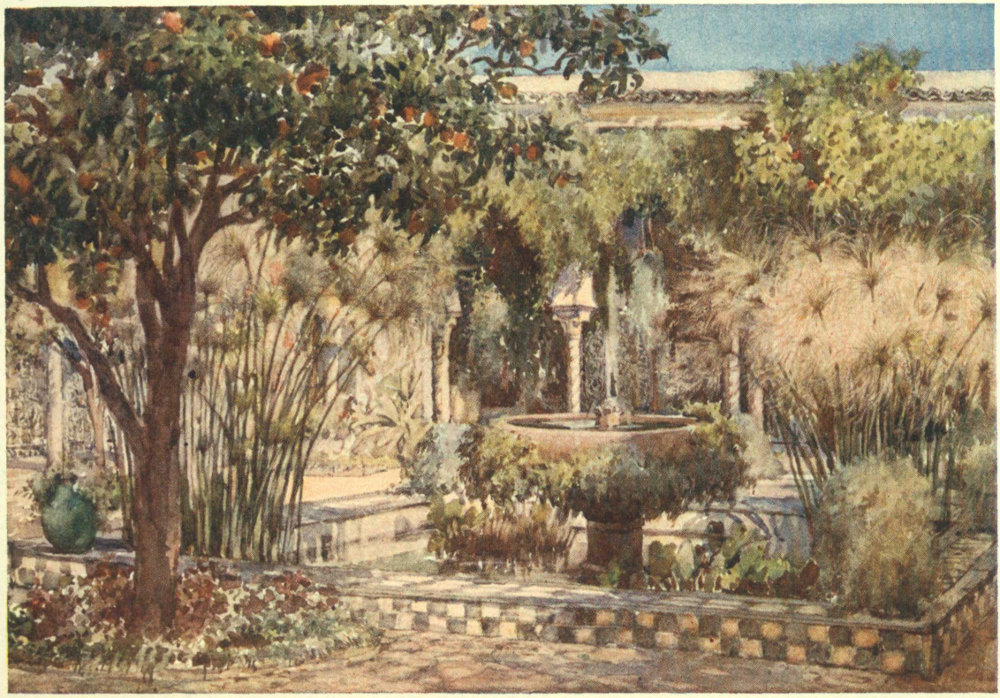
THE GARDEN COURT OF AN OLD MOORISH VILLA, ALGIERS
The pride of Lower Mustapha is the Jardin d’Essai, not properly a garden at all, not even a park, though it is big enough for that. It is a home for numbers of rare trees and shrubs of a more or less tropical character, a sort of school where they are trained to stand another climate, and from which some go forth and travel again to northern lands; for it is said that the culture of palm trees alone brings in at least £4000 a year, and that most of those sold in London and Paris come from this garden. India-rubber trees, bananas, and oranges are on the useful market-garden side, and to these might also be added its ostrich farm; but from the scientific or artistic point of view usefulness is a smaller thing than rarity and beauty. There are also trees of the most rare kinds with imposing names to rejoice the learned; and for the satisfaction of beauty lovers, long avenues of palms of every type, cocoa trees, quaint alleys of yuccas, and lightest and perhaps most graceful of all, the bamboo. Then for a change, just by crossing a road, there is a real oasis of ordinary palms, making a delicious shade for the little tables of two bright cafés; and from this spot, at the water’s very edge, is a peep of old Algiers, the “white city,” the harbour and the boats glowing in the soft afternoon light, and reflected in the calm opalescent water.
Quite near to the Jardin d’Essai is another garden, the Arab cemetery, very wild, and badly kept, its interest lying not in its own beauty, but in the fact 26 that Friday after Friday all the year round it is the place of pilgrimage of the Arab women. It contains the tomb of a celebrated saint called Sidi Mohammed Abder Rahman Bou Kobrin, who came at the end of the eighteenth century from the Djurdjura mountains, and founded a powerful sect or order, second only to that of Sidi Okba. His body was brought to Algiers and buried in the Koubba, but his followers in the wilds of Kabylia became furious until they discovered that all the time the body was still in its first resting-place as well. Now all is quiet and calm once more, as a wonder has been worked, so that henceforth he is Bou Kobrin, the man of two tombs. At noon the gates are closed to all men, and until six in the evening it is crowded with women and children. Here they come, in carriages and on foot, in big parties in special omnibuses, veiled, mysterious forms; but once inside they form laughing groups on the various family tombstones, take off the veils that cover their faces, showing glimpses of gay colours under the shrouding white. Here they picnic and chat and pay each other visits, and return with great interest the gaze of the European women who come to see them. The Arab ladies of Algiers live such secluded lives that this is often their only opportunity of going out, and it is quite their only chance of being free and unveiled out of their own homes, so that naturally they make the most of their time, and think as few sad thoughts as may be; so that although we have seen tears and passionate kissing of the tombs, and offerings of evergreens, the symbol of immortality, smiles and sweet glances are much more common. Some of them are really beautiful with their dark eyes and heavily painted eyebrows, some most surprisingly fair, and, though it is hardly polite to mention it of such carefully veiled dames, some are as surprisingly ugly. Often they talk a little French, and though most of them are horrified and turn their backs when they see a camera, sketching does not seem to be half such a terror, and they smile, and point, and say something that sounds like m’lyeh, and means pretty.
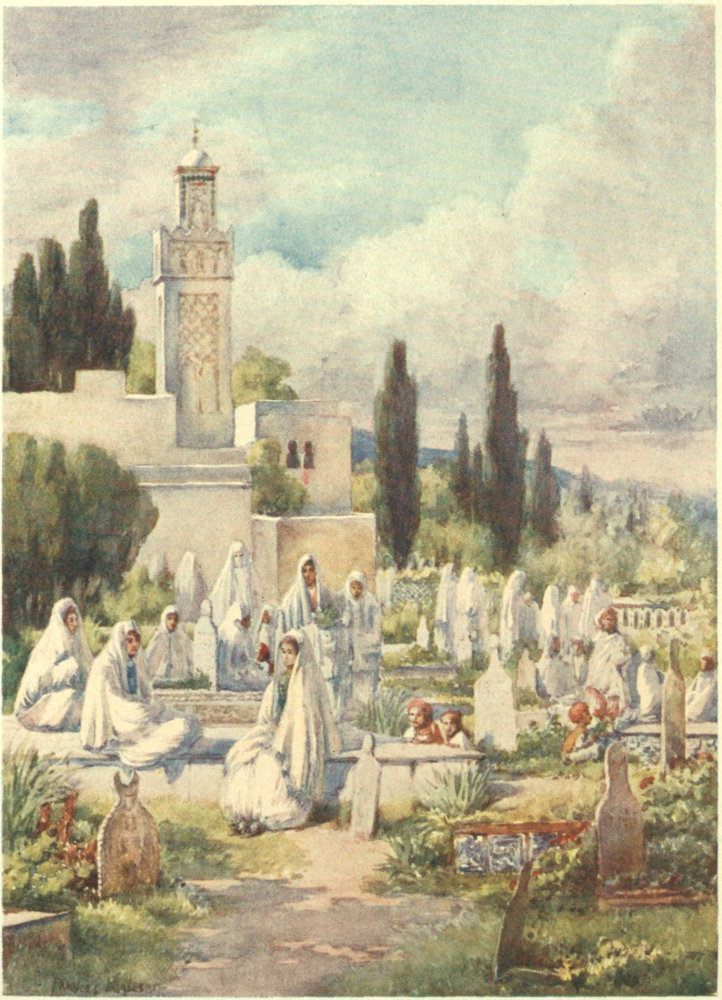
FRIDAY AT THE CEMETERY, ALGIERS
From cemeteries to tombs and shrines is a natural step, and here, as in Italy, there are endless places of pilgrimage. Mohammedan saints simply abound. In this part of the world they go by the name of Marabout, and the tomb-mosques built over their graves are called Marabouts also—a most confusing arrangement, so that it is quite a relief when Koubba is used as a substitute in discussing tombs. These tombs are mostly built on a very simple plan—a small cube surmounted by a dome, the whole as white as frequent whitewash can make it.
It is a delightful drive to the shrine of Sidi Noumann, at Bouzareah, through some of the prettiest scenery in the whole neighbourhood. Passing through Mustapha Supérieur and reaching the Colonne Voirol on the top of the hill, and then keeping at a high level along a country road, almost English with its high hedges, though most un-English in the glimpses that come every now and then of Moorish villas, stone pines and cypresses, with the deep blue sea on the one side, and on 28 the other the rich colour of the plain. After passing the busy little town of El Biar it is all real hill country, up and down, and round through vineyards and cornfields, smiling and prosperous, which bear witness to the untiring industry of the Colons or Colonists. Year by year the moorland is disappearing, larger and larger tracts come under cultivation, till soon there will be nothing but vines and corn as far as the eye can see, the vines especially being an enormous success. Farmhouses of European character nestle in hollows, or stand well sheltered by pines or eucalyptus, and these buildings contrast oddly with the Moorish houses, which resemble forts. Sometimes both styles of architecture are as mixed as the races who toil in these same fields and vineyards. French, Italians, Spaniards, men from the Balearic Isles, Moors and Kabyles, work together, talking strange-sounding tongues, a sort of patois at best, distinguished from each other by little touches in their dress, mainly in their headgear, the size of their hats, or its material, every sort of turban and handkerchief, and, ruling over them all, a pith helmet in hot weather. At last, after many turns and twists round wooded, waterless coombes, the carriage reaches the village of Bouzareah, and turning up a shady lane stops at a small enclosure. Arab boys promptly appear and insist on acting as guides, telling in very broken French that here the great Saint was buried, and making every one peep in to see the tomb itself in the dark interior of the Koubba.
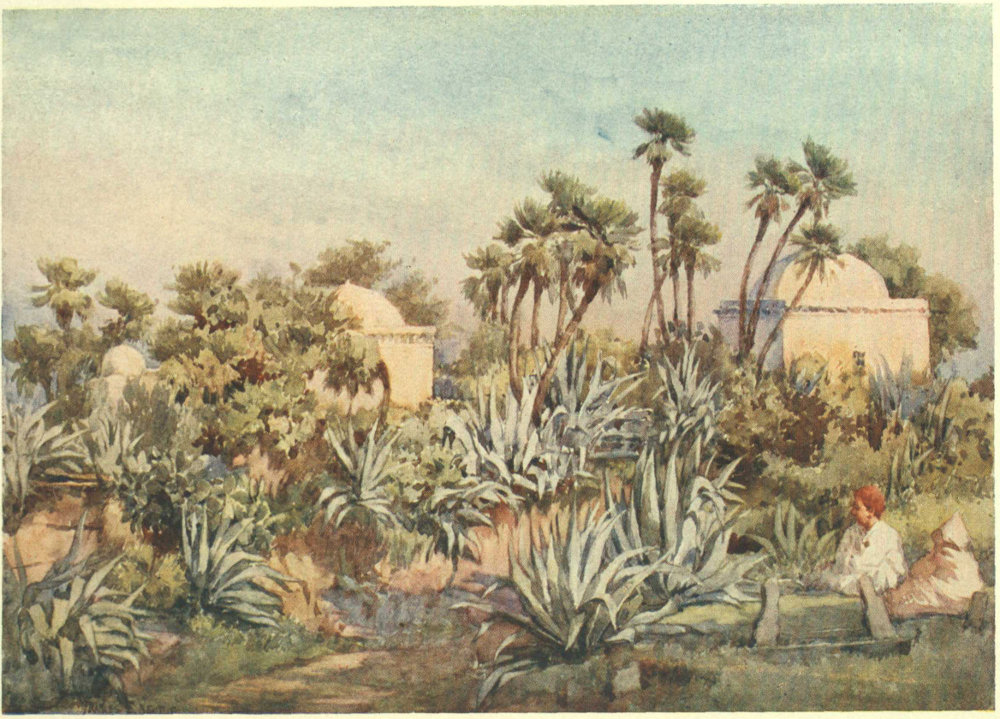
KOUBBA OF SIDI NOUMANN, BOUZAREAH
Another Marabout lives near by, and there is a minaret and small mosque, another tomb or so, and a well-house which almost looks like one. Groups of minuscule palms, whose heads of fan-shaped leaves seem too small for the size of their trunks, throw flickering shadows over the white walls, as the wind blows them to and fro. Outside the sacred place lies wild moorland, broken by simple stones, marking other graves scattered far and wide, pale purple iris growing half-hidden amongst them. Splendid aloes fringe the sides of a little lane which separates the tomb of the saint from the wind-swept lonely hill where his followers are buried—aloes whose soft greyish-blue leaves form delicate contrast in colour with the green of cactus and palm and the red of the crumbling banks. In the evening the view is beautiful from any part of this ridge, some 1300 feet above the sea, though too panoramic perhaps for a picture. Miles and miles of plain, shimmering in the heat, tone after tone of rich colour fading gradually into the blues and purples of the long range of mountains which enclose it all, and stretch in a fine curve far out into the sea, Djebel Chenoua stands out dark and fine against the brilliance of the setting sun, a scene beautiful as the Bay of Algiers itself. On a clear day may be seen many places noted in ancient times, such as the “tomb of the Christian,” supposed to have been the great sepulchre of the Mauritanian kings, built about 26 B.C., a great circular building standing on a hill, with a sort of pyramid on the top of it, and with long passages and vaulted chambers within; but it must have been ransacked in bygone times, for 30 when opened by modern explorers in 1866, nothing remained but bare walls. You may see also Tipaza, founded by the Emperor Claudian, and Cherchell, originally a Phœnician colony, but later on known to the Romans as Cæsarea, and to the Christians as the place of martyrdom of St. Marcian and St. Arcadius.
Nearer on the sea-shore the French landed, and the great battle which gave freedom to the seas and Algeria to France was fought and won at Staouëli on the 14th June 1830, under the command of General de Bourmont. Staouëli is now best known for its great Trappist Monastery, another favourite place for picnics, though it is a moot point whether it is better to do a formal maigre lunch in the solemn room of the monastery, or to escape from its shadow and feed on forbidden things under the trees. The Trappist colony is large and prosperous. The French Government gave them a large grant of land, and they settled down soon after the war, the foundation stone of the Abbey being laid on shells found on the battlefield. The monks are celebrated for the wines which they make and export in great quantities.

STONE PINES, ALGIERS
These and many more are the sites pointed out with eager fingers by the small Arabs, either from the little burying-ground, or, still better, from the Observatory on a higher point just beyond the stone gourbis of an Arab village. One of the roads runs along a ridge between two bays with water almost all round, and there are many ways back to Algiers, winding down amongst trees and villas. In fact driving, riding, walking, and now motoring are a constant pleasure, for though the main features of the sea and the Sahel, or great plain, with its encircling mountains, are the foundation of each view, the effects are constantly changing, and the views from the Bois de Boulogne, the Château Hydra, the village of Koubba, Notre Dame d’Afrique, and the Casbah have all a distinct individual beauty notwithstanding some sameness. Other reasons besides the view take one to the two last. Notre Dame d’Afrique itself stands finely on the top of a hill. It contains a wonder-working black Madonna, and the walls are covered with votive offerings of every sort. Over the high altar is the unusual inscription, “Notre Dame d’Afrique priez pour nous et pour les Musulmans.” But it is the poetic service of the blessing of the sea which draws multitudes up the steep hill on Sunday afternoon. A procession crosses the terrace to the edge of the cliff, where stands a cross to the memory of all those who have been buried in deep waters. The priest wears a funeral cope, and the realistic detail of a pall is not forgotten. Then there are prayers and singing, and holy water is scattered out towards the sea on all sides. The whole is very simple and quiet, not a pageant at all, but beautiful in the idea and in the surroundings, city and sea seen through and over a mist of almond blossom, white and pink—the emblem of hope, according to the Mohammedans.
With the Casbah the attraction lies in its historic interest and mingling memories—memories almost ludicrous when we remember the episode of the fan: 32 how the Dey in his anger used his to strike the French Consul, forgetting that times had changed, and that it was no longer possible to insult a European with impunity, thus commencing the war which ended so disastrously for himself and so well for France; humiliating, when we think of the bargains driven there for the freedom of Christian slaves; ghastly, as we see the chain across the throne-room, where heads of victims were once exposed after execution. Memories of gallant knights toiling here as captives, and greatest among them, as we reckon greatness nowadays, Don Miguel de Cervantes, the author of Don Quixote. He was made prisoner by the Corsairs after the battle of Lepanto in 1575, and brought to Algiers with his brother Rodrigo. Their father made every effort to save them, but only succeeded in releasing the less valuable Rodrigo. The Corsair captain considered Don Miguel far too important to part with. He and his friends made many dashing attempts to escape, which were invariably discovered or betrayed, when he always chivalrously took all the blame himself. In 1580, just as he was being sent in irons to Constantinople, Father Juan Gil managed to effect his ransom for the sum of a hundred pounds in English money of the period.
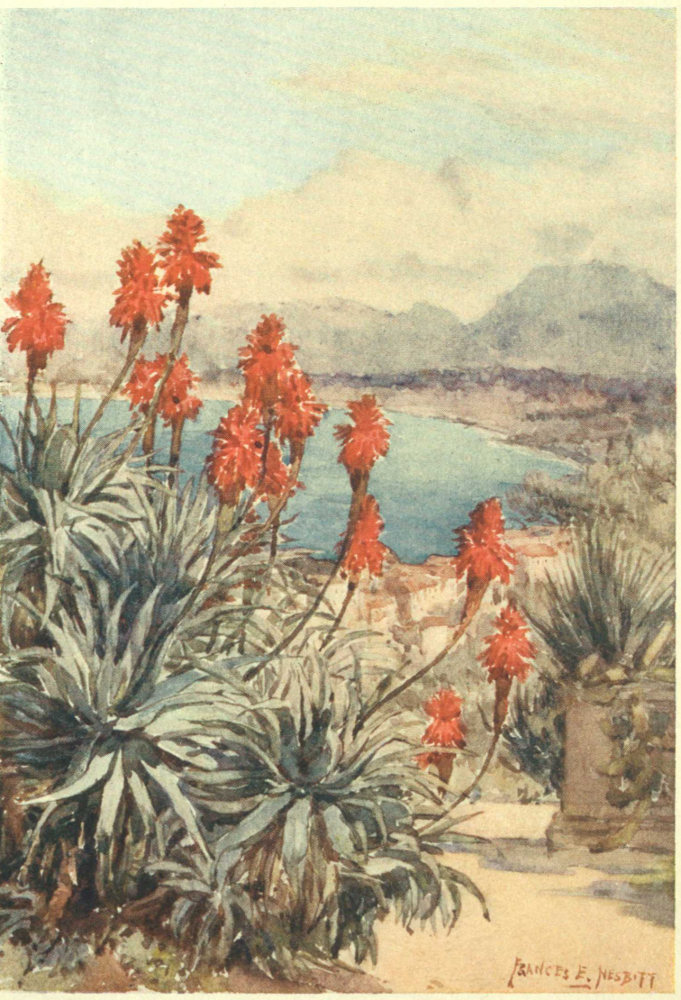
THE RED ALOES
Bitter memories mostly, but redeemed from sadness by the heroism of Christian slaves, and by stories such as that of San Geronimo (or, to give him his right title, the Venerable Geronimo), told by the Spanish chronicler Hædo. He was an Arab child captured by the Spaniards, baptized and brought up by the Vicar-General at Oran. Later on he fell again into the hands of his own people, who made the boy a Mohammedan; but when he grew older he determined to live and work for the Christian faith, so he returned to Oran, became a soldier, and married. Then after ten years, in 1569, he was unfortunately made prisoner by pirates and carried to Algiers. The Mohammedans were furious that one of their creed and race should be a renegade, but no threats or persuasions had any power to move him from his faith. By the Governor’s command, he was buried alive in a block of concrete in the walls of the “Fort des vingt-quatre heures,” his last words being, “I am a Christian, and a Christian I will die.” This happened on the 18th of September 1569, and the story was long looked upon as a legend, but has now been proved to be true by the discovery of the skeleton in 1853, in the very situation where tradition had always placed it. Those who care for such sights may go to the Museum and see a cast of the body, made from the original block in which he was buried; a grim relic to be placed amongst Roman antiquities and inscriptions. But the block itself, that “noble sepulchre” as the old chronicler calls it, has now found a fitting shrine in the Cathedral, where the bones of the saint rest after his stern warfare, his faithfulness unto death. The marble sarcophagus bears the inscription, “Ossa venerabilis servi Dei Geronimo.”
During the winter on the coast of Algeria no one can complain of a deadly monotony of cloudless skies or of a too burning sun. There is no cause to grumble over dazzling light, nor any reason to wish for smoke to veil an ugly object in the landscape, for often the rain does that—indeed, not content with merely veiling, it blots it out entirely for a time, though in the end the sunshine is sure to win. Yet truly the winter of 1903-1904 did give an excuse to the grumblers, who had enough to do in comparing notes on the number of inches in the rainfall, in discussing their own woes, and worrying over gloomy prophecies; for they could count fifty-five consecutive days on which rain had fallen. Then the weather brightened, and the sun came out for a while before the clouds settled down and it all began over again.
This does not mean steady rain, night and day, merely that rain fell at least once in every twenty-four hours—a most unusual state of things. Two or three weeks are to be expected, but this had never occurred before, and for once it seemed reasonable to believe even 38 the oldest inhabitant; for who would choose to come winter after winter to such a scene, though for once in a way it had its interest? For the rain is rain that can be seen and heard. No gentle all-enwrapping mist, when it is hard to tell whether drops fall or no. On the contrary, it waked us at night with a noise that seemed prodigious, torrents of water streaming down roofs and terraces like diminutive waterfalls. Sometimes in the evening whilst sitting cosily over a wood fire there would be a sudden rush for the door to see if anything unwonted was occurring, but with a cry of “Only the weather again!” the little excitement would subside.
Local genius, in the shape of gardeners both French and Arab, put it all down to the moon, which each month appeared sitting on its back. Djegudé as they called it. The moon would not amend her wicked ways, and month after month she continued djegudé, with at times disastrous results.
The harm done was considerable. Roads, houses, bridges and railways were washed away; many people lost their lives; and in the mountain districts there were many landslides. Nothing extraordinary happened in Algiers itself, nothing so sensational as the story which is still told (with how much truth it is difficult to say) of a villa which, while its owners slept, slid down the hillside at least a hundred yards, as they found to their amazement on going out next morning and measuring the track left behind. The villa is standing in its new position to this day, and is not that sufficient proof? Part of the hillside is said to be formed of a sort of sliding clay, and in those parts of Mustapha land is sold for a ridiculously small sum; but houses built there have a habit of sliding a little or collapsing, so that, as a rule, notwithstanding the most scientific building, it is more comfortable and indeed cheaper in the end to pay more and build on the rock.
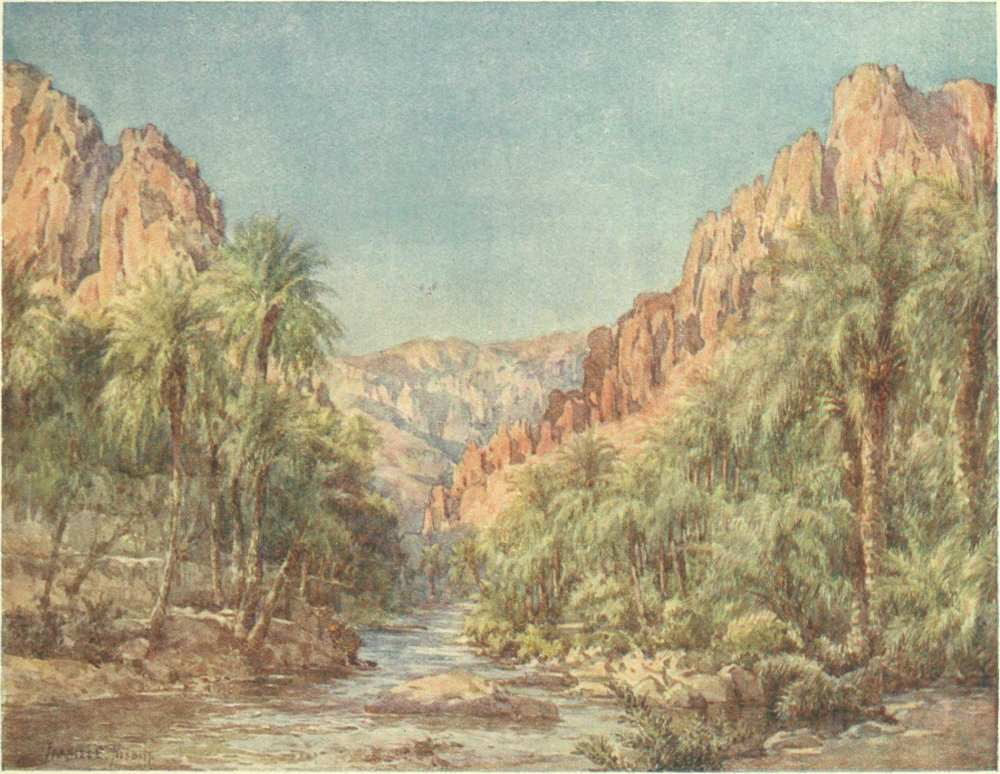
THE GATES OF THE DESERT
In consequence of all this, and of the tales of woe which filled the papers, travellers were solemnly warned by their friends before starting on a railway journey, whether East or West, that though they might not be fated to be carried away by a landslide, yet they would almost certainly be forced to walk miles in the night over precipitous paths (in the scantiest attire, if they added to their folly by going in a sleeping-car), and that they would have to try and sleep in impossible places, with no food of any sort to sustain them. Travelling was actually quite difficult owing to the railway lines being washed away so often, and in some places the damage done was so great that it was more than six weeks before trains could run straight through again. One adventure is worth telling, as it was such a wonderful escape. It happened by daylight; if it can be called daylight in a tunnel. A rock fell and blocked the line, the train was just stopped in time to prevent a serious accident, and the passengers waited two or three hours in the dark. At last they were all moved into another train on the other side, where they established themselves only to find, after three minutes more waiting, that an avalanche had just fallen ahead, so that had they not 40 encountered the first obstacle, they must inevitably have been swept away to the gulf below by the second. This put them in better spirits for a weary scramble to comparative comfort and safety.
However, the final result of the wet has been a phenomenal harvest, with corn and wine in abundance. The visitors may have suffered, but the colonists have gained in the long run. Even the visitors did not have such a bad time, for it was not really winter, but rather a wet, rainy summer, with bursts of warmth and sunshine, brightened by summer flowers and the singing of birds.
Still, on the whole, it seemed wiser to many of us to make a dash for the desert instead of lingering to watch the clouds roll up again and again in a place where the dampness of the soil prevented any advantage being taken of intervening hours of sunshine. Notwithstanding all forebodings, our own journey was as uneventful, dull, and wearisome as so long a journey can easily be. The choice is given you of going by a train which crawls all day, from about seven in the morning till seven at night, and sleeping in a tiny inn at a bleak, bare station, El Guerrah, with no town or village near it, or of doing the same thing at night, and going straight on without a change to your destination. We chose the latter on both our visits, and the first time had an amusing experience. The whole winter in Algiers had been fine, really typical, and the beginning of March was hot,—warm enough to wear summer muslins. Friendly warnings had prepared us to take wraps for the colder atmosphere of the mountain region; but what was our surprise 41 when morning dawned to find a snow landscape all round us and snow falling steadily. When the train stopped at El Guerrah for breakfast, the scene was comical in the extreme. Every one had to get out and wade through three inches of snow and slush to the hotel on the other side of the station. Very few of the passengers had any wraps or umbrellas, and most of them had only the thinnest of shoes, so that it was a damp and shivering company who crowded round the fire, and tried to make the most of bad coffee, poor bread, and impossible butter. Our cloaks and umbrellas were objects of envy, which we in our turn felt towards those provided with suitable boots. Now the inn and breakfast are quite good, but then the whole effect, the open wayside station, the snow-covered plain, the uninteresting desolate hills, the slush and mud, the wet, cold Arabs struggling with the luggage, the few passengers growling and shivering, and exchanging condolences in French, English, German, and Italian, made an odd picture of the joys of travel, only to be thoroughly enjoyed by people with a Mark Tapley spirit. As a final touch, all the small luggage had been deposited in the snow, and remained there for an hour, until the other train came in, when it was hoisted into the carriages, and put on the clean linen-covered seats, with the result that a rapid thaw set in when the foot-warmers arrived, so that a general pushing of bags and hold-alls outside the window for a good scraping was the first consideration, after which the drying of shoes on the burning hot bottles proceeded gaily. For some hours 42 longer the snow kept with us, but as we came towards the desert it disappeared, and Biskra itself was warmer than Algiers.
In 1904, notwithstanding the wet season, and that we started a month earlier, there was no sudden change of temperature. El Guerrah was as bright as it can ever be, for at the best it is a desolate spot, even when later on the plain is carpeted with flowers, orange and gold. There is already a sense of loneliness, of wide spaces unbroken by towns or villages; just a few houses here and there, strung on the single line of railway like a thread; a few stone gourbis, or native huts; then dark Bedawin camps, flocks of sheep and goats, and now and then a horseman or a camel.
For a long time the line skirts a salt lake, which at times lives up to the worst that Pierre Loti says of such places, “Morne, triste et désolé”; at others the surrounding hills seem to grow in dignity, to glow in soft reds and purples, rising straight from the still water, and mirrored with the absolute fidelity of a Norwegian fjord, a haunting stillness over all. Batna is the only town of much importance passed, and already the hills are growing wilder. Gradually they close in and excitement begins to grow, for soon will come the first sight of the desert. There is but little cultivation, the mountain-sides are dry and barren, a few tamarinds grow along the sides of a stream. Suddenly the jagged ridges of high mountains block the way, like a veritable wall. Precipitous crags of warm reddish colour, stern and rugged as the Dolomite Peaks, rise without a touch of green, from low rolling hills which are equally arid in character, or when the gorge itself is reached, straight from the river-bed.
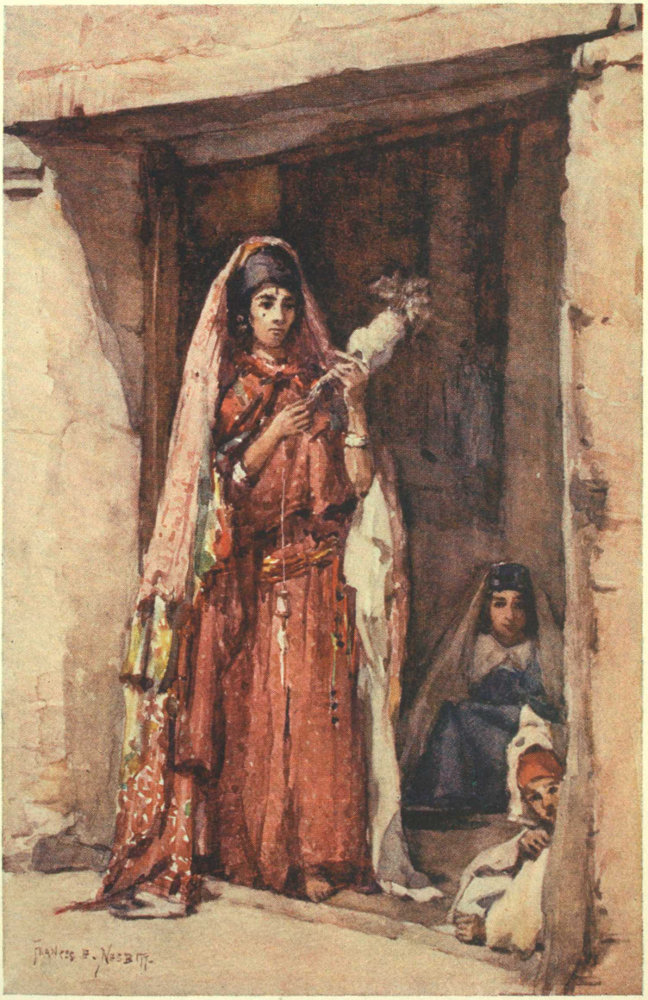
SPINNING
The French Settlement of El Kantara, if such a name can be used for a handful of houses and a station, lies just at the foot of the great wall, at a point where the rift which forms the gorge is scarcely seen. Mountains and rocks tower above the small low houses, crushing into insignificance the attempts at cultivation, the few palms and fruit trees and the treasured vegetable gardens. The inn stands, as the last effort of civilisation, in the face of the great barrier placed between the desert and the Tell.
At the entrance of the gorge, spanning the noisy rushing river, is a Roman bridge, which gives the place its name of El Kantara. It is a single arch, much restored, or rather rebuilt, under the second Napoleon. The Romans had also a fortress here, known as Calcius Herculis, and many traces of their occupation are still found in the district.
The majority of travellers content themselves with admiring as much of the ravine as the three tunnels permit them to see; though it is quite impossible to gain an adequate idea of the grandeur of the Gates of the Desert by peering and craning out of the windows of a train.
The few who know better, or who love less trodden paths, are welcomed by a rush of eager Arab guides as the carriage doors open. Happy the guide who manages to secure a prize! He takes complete possession of his victims and their belongings, puts them into 44 a respectable omnibus worthy of a big town, drives with them, or runs after them, to the little hotel, where he superintends their choice of rooms, and from that moment scarcely allows their steps to stray outside without his sanction.
Vine trellises and a shady tree make the courtyard gay, and brighten the Post Office opposite, whilst beds of violets send up a delicious fragrance to the verandah terrace on the first floor. The house is long and low, with a wing over the stables, reached by an outside staircase; the main building has a large covered terrace, giving a wide, cool shadow. The rooms have windows but no doors, so that every one has to come up the steep staircase to the roof, and then wander round in sociable fashion till he reaches his own room. Out here in the shadow, with dazzling light beyond—light reflected and intensified by the white road and the yellowish rocks—one can sit and watch all the coming and going that make the life of the little colony, or, better still, the caravans that almost ceaselessly pass this way. Strings of camels turn their supercilious faces up as they pace along, their light, soft tread making no sound on the dusty road. They bear heavy loads, wrapped in sacking or camel’s-hair cloth, and carry fodder and corn towards Biskra. Sometimes it is a real caravan with tents and cooking utensils, women and babies as well as men and boys, which swings past with the same rhythmic stride. No longer a study in browns, yellowish greys, and white, but brightened by flashes of colour, the women’s gowns of blue or bright 45 deep red, and the children’s orange and yellow. All walk past with bare feet and stately movement, or perch themselves in an apparently insecure fashion on the top of their goods, and go swaying past into the unknown.
But it is not enough to sit and watch, even though ever and anon new incidents occur. The thirsty come and wind the wheel that brings water from the well. They step into the courtyard without a question, and draw sufficient for their needs; then they smoke and talk. This water is famous for its freshness and purity, qualities usually absent in the desert. The great rocks give shelter from the sun except during the middle of the day, and, what is still more important, from the dreaded sirocco, making it possible for French colonists to live here in comparative comfort even in summer. There is, however, something strange in this life, which sets its impress on their faces—something either in the isolation, the heat, or the absence of amusement, that makes most of them grave and melancholy, taking from them in many cases their natural French vivacity, and giving instead a touch of the more serious, not the laughing side of the Arab character. Not that this is a rule without exceptions, for there are many—notably the man who waits at this very hotel, who is as gay and cheerful a person as it is possible to see. The French talk Arabic, and the Arabs who have dealings with them speak French. As usual there is a school for Arab boys, to teach them useful knowledge, for this is one of the features of the French colonisation; they introduce 46 schools everywhere, supplying French masters, make wonderful roads as well, and bring in post and telegraph, though it is said that Arabic is not a language that lends itself easily to telegraphic form.
The Arab boys are clever and quick, and soon pick up enough to take them far afield. In the summer, as they proudly tell you, it is “too hot” for them in the desert, and they love to migrate to the coast and work in the harbours at Bône or Bougie, and sometimes even cross to France and manage to make a living at Marseilles. Our boy at El Kantara, Mabrouk by name, had done more. He was the one person in the whole place who could speak English—not much, indeed, but just enough to translate for those tourists who were in the unhappy position of knowing no French. He had been taken to England by an Englishman, in charge of some Arab horses, and had spent a whole summer there, working in his master’s house and running errands for what he was pleased to call a “factor boot,” which by his subsequent explanations we discovered to mean a button factory. He was amusingly conceited over his doings and acquirements, showing his photograph taken with “me chum,” a telegraph boy, the trim uniform and the flowing burnous looking thoroughly out of place side by side, in a way that the two grinning faces did not. His ideas on England and its glories were at any rate original, for he was not struck by either wet or cold; he was evidently made much of, and thought our food a thing to talk a great deal about. Some of his statements, such as, that in England every one has breakfast at 6 o’clock and eats a sort of pudding with sugar, are rather on a par with those of a Belgian who once told us that English ladies always breakfasted in bed, though certainly Mabrouk’s theory promises better for an active nation. El Kantara has been a favourite haunt of French artists for the last few years, and many pictures painted here have gained success in the Salon, so, naturally, Mabrouk looked upon himself as a judge of art, and was prepared to show all the best points of view.
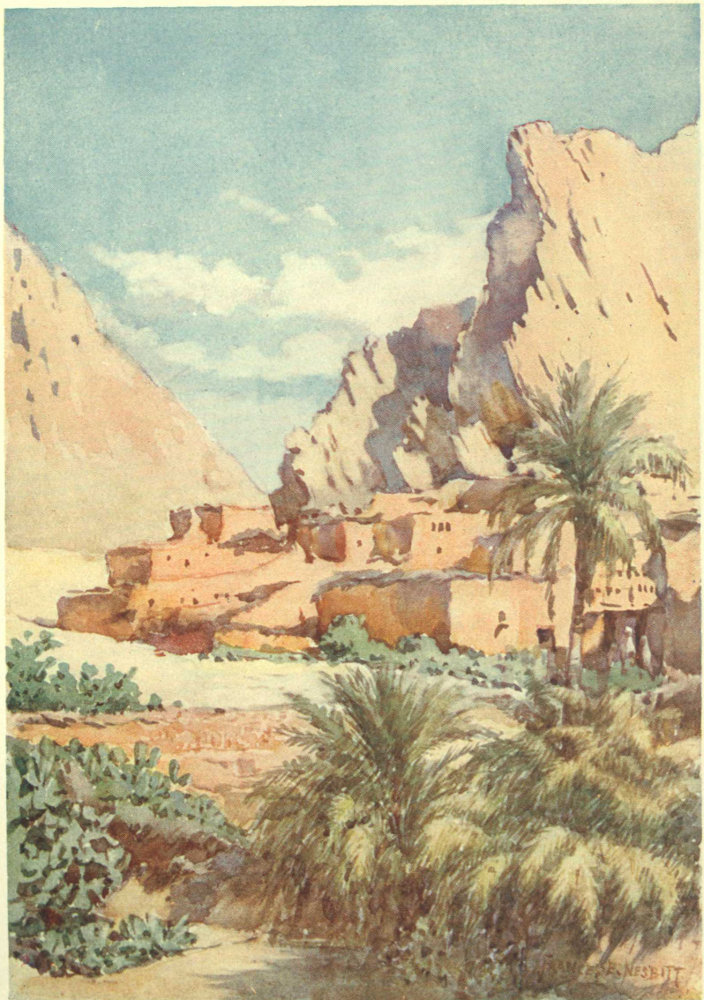
THE RED VILLAGE, EL KANTARA
The first impression on walking through the gorge is one of barren desolation and absolute dryness. Except at noon, when the sun beats down into the ravine, there are strong, cool shadows contrasting with the blaze of light. The gorge itself is narrow, so that there is barely room for the road above and the river beneath. It seems a mere rift in the massive ridge, the perpendicular walls of red rock are cut into fantastic shapes, pinnacles and pillars growing more picturesque in form as the further end is reached. All ideas of desolation are instantly banished by the splendour of the sight that meets the eye, as the sea of sand washes up as it were to another sea of waving green. A long turn of the road leads round to a bridge below, but Mabrouk scrambles down a steep stony path, and with a warning “Mind your headache,” disappears into a steep tunnel, built to drain the road, but evidently looked upon by the Arabs as a short cut made for their convenience, as it saves half a mile or so of dusty highway.
From the bridge, a modern one, the scene is imposing, 48 looking back into the shadows of the gorge where the river leaps foaming over huge rocks, and where groups of cleanly Arabs are busy washing their white garments in its waters.
But if to look back is fine, to look forward is to have the magic charm of an oasis revealed to you. The blue river winds amongst the palms,—thousands upon thousands of palms, which bend, sway, and toss their feathery heads as the breeze passes over them. They look green and soft against the wide sweep of sand and stones, the red and yellow rocks of the huge range behind that stretches east and west, and the other mountain range that bounds the horizon with its purples and blues. Such is the first sight of the desert as it appears to the traveller coming through that majestic gate. But if the gate is looked upon as the entrance to the fertile lands of the plain, then the most beautiful point is just below, amongst the stones and boulders of the river-bed, where the craggy peaks look their best, set in a frame of living green.
Across the bridge the road leads upward over the barren plateau towards the “red” village, the river screened from sight by the palms, and also by an intervening hill, on which stands conspicuously the tomb-mosque of a saint. The red village takes its name from the colour of the soil used in its building, which instead of being of the usual grey dusty hue is bright, almost orange in tint, becoming really red at sunset.
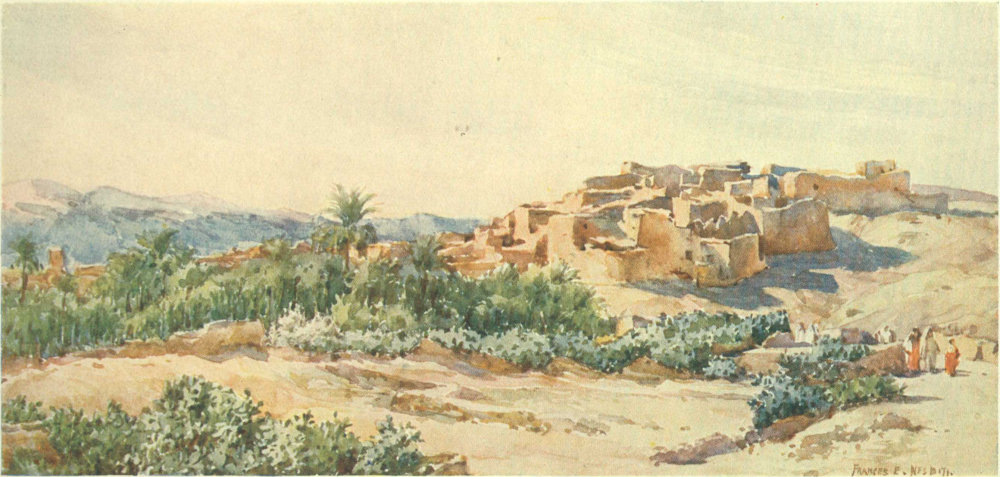
ON THE EDGE OF THE DESERT
In certain lights, the village suggests the ruins of some old castle stretching out upon the waste on the one side, and on the other descending, half-hidden amongst the palms, to the edge of the cliff which overhangs the river, the minaret of the mosque being only just visible above the trees. Mud walls mark out small unfruitful-looking fields, in which little grows except masses of prickly pear, forming thick hedges in every direction. As the men were hard at work, digging and watering, it was evident that much was expected in the future, and these were probably new stretches of land in process of being reclaimed from the desert.
Even within the walls there is the same suggestion of a fortress: the walls are high, and seldom broken by doors; windows in the accepted sense of the word are rare—a few holes in the wall suffice to give air and light. Another peculiar feature is the way some of the houses are built across the streets, forming square, tunnel-like passages exceeding dark after the glare. Mabrouk threaded his way in and out, up and down through the labyrinth of alleys, all rather lonely in the early morning, left to a few old men crouching in sunny corners, and to an old woman or two carrying water; for El Kantara women, though they do work occasionally in the gardens, and do some washing down by the river, seem, as a rule, to keep as quietly within their walls as if they were town-bred. The paths down to the river wind through palm gardens, and are largely at the mercy of the streams used for irrigation. These are turned on and off by the simple method of putting in a stone or a spadeful of earth, and thus diverted into 50 new channels they often swamp the path to such a degree that it is difficult to pick one’s way, the clay becoming very slippery when wet. Every garden has a right to a certain quantity of water each day, which is carefully measured by time. Under the palms grow many fruit trees, notably figs and apricots. Down in the valley, across the artificial watercourse, out on to the dry part of the river-bed, a very wilderness of stones and small oleanders, blindingly white in the sunshine, the village appears in a setting so different that it loses all resemblance to its fellows in the Sahara or in Egypt, and suggests old drawings seen long ago of places in the tropics. Perched on the top of a cliff, the orange tones of the soil repeat themselves in the walls; the huts seem turret-like additions to the natural formation, and form a curious foil for the few well-placed palms and the delicate tints of some apricot trees in blossom; behind this the deeply-fissured ridge stands sharply defined against the sky.
There are three villages, the Red, the White, and the Black, with imposing Arabic names, and each with its special interest, making it quite amusing to poke about and watch the life. If one is too lazy to walk, and yet does not mind a good shaking over rather uneven tracks, and turning a few slightly alarming corners,—alarming, that is, to people unaccustomed to Eastern roads,—it is possible and very pleasant to drive round the oasis, making little detours on foot to see special objects of interest, and particularly to stroll along the edge of the cliff to enjoy the sight of the river and the trees; for there is no lack of palms, considering there are said to be over 90,000 of them.
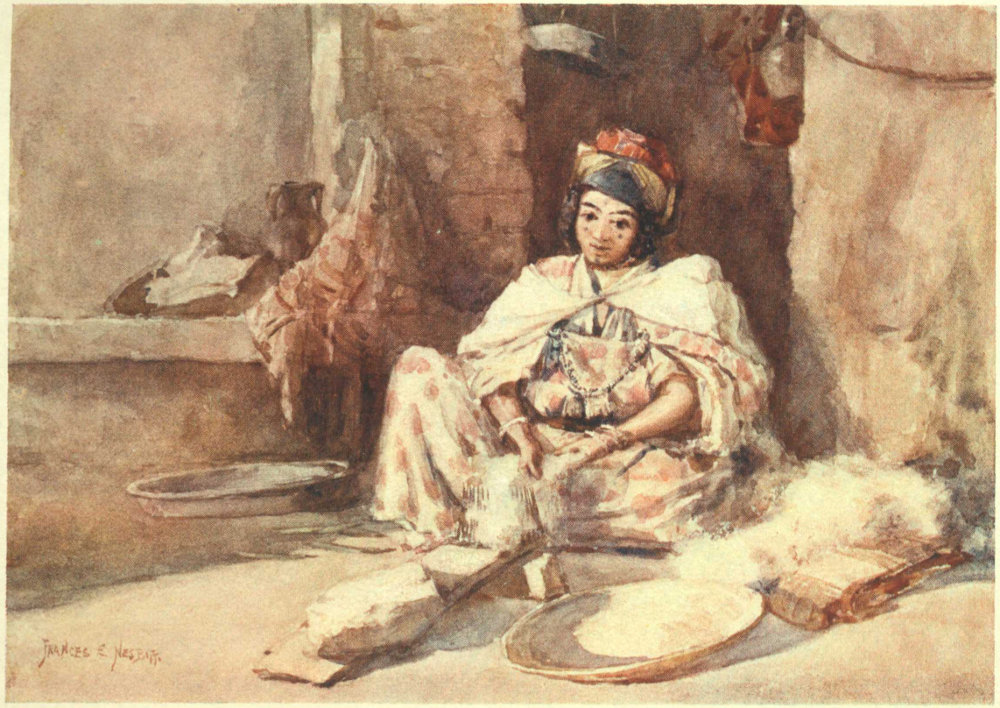
CARDING WOOL
Mabrouk, notwithstanding his travels, gives the oasis a wonderful character. “Every one has enough and is content. The dates are good; fruit, corn, and vegetables are plentiful; and the flocks and herds prosper.” In short, an earthly Paradise! Not a paradise suited to European tastes, perhaps, for who would care to live in a windowless adobe hut, to sleep on a mud floor wrapped in a burnous, or to live for ever on cous-couss and dates, even though it all might be rather fun for a change? The villagers are friendly folk, and give pleasant greetings. The elder men utter a sonorous blessing in Arabic, while the younger say “Bon jour” fervently, and often like a chat to air their French.
No one ever begs, or even looks expectant, though they will walk with you along the road, telling of much that is strange and interesting, and asking innumerable questions. To show how kindly they are to each other and to strangers, any man who was near at the time would stand on guard over me whilst my boy trotted off to get his dinner, holding an umbrella over my head with great care if it was sunny, and would slip away with a ’slama, or good-bye, when the boy returned, not even thinking of a reward.
But it is a different matter when it comes to painting inside one of the huts. To paint a woman! Mabrouk said he would take me to his uncle’s house in the white village because I was “so nice a lady,” but that it 52 would not have been possible had I unfortunately been a man. It is rare to gain an advantage for such a reason, but the privilege was not to be despised, so we started off, my painting things carefully concealed under his burnous. With infinite precaution, to avoid meeting any of the men, and great care in looking out to see that no one observed or followed us, we at last arrived at a rough door in a high wall. He knocked and talked, and at last after some fuss, the capturing of barking dogs and shutting them up, we were admitted, only to be confronted by one of the dreaded men, who absolutely refused to let his young wife, whom he evidently considered very beautiful, sit for me. Happily he relented sufficiently to send for another woman—to my mind far more attractive: tall, slender, and graceful, and wearing her flowing cotton garments as if she were a queen. He then disappeared to the café, and we set to work in the courtyard, a corner of which was swept clean for me. She stood calmly spinning and looking down, intensely interested and amused by my proceedings, which were watched and sometimes interrupted by the various animals who inhabited the place—a horse, a cow, goats, sheep, and some fowls. Having safely disposed of the tyrannical husband, the other woman began to fancy she would like to be painted too, so long negotiations began in Arabic, with the result that we were to come back in the afternoon and she would card wool, as she had been doing all the morning. Going back and coming again were made into a delightful farce by the extreme wariness displayed.
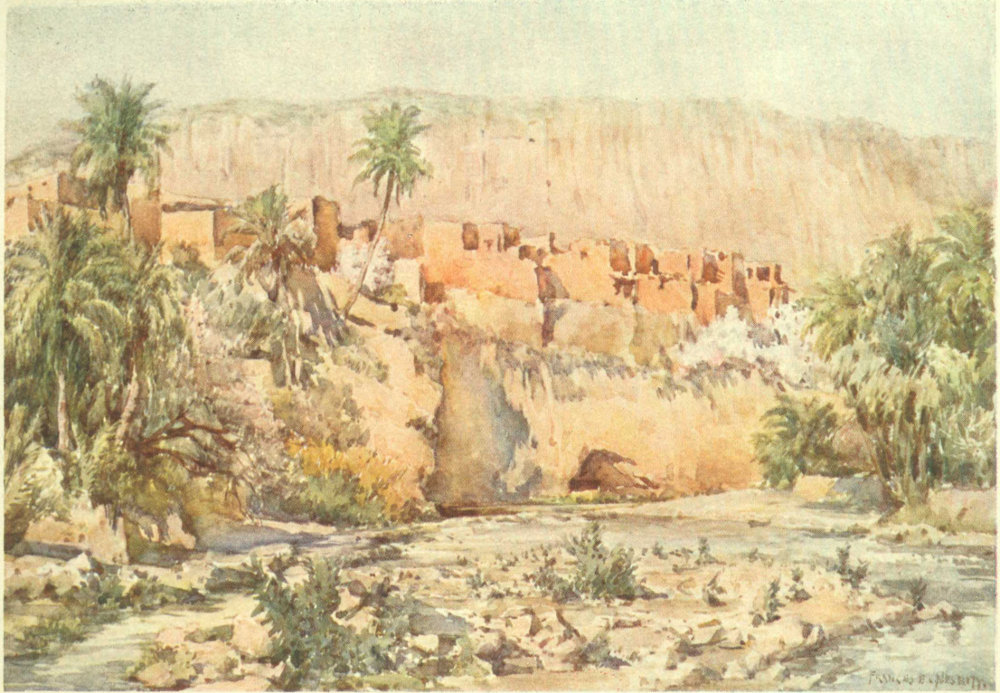
IN THE HEART OF AN OASIS
Nothing exciting happened after all, but there was great pleasure for my boy, at any rate in the exercise of his cleverness. Personally, I was never quite certain whether it was all a game or not. Some artists told me that in other places they had managed to get into the interior of the houses by expending a good bit of money, but then they may not have seen the prettiest wife. Anyhow the younger woman posed in the house, the horse was turned out to make room, the gate was securely barred, and quiet reigned. She was quite short and very fat, with a soft, clear complexion, big eyes, and eyebrows touched up with kohl. She wore a muslin dress wound about her and kept on by a girdle and brooches, and she had plenty of silver ornaments and charms. The elder woman was dressed in printed cotton, obviously from Manchester, but there was nothing crude in the colour, and the floating garments had a most Oriental appearance. There is no furniture in these dwellings,—just a shelf, some hooks, a mill to grind the corn, a few finely-shaped jars and pans, and a good many coloured cloths and burnouses. Being hospitably minded, they offered dried dates, corn and nuts in flat plaited baskets, in the same kindly way that Mabrouk himself would always bring a branch of some special dates for me, insisting on their goodness, “for, see, the date comes off and leaves the stone on the stalk”—to his mind a sure sign of a perfect fruit. The open door let in light and air, but otherwise there was only a small square hole; the roof was supported by two square 54 pillars. The sheep and goats trotted in and out all the time, and so did the chickens, all perfectly happy and at home. Both the women had charming smiles and manners, curious though they were about every detail of my dress and painting. They had not an idea of being frightened by a camera, and posed proudly and willingly. They became a little anxious as the afternoon wore on; so after many farewells, blessings, and good wishes, we slipped away in the same watchful, mysterious fashion as before, but by another route.
On leaving the gorge of El Kantara, the train passes straight out on to the desert, where it runs on a level with the tops of the trees which rise from the oasis below. The line itself, an unpretentious track, without fence or protection of any kind, scarcely shows on the sandy waste. The flocks and herds and the passing Arabs are expected to look out for themselves.
Yet, however unassuming it may be, there is something incongruous in the sight of a railway winding through and round these mountain chains, crossing wide stretches of undulating plain, and taking its commonplace, everyday way into the land of mystery—the Great Sahara.
At first it is hard to realise that this mystery still exists, or that it can be felt by an ordinary mortal. The crowded station differs from others of its kind in this only, that there are, amongst those dignified, white-robed figures, many more than usual whose dark faces show plainly that a train is still an object of wonder if not of dread.
The mystery is not to be found in a hasty glance at the modern town of Biskra, which, new as it is, has a distinct character of its own, quite independent of its setting, or of the numerous villages hidden among the palms.
This does not seem to be caused by its military importance, although this is considerable, as it is the key of the desert, and the soldiers are many who throng its streets. Nor is it the style of the buildings, for neither is this in any wise remarkable. The streets, though fairly wide, are straight, and the houses low—sometimes of only one story. However, the majority have an upper floor, either above an arcade, the lines of which are rough and simple, or with little balconies gay with many-coloured hangings. Naturally all the houses are subject to the reign of whitewash, though not perhaps to the usual extent.
The shady alleys of a well-kept garden form a pleasant walk on the north side of the town, and there is also a pretty gazelles’ garden, bright with mimosa and hibiscus, where a grove overshadows the calm pool of an Oriental fountain.
Probably the distinction of Biskra lies not so much in its outward form, as in its being actually the one place in Algeria where the antagonism between East and West is most clearly seen.
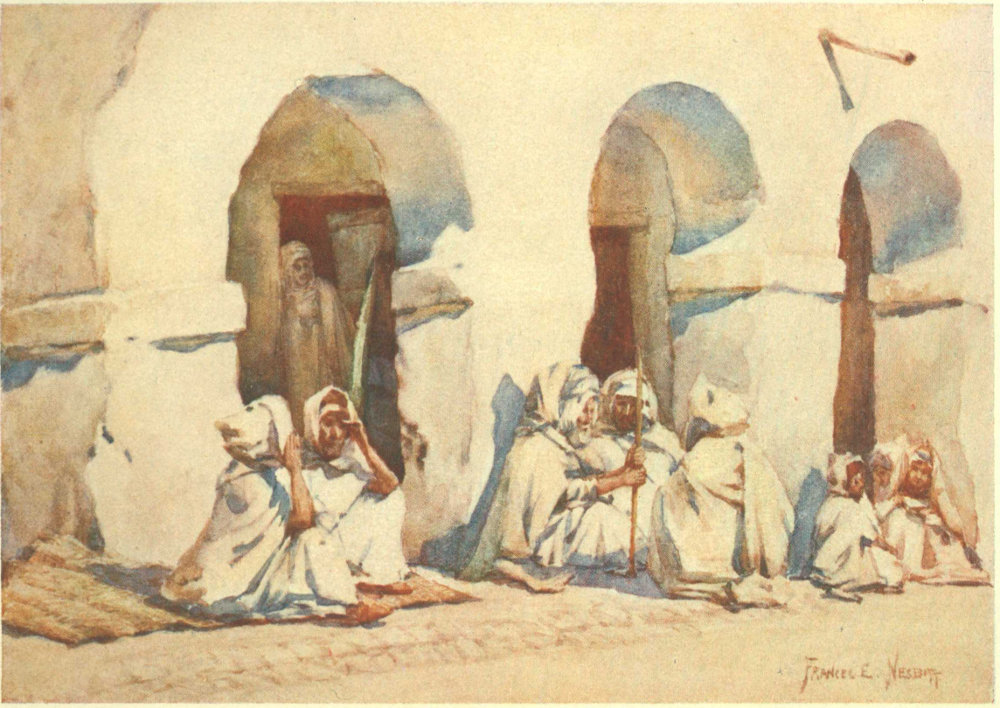
IN THE MARKET-PLACE, BISKRA
The limited size of the town, the absence of any artificial divisions, the lack of contrast between old town and new, for all is new alike, clean and well-kept, the breadth of the few streets, all unite to make an appropriate stage for nondescript characters to play their part. The casino and the hotels are within a stone’s throw of the market-place, which is the centre of native life. Here the wild freedom of the desert with its few needs and absolute simplicity is in touch with the careful and elaborate luxury which the Western world demands even in its moments of rest and play.
The races mingle and confront each other at every turn, and not the races only, but the different types of each race, seen in strangely new guise by sheer force of contrast under the brilliant African sun; for Biskra is the gathering ground of a curious cosmopolitan crowd, an assemblage so varied that it would be hard to name a nation, however insignificant, without its representative. It is the nameless spell cast by the desert on her sons, and on those who move within her borders, that draws hither this motley multitude. But the spell which fascinates has also power to repel. A few come and go finding no beauty, seeing nothing but the monotony of sand, dust, and palms, and are full of complaints, utterly impervious to the glamour that holds so many in thrall.
The impression of variety and contrast felt in the town is repeated and accentuated in the halls of the hotel, when the French officers entertain the Bach Agha, the Caïds, some important sheik, or an officer of the Spahis. Their imposing figures, stately movements, and courteous manners show to great advantage in that gay scene. The soft folds of their white 60 woollen or silken draperies, and the pure colour of the brilliant red or tender blue of their fine cloth burnouses, tell triumphantly against the subdued tints, the frills and fluffiness of the modern gowns, or the stiff black and white garments worn by their fellow-guests. Uniforms are not so becoming to them. The dome-like turban, bound with camel’s-hair or an embroidered scarf, gives a peculiar pose, almost a stoop, to the head, as it is worn with a white silk haïck tucked into a pale blue zouave coat, while in their ordinary flowing robes they look as upright as darts. Stars and orders, or rows of medals on the outer burnous (they often wear three or four), bear witness to what these men have done already, or could do again. In the days when the fortunes of France were low, her dangers and difficulties great, the Bach Agha of the period stood firm with all the tribes under his banner, no small help at that time. It is for past loyalty as well as for present power that the Chief of to-day holds his proud position.
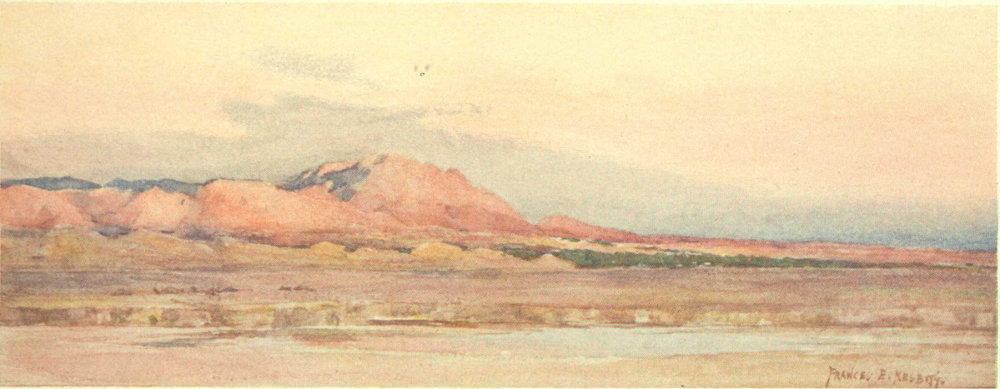
EVENING ON THE SAHARA
All this gaiety, noise, and confused talking, interesting though they are, become wearisome in the end, and then how good it is to escape to the quiet terrace above. The house stands foursquare, built round a quadrangle, or rather a garden of palms. The east terrace over the arcades is delightful all day long, from the moment when the first gleam of dawn shows behind the dark mountains to that other moment, even more beautiful, when the afterglow has faded and the still brilliance of the moon comes in its stead. Flooded with sunshine in the early morning the shadows soon begin to creep across, and it is left a cool refuge in the heat of the day. The outlook has not quite the effect of indefinite space given by the view from the roof or the top of the minaret, but there is a restful breadth as well as much simplicity of line. Across the road, beyond a strip of vegetable garden bordered by palms, lies a broad stretch of sand, very light in colour, which an occasional gleam or touch of blue reveals as the river-bed. Mud banks on the further side form low cliffs, and from them the plain extends to a curious formation of broken mounds and moraine, to end finally in a mountain range.
Monotonous, serene, ever changing yet always the same, the sea itself has not more varying moods. Each passing hour leaves its own impress on that receptive stillness, which is enhanced but not disturbed by every wind that blows and by each light cloud in the sky.
Towards evening, however, all who wish to feel the enchantment of a sunset in the desert, mount to the roof and pace its broad terrace, or climb the minaret to learn somewhat of the immensity of the Sahara. The town lies in a nest of green, in the midst of a vast, barren, and arid plain, which is surrounded by a horseshoe of mountains, lofty in the north, but diminishing by degrees as the spurs run southward. To the south also lies the oasis with its myriad palms. Beyond, nothing but the waste, across which fall the long blue shadows of evening; stretching still further southward, a dead level, broken here and there by dark bands of green or purple, that mark the distant oasis. The 62 horizon disappears in pale amethyst melting into tender blue, and above a delicate blush vanishing in unclouded light. Magnificent sunsets are not to be seen every night even at Biskra; there are evenings of cloud, grey and misty, days when the sun goes down in wrath. More often the fall of day brings cloudless radiance, pure mellowness of light, which dies gradually away, to be followed after an interval by a golden glow behind the western ridge of mountain peaks, blue with the exquisite blue so characteristic of Algeria. The glow deepens to true orange, sometimes to a burning red, and rays of light radiate from the vanished sun, leaving pathways of delicate green between. Our Northern atmosphere has its own beauties of mist and cloud, but we miss this absolute transparent purity. With us the gold loses itself in greys and purples on the horizon; here the colour is crystal clear, and the jewel-like tints vibrate as they pass imperceptibly from the red of the ruby through all tones of topaz, amber, and palest emerald to deepest amethyst. Spellbound in this calm, self dies; there is no place for earthly trouble under this luminous sky. Something of mystery and sadness there is—a feeling of intense loneliness; but over all there broods—unchanging, immutable—a spirit of destiny, telling that what is written is written. To some it seems a spirit of rest and faith; to the Arabs it may have been the source of fatalism, the silence checking the tendency to anxiety and care.
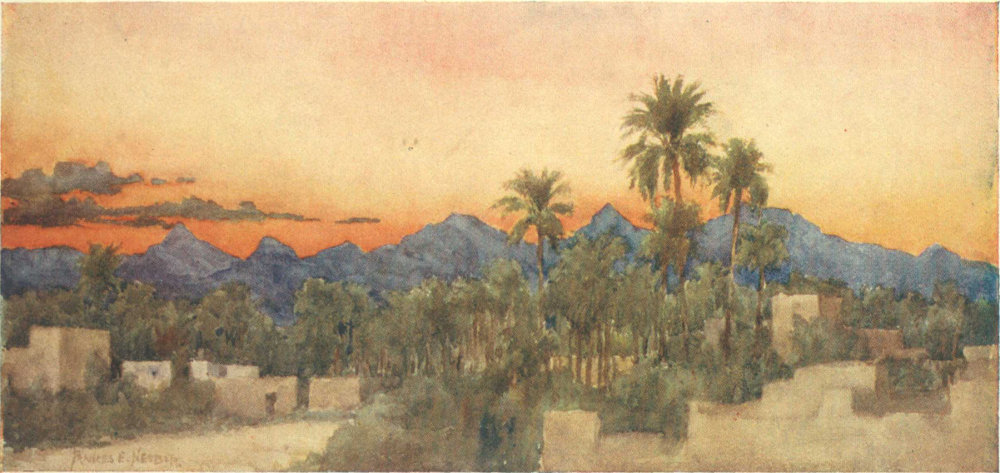
SUNSET
More uncommon than these calm afterglows are those sunsets, when fleecy cloud-masses are piled one above another, purple touched with fire, so that the very gates of heaven seem to open and give a glimpse of the glory beyond.
The glamour of the setting sun and of the afterglow transforms the east as well as the west, staining the mountain-sides a wondrous red, whilst the azure shadow of the earth mounts slowly to veil the roseate sky above. Once a feathery cloud-wreath soared in long sweeping curves from the horizon to the zenith, the strands of gossamer glowing with hues of rose, delicate and opalescent, a cloud of phantasy in a world hardly more real.
The common light of every day works other spells by simpler means. The vibration of subtle colour is gone, and in its stead there is the play of light and shade, or rather of light upon light, for the men of these desert tribes are clad almost entirely in white. The poor wear a white gandourah, a long garment of wool or cotton covered by one or more burnouses. The wealthy bury their garments of richly coloured and embroidered cloth, or even plush, under a multiplicity of silk and woollen robes of the prevailing white. The result is that white has here a value, a range of tone not often seen. Every different texture has its own peculiar tint of ivory, cream, or snow to distinguish each from each, and from that other white of the rough cast walls. And, as if that were not enough, age and dirt lend their aid to the variety already produced by texture and quality.
Touches of colour are rare, and these are given by 64 the scarlet cloak of a Caïd, the blue of the Spahis, or the more barbaric reds and blues worn by a Bedawin woman. But of women there are few about. The throng that fills the market-place consists mainly of men and boys, busy buying and selling, seated on the ground with their wares strewn round them. Piles of oranges and lemons, vegetables of all familiar kinds, great heaps of corn spread on cloths, layers of flat cakes of bread arranged on trays, and most untempting masses of pressed dates. The buyers also squat down to examine their purchases, to talk and gesticulate; for it takes much time and consideration to choose and bargain for even a handful of oranges. There are also stalls such as are seen in any continental town; some full of cheap machine-made goods, others decked with curious articles to meet the village needs. Discs of red leather, carefully worked with colours and glittering with gold, conceal under a flap small mirrors, of which every woman wears one. Fans, like small flags, as gay as the mirrors; baskets, generally saucer-shaped, and of many colours; woven camel’s-hair belts, barbaric harness and saddle-bags, dagger-like knives in sheaths, beads and bracelets, and even stuffed lizards, are temptingly displayed to view. Under the arches are other shops and cafés, and everywhere are men, either sitting idly in the sun, their hoods pulled over their heads, or sleeping huddled up in their burnouses, shapeless as sacks, hardly human at all. The more dignified sit on carpets or matting under the arcades, drinking their coffee quietly, or playing games of draughts or dominoes with keen interest. One or more are always watching if the game is good. Cafés are everywhere, some provided with chairs and small tables, but they are only popular with soldiers, Spahis and the like. The carpeted dais or more humble matting laid down in the road itself, attracts the true Bedawin.
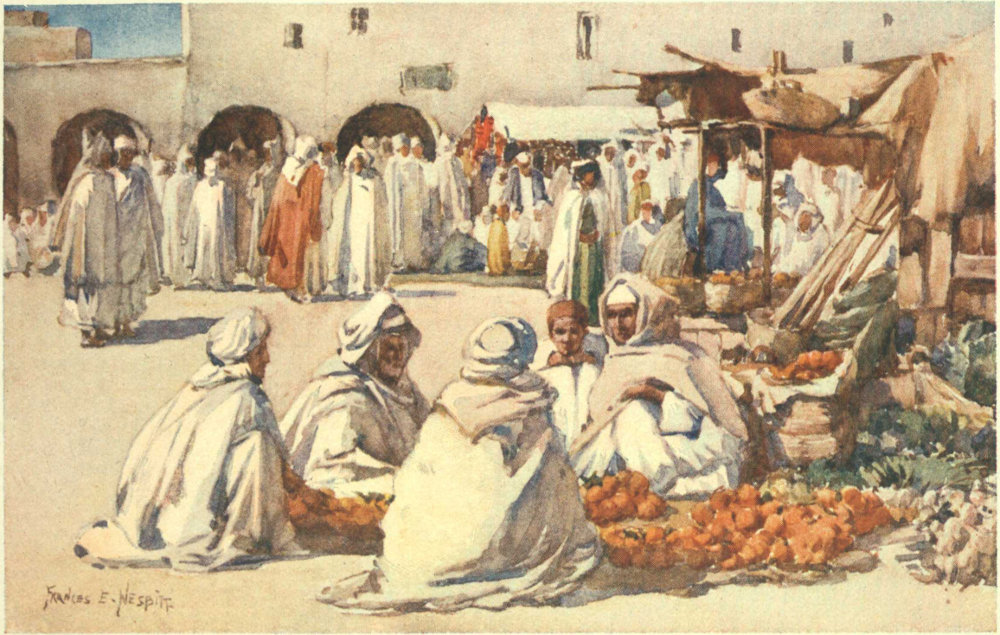
THE FRUIT MARKET, BISKRA
The only part of the town where white does not rule and colour runs riot is the street of the dancing girls. Hangings and draperies cover the green balconies with rainbow hues, whilst the handsome, dark-eyed women, with their heavily painted brows, rival each other in their vividly brilliant silks. Their dress is an odd mixture of the Oriental and European, after the fashion of a comic opera, not at all beautiful but quite effective. Especially so is the head-dress of skilfully knotted silken kerchiefs, heavily interwoven with gold and bound with silver chains, which also encircle the face, the forehead being covered with many coins. The women wear quantities of showy jewellery, but only the chains and ear-rings have any style or character.
Occasionally the streets are gay with flags and banners, as groups of men and children in bright array start on a pilgrimage to some Marabout. All the feasts begin in this way, with much beating of tom-toms and weird music, for as there is rhythm it would be rude to call it noise, as most people do at first. After a time, the sadness and monotony make their own appeal, expressing in another language, hard to understand and perhaps a little vague, the power and feeling of the land.
Now and then a Marabout returns the compliment, 66 and visits the town with two or three followers, bearing banners of red and green, and a bowl to collect alms, accompanied by the inevitable tom-tom. He makes a slow progress through the street, the people hastening to greet him, and often to kiss his hands or the hem of his cloak. Some of these Marabouts are quite sane and dignified, whilst others are half-witted, ragged creatures.
Reading aloud is another practice most popular here. In the daytime a grave old man, book in hand, will take his station at a street corner, and read to a number of men sitting on the ground, and listening with rapt attention to his words. The passers-by stand attentively for a while, and generally end by joining the little circle. In the evening at one of the cafés there will always be a reader, a man with much dramatic power, who draws large audiences, who gather round to hear tales from the Arabian Nights.
This is quite a different affair to the ordinary storyteller, who chants long passages from the life of Mohammed accompanied by the sounds of his own tom-tom. He will sit and play with a cloth spread in front of him, looking like a living idol, and the women working in their tents send little children with offerings of bread or flour tied up in their veils, for veils are still used in the near East for carrying treasures as they were in the days of Ruth. The old man sits impassively droning quietly on, neither heeding nor caring for the groups of children who come and go, staring and listening with wondering eyes. Odd little figures they are in their trailing burnouses or bright-coloured shirts, the boys seeming to have a partiality for yellow and orange, while the boys and girls alike are toddling imitations of their fathers and mothers. Only the smaller boys wear a fez or cap and no turban. Nearly all go barefoot; it is only the very well-to-do who wear yellow slippers, and socks are still more uncommon.
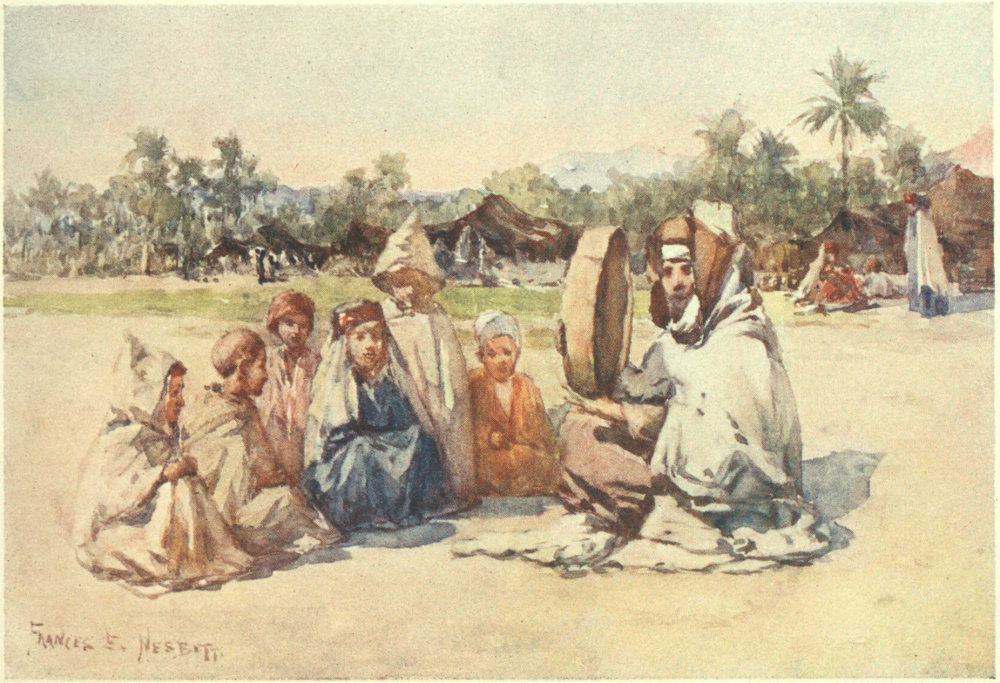
THE STORY-TELLER
If, as often happens, a boy wishes to go to France or England, he will promise anxiously, as if it added greatly to his future usefulness, “If you will take me with you I will wear boots.” It is quite evident that the wearing of boots is in itself considered a proof of progress, and if it is possible to procure a pair however old, or a ragged coat, men and boys alike will add them to their own proper clothes and wear them proudly, quite unaware of the painful effect.
That is one of the trials of Biskra, the degrading of the native character and appearance by the example of the lower class of the Moghrabi, or Westerners, as they call strangers. Of course this happens everywhere, and more’s the pity; but it has gone so far in some of the larger towns like Algiers, that there are few of the old families left, and it is now an almost European city with a mixed population in the lower class. Here the Arabs are only learning, but already they drink and beg, bother and tout as guides, and even gamble. Night after night, wealthy Arabs may be seen in the casino playing “Petits chevaux” with stolid, immovable faces, taking their gains and losses with equal indifference. El Kantara may not be an earthly Paradise, but Biskra is far enough from the age of innocence.
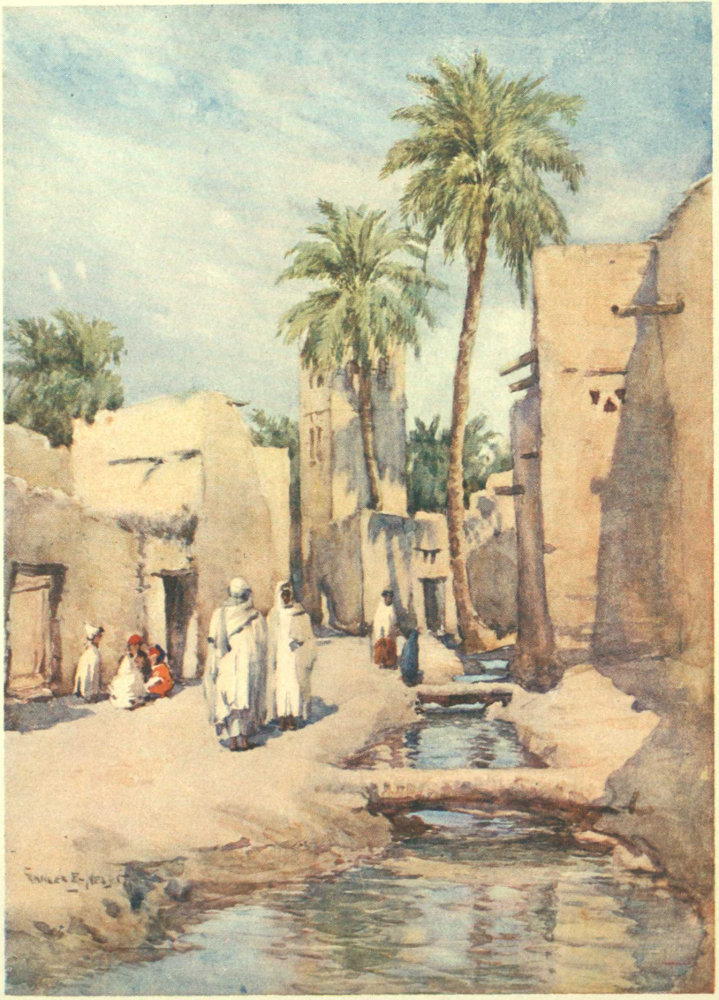
A VILLAGE STREET, BISKRA
Enthusiasm about a desert life comes quickly, so perfect is the view from the roof; but disillusion follows as easily, with the desire to explore in every direction. Difficulties and drawbacks then begin to appear; for this is not Egypt. Here are no rows of big white donkeys and picturesque groups of smiling boys waiting your pleasure. No dromedaries growl and grumble as their riders mount, though now and then some unwary tourists may be seen on pack-camels, fondly imagining that they are learning the qualities of a real ship of the desert. Even horses are rare and hard to get. The concierge smiles and suggests a carriage or a tram, for it is not given to every one to enjoy long trudges over rough tracks or on dusty paths. But a tram! Could anything be more unromantic? Even a carriage hardly sounds better for a voyage of discovery.
Finally, having decided that there is no help for it, and that romance must be quite independent of such details, some expedition is arranged, only to end perhaps 72 in bitter disappointment. Instead of being greeted in the morning by the expected sunshine, there is a downpour of rain, which makes the roads a sea of mud and quite impassable for days, leaving the roof the one dry place available for a walk. For though the sun can broil and scorch, there is no lack of rain; and rain in the Sahara is almost more out of place than a tram, and certainly far more depressing. The mud is of a depth and stickiness quite unsurpassed, and those who dare its dangers find progress slow, as they slide back nearly as much as they advance.
Another drawback is wind. Icy wind from the snow mountains, or hot wind with sand-storms from the south. In a good season there is said to be wind three days a week, but in a bad season, or during the races, it blows daily.
Biskra races are the great excitement of the place and of Algeria, and it is a superstition (founded on fact) that whatever date is chosen for the great event, it is sure to prove the windiest week in the year. This sounds nothing to the unsophisticated, but to those who know, it means misery.
A day may open in peace; the sun shines; there is not a breath of air; it is warm—nay, hot. Ideal weather. Breakfast is hurried through; such a day is not to be wasted, an early start is made, and for the first hour or two all goes well. Then comes a little shivery chill; the sun is no longer as warm; the palms rustle. In a few minutes the wind blows hard. Dust rises in clouds, and everything disappears under that 73 thick veil. The Arabs shrink and cower in corners, their hoods over their faces covering mouth and nose. Such a wind can last all day, the sun just visible as in a London fog, only white not red. In fact, the dust hangs in the air like mist, the mountains vanish completely, and nearer objects are only dimly visible. It is dense, luminous, horrible. In less than a minute everything is lost under layers of dust. Dust drifts through closed doors and windows, and makes little heaps as snow does in a blizzard.
On ordinary windy days the dust is very trying, and the dread of wind spoils many an exquisite day, as the wicked habit it has of rising morning after morning before 11 o’clock stops many pleasant plans. Still, when compared with memories of fog and rain, cold and slush, on the other side of the Mediterranean, the gain is so great that the sand-storm is almost agreeable.
The morning freshness has a quality in the desert unfelt elsewhere—a purity, a crispness, a delicious sense of invigoration that brings thoughts of the Engadine in a fine August.
The first impulse is to go south, to leave the town behind, and even the village nègre as the French call it, though few are the blacks who dwell there, to go forth beyond the monastery which Cardinal Lavigerie founded for soldier-monks, Frères du Sahara, who were to fight, preach, and abolish slavery, but who seem to have failed in their mission, as their home is now a hospital. Cardinal Lavigerie is held in special honour as is his 74 due, and his statue stands looking towards the desert he loved, in an open space near the gazelles’ garden.
Even the Chateau Landon, the show garden of the oasis, must be left behind, though already, on the path beneath the walls, the call of the desert is felt. Nothing intervenes; the river-bed, wide and dry, is at your feet. The river itself, an insignificant stream, is lost in the expanse of sand and stones bounded by low cliffs of ochre-tinted soil, from which rises an oasis bright and fresh, but small. Beyond, nothing but infinite space, till sky and desert meet in a blue so soft that the French soldiers on their first coming cried, “The sea! the sea!”
Further on one can wander in and out on mud paths under the palms, listening to the soft murmur of running water from the rills, which carry life and refreshing moisture through the shady glades. From this welcome shade the river-bed looks white and dazzling, and whiter still the Koubba of a favourite Marabout planted in its midst.
All is light yet full of colour; the very mountains of the Aures are radiant with rose, and the long blue shadows are full of light. Arabs come from under the palms, and find their way to the river to wash and stamp on their clothes in the bright sunshine. A man and two small boys settle down beside a little stream under the trees with a burnous, which they scrub all over with soap, taking infinite pains to see that every corner has its share. Then they trample on it, and knead it with their feet till it is clean as clean can be; then they stretch and pull it into shape ere they spread it out to dry in the sun, whilst they enjoy a rest after their labour. Women and children come also: the women with bundles on their heads; the children moving quickly, mere flashes of colour.
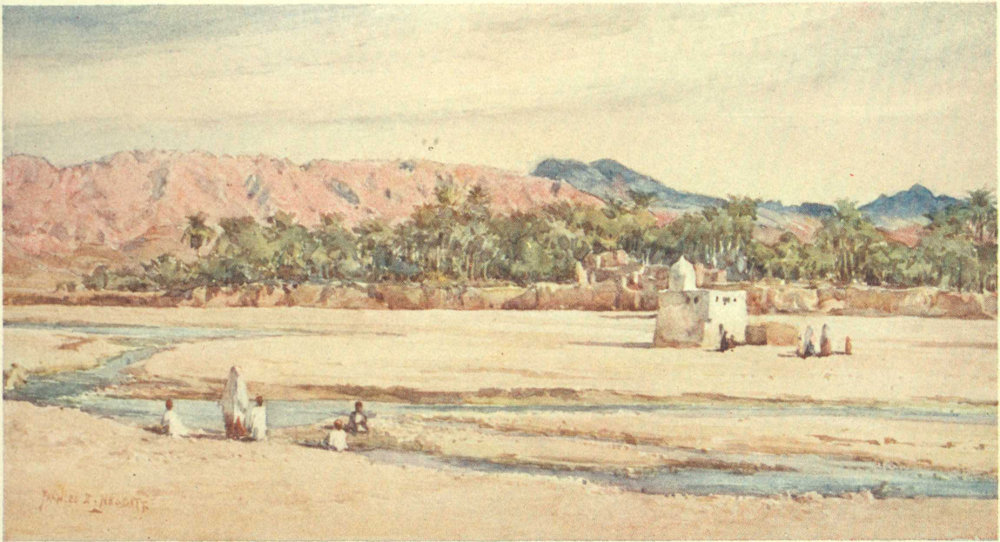
A RIVER OF THE SAHARA
All the paths through the oasis and its seven villages have charm, though not so much character as those of El Kantara. Yet any mud dwellings shaded by palms are sure to be quaint, and here there are little balconies and curious windows of pierced holes arranged to form primitive rose windows or triangles, while the decoration on the minarets is almost elaborate. The palms, casting their flickering shadows on the warm earth; the pools, and the running water that threads a shining way through all the gardens, and mirrors every leaf in its calm shallows; the vivid green of the grass and growing crops (barley is already in the ear); the blossom lingering on the fruit trees; the tender colour of the first young leaves of the fig;—all combine, with the mud walls that bound each property, to make of every moving figure a living picture.
The light falls with bewildering brilliance on the white garments of the solemn, stately men as they emerge from the cool, green shade into the golden sunlight. Patriarchs ride slowly by; boys in ragged burnouses and slender, bare legs, pipe to herds of energetic black goats. Camels and donkeys with nothing visible but their legs, so large are their burdens of palm branches or fodder, brush the walls on either side as they pass along. Men with similar loads, or carrying bunches of greens and 76 carrots from market, watch groups of tiny children, who squat in the dust keen on some mysterious game. Women with unveiled faces and waving draperies of vivid colour trail them slowly past, accompanied by a pleasant jingle of silver anklets, chains and charms. They carry their babies wrapped in their veils, low down on their backs, in a clever fashion, though now and then the queer mites, in their big hoods, looking like gnomes, are perched on their mother’s shoulders.
The palm gardens, of which their owners are extremely proud, are often entered by the simple method of pushing a palm log aside and creeping through a hole in the wall. Wealth here is counted in palms, and every tree is taxed. To encourage the French colonists only a tax of five per cent is levied on their produce, while the Arabs pay double, which the latter naturally think very hard. Palms exact a great deal of attention. For them exist all the schemes of irrigation, the artesian wells, the sakkias, the endless opening and closing of the channels of the watercourses; for a palm flourishes only when it stands with its feet in water and its head in the fires of heaven. The want of scorching sun is one reason that dates do not ripen on the coast, though the trees look healthy enough.
In the time of blossom, human fingers with infinite care assist the insects in fertilising the female flowers with pollen shaken from the ivory chalices of the male. These flowers begin life in a sheath, which opens to disclose a cascade or spray of slender stalks, thickly sprinkled with pure carved ivory flowerets, which are soon followed by the tiny growing dates.
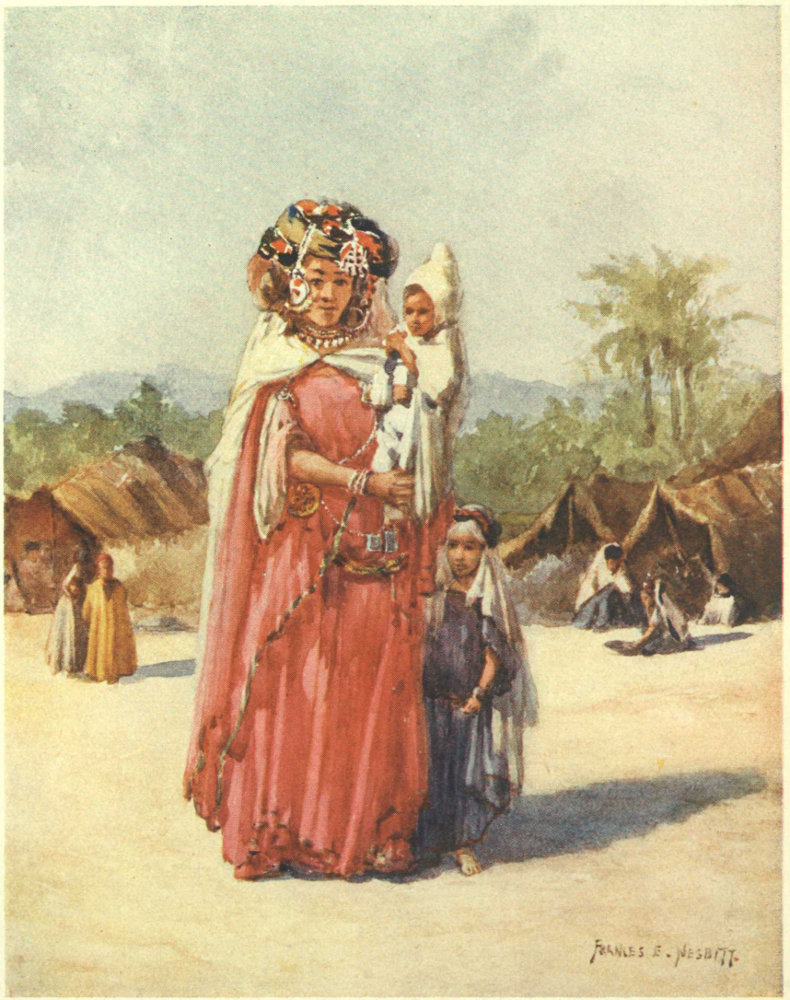
A BISKRA WOMAN
A few vegetables and a little corn is all that grows under the trees, which often shade picturesque family groups camping for the day under shelter-huts built of boughs and thatched with palm leaves. The mother in all her glory tends the fire, watches the steaming pot of cous-couss for the mid-day meal, or flits like a gorgeous butterfly through the green mazes after her straying babies. Her dress is the most graceful of all the native costumes in this part of the world. It is nothing but a long piece of very wide, soft muslin, or printed cotton, of deep red, rose colour edged with green, or fine dark blue; but it is wound round so cleverly that a girdle of many colours at the hips and a couple of handsome silver fibulæ at the neck are sufficient not only to keep it on, but to form hanging sleeves and a multiplicity of charming folds. The head-dress is wonderful. The hair is plaited and braided with black wool, and arranged squarely on either side of the small face, black silk kerchiefs are woven in and out and over this mass, twined with silver chains, and brightened by touches of scarlet flowers and wool. Just over the forehead hangs a large silver charm, the sacred hand of Fathma. The ear-rings, as large as bracelets, are fastened through the top of the ear, and are so heavy that they have to be supported by chains or threads attached to the hair. Round their necks they wear one or two necklaces of coral, amber, or gold beads, and tiny silver hands. They deck themselves also with many bracelets and 78 anklets. These treasures are part of the wedding portion, and represent all their worldly wealth. Their white veils are twisted into the head-dress behind, and fall in long folds to the ground, but are hardly ever used to cover the face; for these Biskris, and the dwellers in El Kantara, are descendants of the original inhabitants of the country, the Berbers. They belong to the same race as the tribes of Kabylia and of the Aures, and their ways, characters, and language are not those of the Arabs who invaded their land and drove most of them back into their mountain strongholds. They are the cause of many theories and much speculation. Early writers consider them remnants of Christian Africa, Romans and Vandals, and say in proof of their theory that the Kabyles still keep Sunday as their day of prayer, and that the cross which all the women bear tattooed on their foreheads between their eyebrows, and many of the men on their arms, or the palms of their hands, are relics of the days when crosses were worn as tokens, and exempted their wearers from some taxes. The Touaregs also wear the cross and use it for the form of their saddles. Modern knowledge or scepticism scorns these ideas as pretty fables, and considers that the cross in some form enters into all schemes of primitive decoration, and interests itself far more in the fair complexion of the race, the tendency to light hair and grey or blue eyes, and above all in the methods of government which point to some Germanic origin. At any rate the women in all the Berber tribes have a better position, with far more consideration and power, than in any place where Arab blood prevails. These tribes also distinguish themselves by their love of a settled home and by being both clever and hardworking.
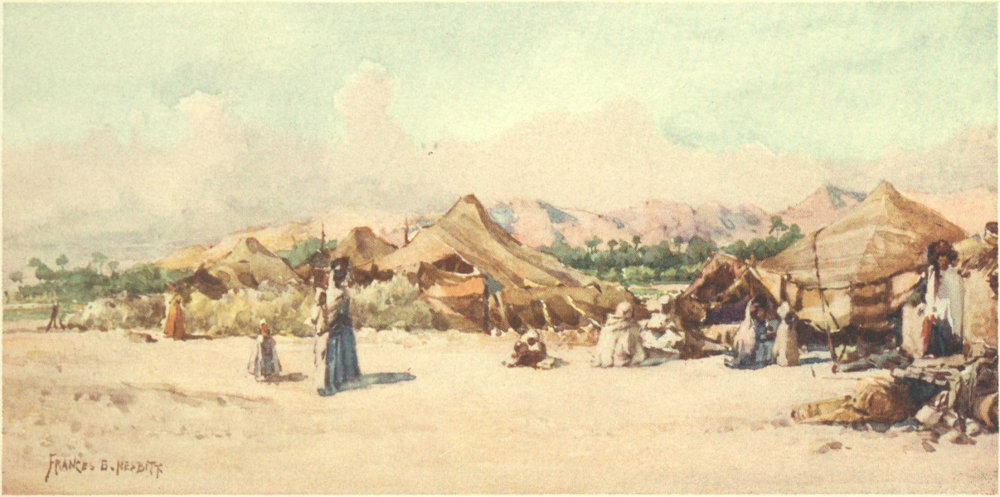
A NOMAD CAMP
Widows we were told have the special privilege of feeding their sheep wherever they like. The animals may browse on shrubs and trees, vegetables, corn or fruit, without let or hindrance from their neighbours. Consequently a widow’s lamb is fat and well-liking while larger flocks starve, and on market day it will sell for some six times the usual price.
Nomad or rather semi-nomad tribes abound in the district, their low tents of striped camel’s-hair cloth showing as dark patches on the desert or under the trees. They often build a few walls, rough fences and ovens, and settle almost permanently in one place, till the grass is worn away in front of their tents. The fields they cultivate stand high with corn and clover, to feed the camels tethered near the camp or the herds of goats that wander in and out at will. These nomads dress like the other inhabitants of Biskra, but the women wear more blue and less red, and have not quite the same air of being always in full dress. The tents are so low that the men dwarf them utterly, and even the women, short as they are, must stoop to enter. This matters little, as the life of the community is passed in the open. All day long the grinding of the mill may be heard, as the women take it in turns to work together sitting in the dust. The cooking of the cous-couss is done in a vessel hung on a tripod in true picnic fashion—furniture there is none. A few carpets 80 and hangings, the necessary pots and pans, and the mill are all they need, so it is easy enough to strike tents and march wherever the fancy moves them. A pretty sight it is to see one of these caravans on the desert or amongst the dunes, as it comes slowly out of the distance, giving as it moves along just the touch of life and colour that was needed by the scene. The sand-dunes themselves are beautiful with a strange beauty that harmonises with the wild, free life. The shifting sands rise and fall in a succession of hills and hollows covered with yellow, green, and grey scrub, and thousands of bright yellow flowers, for all the world like the Lincolnshire sand-hills or Saunton burrows; only that here the dunes are immense, and stretch out not to the sea, for that has gone, but to the mountains of the Aures, or vanish only in the vast spaces of the Sahara.
On the way to Sidi Okba, where caravans are frequent, we met a sad little procession—a few men riding, one or two on foot, leading a camel with the body of a man swathed and bound like a mummy, and lying across the saddle. They came slowly, solemnly, out of the mysterious distance and disappeared into it again. As a soul passes so passed they.
The shrine of Sidi Okba is well worth seeing. The drive across the desert alone repays the weariness caused by jolting and shaking on a stony road. A real road it is, and not a bad one, considering that it has to pass over the river-bed and some very rough ground. However, it is no satisfactory desert, though flat and desolate enough, for everywhere there is green scrub sufficient to feed camels and the goats of the nomads. Here is neither a trackless wild nor a waterless waste, though the water has the good taste to hide itself under the ground or in the oases. The goal is visible from the start as a dim purple line, yet there is no lack of interest on the way, for the Djebel Ahmar-Kreddou and the surrounding hills assume new forms as mile after mile is left behind, and the colour comes and goes, waxes and wanes.
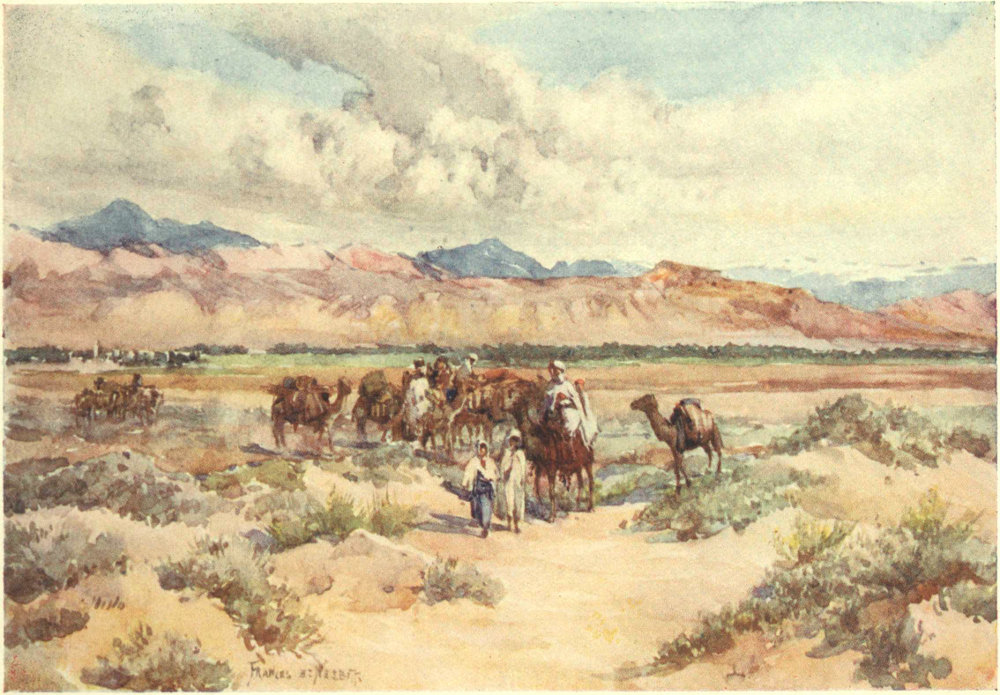
CARAVAN ON THE SAHARA
Though it is the religious capital of the Ziban and a sacred place, the village of Sidi Okba is built, like its neighbours, of sun-dried mud. But it owns a real bazaar and a large market-place. The bazaar is winding and irregular, shaded here and there by coarse canvas, or matting, stretched on ropes and bars of wood. Canvas of every shade of brown and ochre hangs flapping idly in the breeze over the square, cavernous shops, where, amongst strange, untempting wares, the owners sit motionless, only their eyes awake and on the watch. In other shops men work tirelessly at many trades. Colour exists only in the vividly blue sky, in the palms, and in a few scarlet handkerchiefs. The bazaar and the crowds who surge through it harmonise in tone. The nomads, with wild, dark faces and bare legs, shout as they bargain, unconscious alike of the din and turmoil and of their own value from a picturesque standpoint. Here are no Europeans, no odd contrasts; all is true, unspoilt. Men of the desert swarm in hundreds, but scarcely a woman is to be seen except in the market-place, where, in anticipation of a wedding to 82 take place at night, rows of them sit near a wall, veiled, and listening to passionate, triumphant music, whilst their lords stroll about, or sit in groups as far from them as possible.
The great warrior Sidi Okba, who, after conquering Africa from Egypt to Tangiers, was killed in A.D. 682 by the Berbers, near Tehouda, now in ruins, a little to the north, was buried by his followers in this place. His tomb-mosque, the most ancient in Algeria, is quaintly impressive. It is built of short columns, roughly made and crudely painted, and its chief ornament is a door from Tobna, which is curious both in carving and in colour. The shrine is plain, and the Tsabout or sarcophagus is covered by bright silks embroidered with texts in Arabic. On one pillar is a simple inscription, worthy of so great a man, written in Cufic characters: Hada Kobr Okba ibn Nafê rhamah Allah. (“This is the tomb of Okba, son of Nafê. May God have mercy upon him.”)
Round the tomb and in the mosque men are always praying, and from all the little chambers, nooks, and corners comes the drone of voices; for they are full of scholars old and young, who sit in groups round their teachers, each with a worn board, on which is written a portion of the Koran, grasped in his hands. As they learn, they bend and rock and recite the lesson in sing-song tones. All Arab schools betray their whereabouts by this constant hum as of a gigantic hive.
Most of the neighbouring oases attract in different ways, and there are many favourite points of view, such as the Col de Sfa, which reveal new aspects of the Sahara and the Aures.
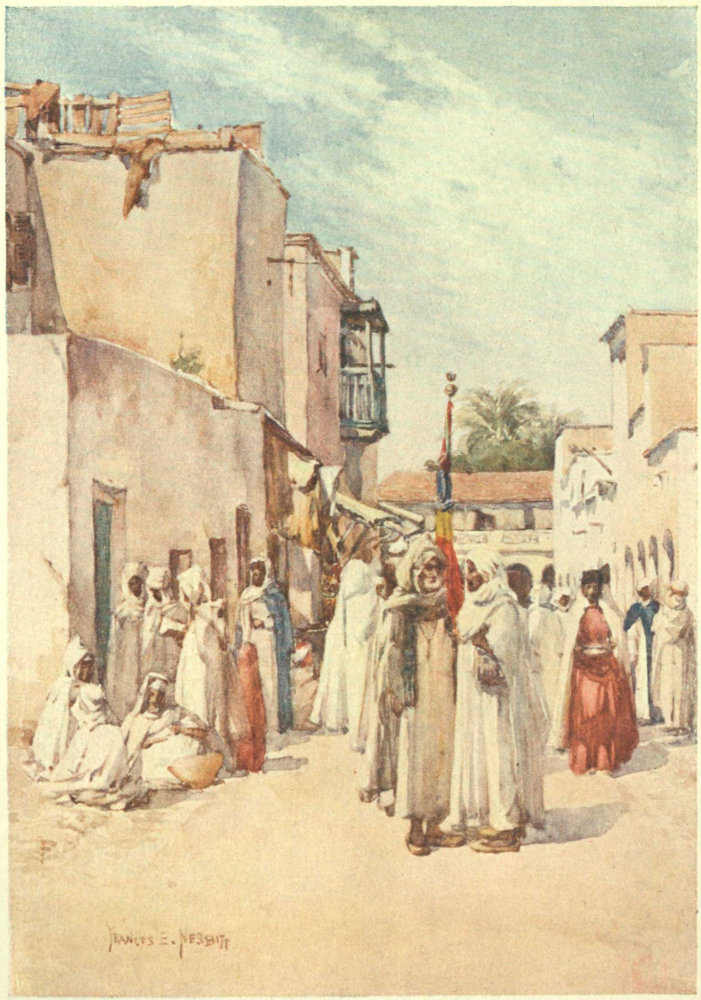
THE BEGGING MARABOUT
The Arabs resort to Hammam Salahin, the Bath of the Saints, a solitary building, with the usual arcades and whitewash covering the hot springs, a scene of utter desolation, volcanic and grim. Even the two small clear lakes add no touch of beauty to the salt, sulphurous waste. But it is amusing to see the women, who bring great bundles on their heads, and who, after the ceremonies of the bath, put on clean garments, and then proceed to wash all sorts of brilliant rugs and draperies in the hot water as it streams away, making the wilderness gay by turning it into a drying-ground.
But, after all, the true barbaric fascination of desert life is shown in the most striking fashion during the races. The tribes come in from far and near, all in their gala dress, and the fêtes begin, continue, and end with processions and fantasias.
Strange processions, typically Eastern, a mixture of splendour and squalor, pass and repass in the streets. The Bach Agha in the place of honour, and the Caïds, glorious in all their bravery of red and white, glittering with gold embroidery and sparkling with orders and medals, ride beautiful horses, which step proudly under heavy trappings of gold. The details are as good as the effect; the cloth and silk are of the finest, the high boots of soft red leather.
The Sheikhs are almost as splendid, and the Spahis in their white and blue both ride and look well. Each Caïd is surrounded by his chiefs and Spahis bearing the 84 banners of the tribe, and after these magnificent figures follows a motley crew, men and horses alike gaunt and poor-looking. They do their best to look imposing, with guns and swords and fierce looks, and the horses are decorated with long, trailing saddle-cloths of gorgeous, faded silks, which almost sweep the ground, as they move along. As they pass the centuries fade away. This seems no pageant of the present day, but a troop of freebooters starting on a foray in the Middle Ages.
The first event of the races is the ride or drive in the early morning through the villages of the oasis, where every roof is crowded with women and children gay as a bed of Iceland poppies, past the ruins of old Biskra, straight along the great desert road, to see the finish of the long-distance camel race.
The Meharis (riding dromedaries) had started from Tougourt 140 miles to the south, and were expected to appear about nine o’clock. Every vehicle and every camera in Biskra was there, and crowds were already waiting and watching, all eyes turned to the distant south, though the shimmering heat made it difficult to see far. At last in the distance appeared specks that moved and grew, and in a moment the waiting was over and the Meharis had come. One after another, with long, easy strides, they swept past, their riders still urging them forward with voice and hand. No appearance of fatigue, no hint of the distance covered in an incredibly short time, were apparent in the bearing of either the Spahis or their untiring steeds. Fit messengers they are to carry important tidings in time of need, as the French officers showed by their keen interest in the race.
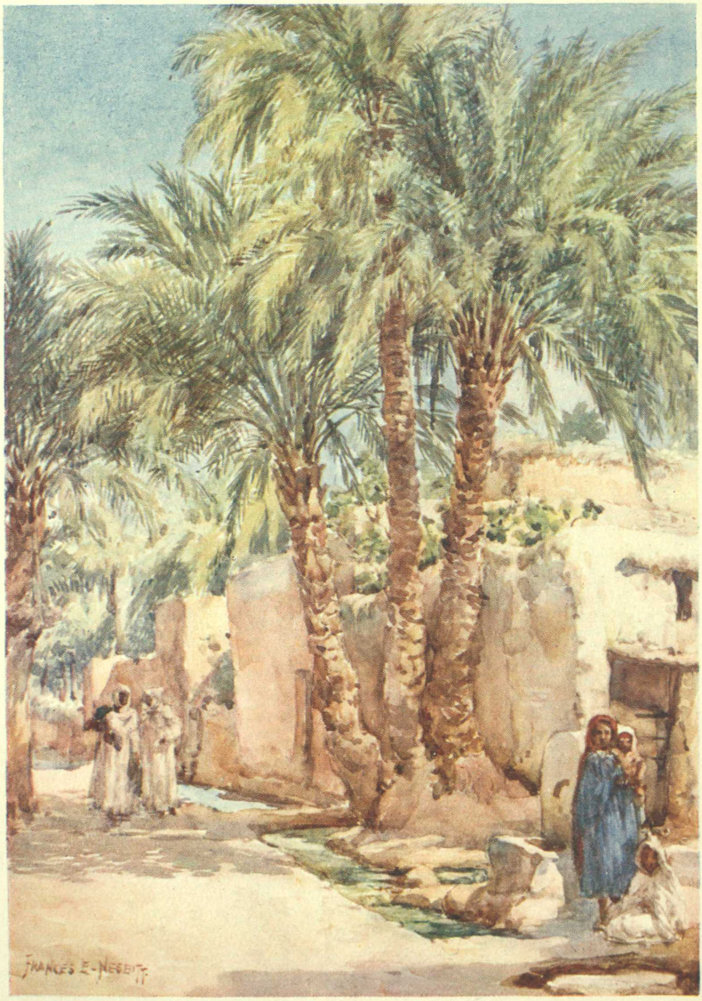
THE PALM VILLAGE
The race-course at Biskra is as unusual in its frame of palms as the sports that take place there. Nothing could be more picturesque than the Bach Agha’s procession as it winds along under the palms; nor more beautiful than the groups into which in half-military fashion it breaks to watch the races. The crowds, who in their gala array encircle the course, vie with the horsemen in decorative effect, whilst the dancing girls outdo them all in sheer splendour of texture and tint as they flutter round their tents.
Men of distant tribes in strange garb are also here: some wearing head-dresses of waving plumes, like huge busbys; another, one of the dreaded Touaregs, in dark robes with dark turban, veiled, like a woman, in black or intensely dark blue. These are masked men, fierce and mysterious as the sun they contend with and the desert they rule.
The races are good and the Arab horses fine, but the excitement of novelty comes in with the fantasias. These fantasias are mock fights or powder play; but there is a method, a savage fierceness, a fiendish glee in their performance that gives an uncomfortable thrill, and a feeling that any trifle might turn play to earnest, and a knowledge that if it did, the performers would exult more than ever.
The Mozabites fight on foot. They are small, wiry men, wearing full gandourahs as short as kilts, with 86 curious fringes and tassels of camel’s-hair hanging from their broad belts. They bind their haïcks loosely, and arrange them to cover the lower part of their faces, the usual precaution in their own torrid country far to the south, beyond Laghouat. A warlike tribe, one of the last to submit to France, they still cling to their independence in religious matters, and are called in consequence Khammes, or the fifth, because they are outside the four recognised orders of Mohammedanism. Industrious and hard-working, they travel far, and are often shopkeepers in the large towns, but, for all that, to them gunpowder is everything. Government allows a certain amount yearly per man, and this can only be obtained by order. All the same, great quantities are made in secret all over the country, and the hiding-places where work is done are rarely discovered, except when, owing to unscientific methods, an explosion takes place, killing several men. This is of constant occurrence, it is said, but no one minds.
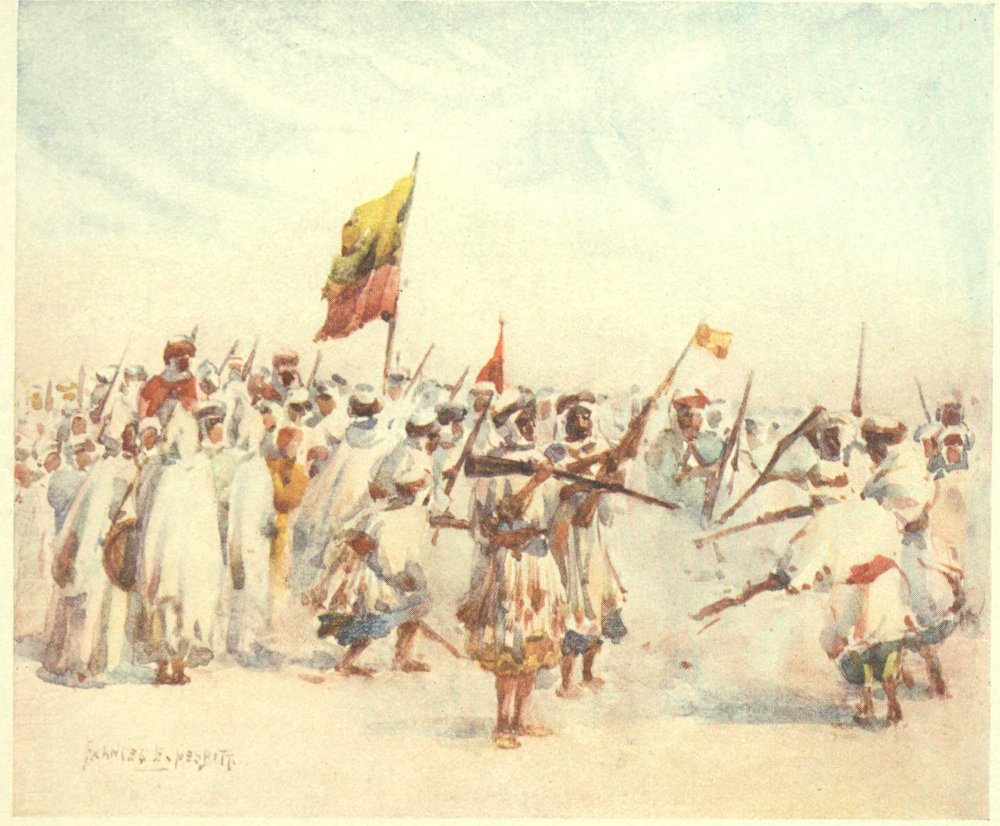
A MOZABITE FANTASIA
The fantasia begins with shouts, then a rush forward of eight or ten men, who turn and fire their guns into the dusty ground a few feet ahead. Before the smoke has cleared, another squad charges and fires at the feet of the first party with shouts and yells, and they toss their guns into the air, the tom-toms and pipes play martial music, and the din is deafening. Rush after rush follows, the squads prance forward, fire, run back, reload and fire again. Excitement grows and grows, the dust, smoke, and noise are appalling, and the yells become more and more savage as the smell of the powder maddens them. Then it is that accidents often happen, for the guns are old, all of them dating at least fifty years back, and many of them being really antique. Some are quite elegant and are inlaid with silver, but one man had a queer old weapon, thick and short, that might have come from the Tower of London. It took twice as long to load, and needed an extra charge of powder. Its owner took care to have the field to himself when he fired, and rejoiced at the stunning report, loud as a cannon. The officers said that each man fired off more than his year’s allowance of powder before the entertainment was over. If this was so, the secret factories had supplied them with a large reserve, for the excitement was so great that they went round the town after the procession, at the close of the day, and gave another fantasia outside the hotel, and continued firing at intervals far on into the night.
The fantasia of the Goums is equally exciting and a far prettier sight. The horses count for so much, even without considering the dash and go of the riders, the brilliant white of their robes, the rich colours of the cloaks and saddle-cloths, the glitter of golden trappings, and the flash of light on the drawn swords. It is a ride past. But such a ride! One after another, the horsemen come thundering down the course as fast as their light steeds can gallop. They fly by, all their draperies streaming in the wind, fire their guns, and wave their swords, right and left hands or reins are matter of no moment. Some take deliberate aim at 88 the man in front, and ride as if to ride him down or die in the attempt; others fire at the crowd, and some make believe their enemies are at their feet.
Desert warfare is very real at such a moment, and it requires no imagination to picture what it would be. There is a concentration, a fierce determination in the mimic fight, which tells its own tale, and suggests a foe, hard to conquer or subdue because so absolutely fearless.
After this the camel races are tame, the movements of the picked Mehari who raced from Tougourt are too slow and stately in comparison with the tearing gallop of the horses. Even the fact that one of them is ridden by a Touareg in full array fails to make its due impression, so much is every one under the spell of speed and noise. The stealthy, quiet tread of the great beasts, even their picturesque qualities, had less effect than usual; they were finer on the desert, infinite space and light and mystery behind them.
Other sports, amusing to watch, were held under the shade of the mimosa in the gardens. The incongruity between the dignified appearance and lithe grace of the competitors and their childlike glee in each other’s performances, made even walking along a greasy pole a delightful comedy. Hearty laughter is not one of the lost arts amongst the Arabs.
At night there are more processions, with Chinese lanterns and torches, crackers, weird music and dances, and the whole place is alive and gay, whilst noise reigns triumphant.
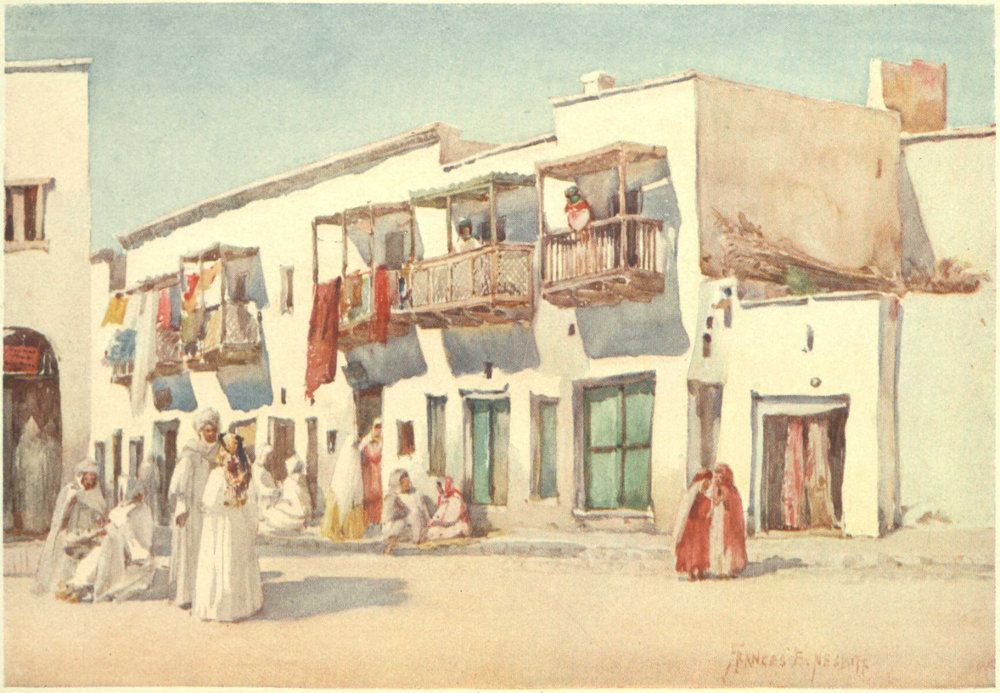
STREET OF THE DANCING GIRLS, BISKRA
The dancing is not limited to the Ouled Naïls, or dancing girls; the men have a fine sword-dance that looks like a serious duel. The music is stormy, martial, passionate. The musicians shout, the women scream to incite them to further fury. Their own war cries are deafening. The correct finish is for one to be conquered and disarmed, whereupon he shakes hands with the victor; but it sometimes happens that the excitement goes a little too far, and a bad cut brings the play to an abrupt and more dramatic termination.
“Leaving Biskra is like dying—a thing we must all get through somehow,” an American lady wailed, partly because she “just hated going,” but still more because of her fate at being condemned to get up at the unearthly hour of 5 A.M. to catch the first train.
This used to be the only train in the day, but now matters have so far progressed that on three days in the week a new one has been added as far as Batna, which saves much tribulation on the part of those who wish to see Timgad and cannot bear beginning their day with the sun. Dawn, however, is as beautiful as sunset, so that it is perhaps as well even for the lazy to be obliged to see it sometimes.
The four or five hours on the backward journey seem long. The keenness of excitement is wanting; there are only the glimpse of El Kantara, and some smiling greetings as the train passes through, to help pass the time. In the afternoon it soon gets dark, and the train goes crawling on slowly as if groping its way.
It is not possible to get up much enthusiasm until 94 Batna is reached, for that is only a halting-place from which the start will be made next day to the ruins of the City of Timgad. Batna itself is nothing more than a clean little town with wide streets and low houses, an important military centre, with a large garrison and barracks, which are perhaps the most striking buildings in the place. There is no quartier indigène; little or nothing to amuse or interest.
In consequence perhaps of this it is quite usual to arrive by the early train, lunch at the station, then drive straight out—a matter of three hours, “do” the ruins with a rush, and return in the dark. But there is too much to see and study for this to be satisfactory, except for those who do not really care for antiquities at all. It is certainly better to put up at Timgad for a night or two, and make the best of the inn, which, though rough, is new and perfectly clean, and that is more than can be said for the more pretentious one at Batna.
It has always been our lot to arrive at Batna during a spell of cold weather, of the sort that is a positive surprise to those who expect continual warmth in the far South. The cold is so great that it is almost a penance to drive at all, and this even as late as the end of March.
As the start has to be made fairly early, about eight o’clock, it is rather chilly work. However, the situation is thoroughly understood and prepared for. Foot-warmers, so scalding that they are a comfort for the three hours, and any amount of rugs are provided. Every one looks as if starting for a sleigh drive, mere 95 bundles as they are of cloaks and furs, their faces covered with shawls, in a fashion which partakes of both the African and the Arctic.
This is our experience, whilst others, both before and after, felt the heat to an equally intense degree, for there is no shelter, when once the town is left behind, from either cold winds or broiling sun. Nothing is to be seen on either side but the wide, undulating plains, cultivated more or less at first, but later on growing wilder and wilder.
Our last visit was after a heavy snowfall, the countryside flooded with sunshine, sky and cloud, mountain and plain, dazzlingly and intolerably bright. The snow, though only a couple of inches deep on the road, was twice that number of feet in the drifts; the sheep and the Arab shepherds looking thoroughly out of place as well as miserable, their woollen garments and fleeces forming a brown and dingy contrast to the pure whiteness. As a snow landscape the scene was charming, the mountains of the Aures gaining much in dignity from their white robes. As a rule it must be owned that the drive is a trifle monotonous, notwithstanding the space and width and the sense of air and freedom. At first the soldiers exercising their horses, and the groups of Arabs coming in to town to do their marketing, provide some interest. Then Lambessa becomes visible, the Prætorium rising like a castle from amongst the trees. The modern village consists of barracks and a few houses and cafés, but the ruins of the ancient Lambæsis are scattered far and wide. Formerly, it seems to have 96 been a military station, the headquarters of the third Augustan Legion. Perhaps this is the reason that the ruins have not much artistic value, with the exception of the peculiar massive structure called the Prætorium, which stands square and upright, in solitary dignity, amongst ruins and fallen columns on the bare paved square that was once the Forum.
Glimpses of walls and triumphal arches show among the olives and fruit trees of the farms, as the long, curving road sweeps up the hill out of the valley and on to the wold. The heat of the sun melts the snow so rapidly that the rich dark browns of the soil begin to make a restful contrast with the prevailing whiteness. For miles and miles the horses trot quietly on, passing only one or two houses and a few Bedawin tents on the way, then suddenly in the distance, set among the hills, under a great range of snow peaks, are seen two houses, some ruined pillars, and an arch. Timgad at last!
Desolation itself: not a tree, hardly a touch of green, where once all was forest; nothing but the inn, plain and uninteresting as a house from a child’s Noah’s Ark! the group of buildings and shanties which form the Museum, and a dwelling for the Directeur who superintends the excavations.
The ancient city of Tamugadi, or Thamagas, called also Thanutada by Ptolemy, was finely situated on rising ground with a wide outlook over the now barren wold, whose browns and reds, blending with the soft blues and purples of the hills, make a beautiful background to the pale gleaming of the slender pillars still left upright. The town was never very large, but was important and much mentioned in history. There are inscriptions in the Forum which tell of the 30th Legion Ulpia, and of the victories of Trajan over the Parthians.
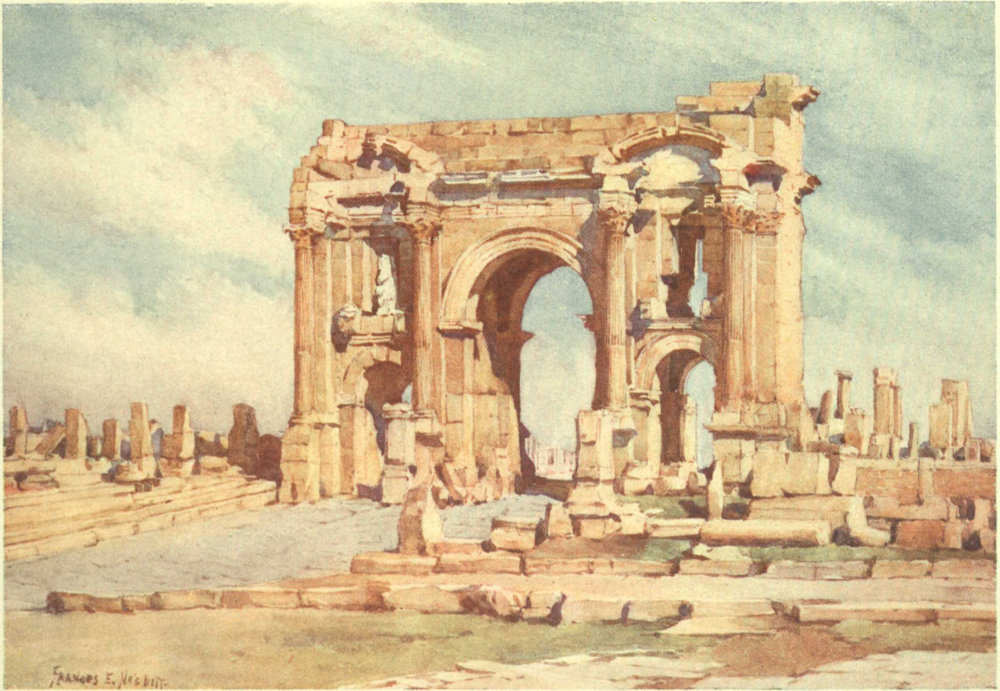
THE ARCH OF TRAJAN, TIMGAD
The foundation stone was laid by Lucius Munatius Gallus in the reign of Trajan A.D. 100. The building was rapidly carried out according to a definite prearranged plan, and shows plainly that the Romans would not tolerate any temporary buildings or poor craftsmen even in their most distant colonies, but that they required both solid workmanship and a certain measure of magnificence in all that they undertook. The city was built thirty-six years after the great fire in Rome in the days of Nero. The consequences of that fire, and of the new ideas for avoiding future conflagrations mentioned by Tacitus, were here carried into effect by building all the more considerable houses in a detached form with a clear space all round them. This is one of the remarkable differences between Timgad and its rival Pompeii. Its later history is full of sad tales of religious disputes and much fighting in the fourth century. The head of the Donatists, Bishop Optatus, who persecuted the orthodox with great cruelty, joined Count Gildon (under whose sway Africa trembled for ten years) in his revolt against the Emperor Honorius. They were both overthrown, the Bishop was taken prisoner, and suffered in his turn, ending his days in prison. St. Augustine often alludes to Count Gildon and his terrible doings.
In A.D. 535 the city was already in ruins, but later on the citadel was restored, and at the time of the Arab invasion was evidently in Christian hands, for the ruins of a church built in A.D. 646 still remain. The end of the city came with the close of the seventh century, when it must have been taken by force, sacked, and burned, as so many of the buildings and even the soil show traces of fire.
However, the attraction of Timgad does not lie so much in its history as in the beauty of the ruins that remain, and in the interest of comparing with Pompeii another and larger city—a city more important and as perfectly preserved, and now, thanks to the excavations, spread open like a book.
Not that the excavations are at all complete even now, for nearly two-thirds of the city are still untouched, though the work was begun as long ago as 1880, and the French Government allows a considerable sum, £1500 to £2000, yearly for the purpose. Under the circumstances it is strange that these, the finest ruins in Algeria, should have been almost unknown until quite recently. The older travellers, Bruce and Shaw, wrote much on the subject, and the former left some splendid drawings of the ruins. Most modern writers, however, up to 1890, content themselves with a visit to the comparatively unimportant Lambessa, and ignore Timgad altogether.
The French even had so little notion of its existence, that an old French General told us that when he was quartered at Batna some thirty years ago no one had 99 ever heard of the ruins, and that he himself had noticed nothing in his rides, though he had scoured the country for miles round. His interest and excitement now showed that this was not the result of indifference to things antique, but simply want of knowledge. The odd part of the whole affair is that the triumphal arch must always have been a conspicuous object, and not easily overlooked like the half-buried columns which scarcely rise above the ground on the unexcavated portions of the hillside.
The pride of the place is that it is not a “lath and plaster” city of pleasure, like Pompeii, but a solid, business-like town, built of stone and marble, where nothing inferior to good brick-work has been found. On the other hand, the colonists of North Africa could not be expected to rival the luxurious citizens of Pompeii in their collection of gems and works of art, exquisite bronzes and sculpture, and delicate frescoes. The fate of the two cities was so different, that even supposing Timgad to have possessed as rich a store of treasures, it was not possible for many to remain in the ruins after much fighting and looting.
Consequently the statues found are not of the highest order, and the Museum does not contain many wonders. In mosaics alone it is rich: a great many have been found in perfect preservation and very fine. They consist not only of geometric patterns, but of large and important subject-pieces with colossal figures, and each year more and finer mosaics are added to the collection. When found, they are carefully taken up 100 and placed under shelter in the Museum buildings to save them from the spoiler.
The main entrance is through a gate in a rough paling, but this fence is only a farce, put there to guide tourists to the Museum, as it does not extend round the ruins, which are quite unprotected on the further side.
Opposite the Museum stand the ruins of a basilica, and a few steps farther up the well-paved street are the graceful columns of the so-called Salle de reunion, where, amongst many Roman capitals lying on the ground, is one of Byzantine origin.
This street ascends to the Forum, where it is crossed by another, the main thoroughfare, the via Decumanus Maximus, leading to the Arch of Trajan and the market. Evidently the traffic here was far heavier than in other parts of the city, as the ruts in the pavement are so deeply worn. There are no stepping-stones as at Pompeii, but the paving of all the streets is still in such good condition that carriages can be driven through them all.
The water-supply and the many fountains, as well as the whole system of drainage, are very elaborate and carefully planned. The sewers are indeed so large that it is possible to walk through them, and in many cases without even bending the head.
The spacious and stately Forum seems to have been surrounded by a colonnade double towards the via Decumanus Maximus, with a temple at one end. Many of the pillars are still standing, and others have been replaced on their ancient bases. The long distance between the columns, especially on the east and south sides, show clearly that the architraves that surmounted them were of wood. The Forum was paved with great flagstones, but a large portion is now missing. Well-preserved and perfect inscriptions are set up round the Forum in front of the pillars.
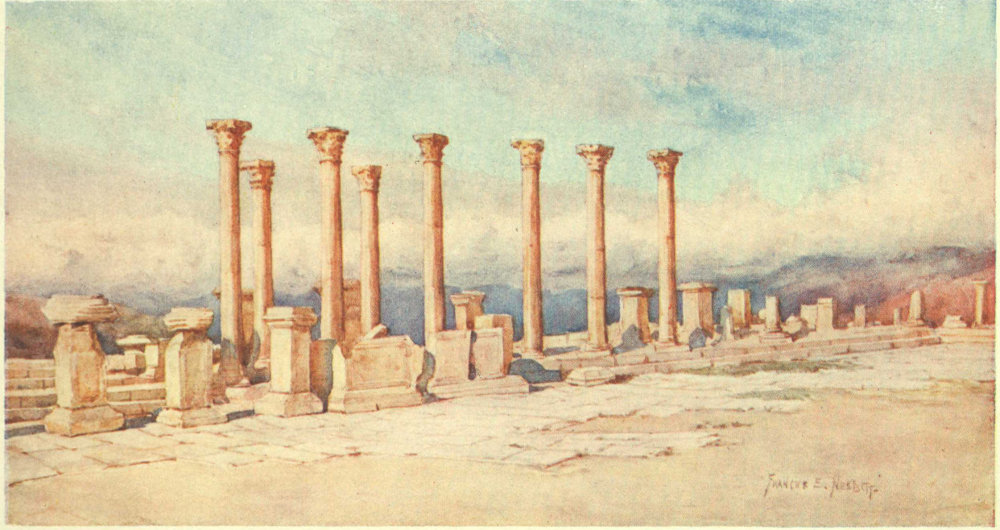
THE FORUM, TIMGAD
The theatre was a fine one, capable of holding in its seats, porticoes, and galleries some 4000 spectators. It is in good preservation, but not peculiar in any way.
One of the best views is from the hill just above the Auditorium. The city unfolds itself, disclosing all the intricacies of its former life—the wide open space of the Forum, the great temples and baths, the fine arch, some handsome houses, the narrow streets, and the small dwellings huddled together in the poor quarters. As at Pompeii, there is the curious effect of a town with the upper portion sliced off by a giant’s hand; but here it is not so marked, for many of the buildings have escaped more or less—some even are untouched, and the pillars are often erect and complete, several having been replaced during the excavations.
Timgad has some unusual features. In a house between the Forum and the theatre is an elegant atrium with ten columns, having a central fountain or well surrounded at some little distance by semicircular flower-boxes of marble, charming in design, and said to be unique. The market, again, is quite unusual, and has been described as an “archæological revelation,” no such ancient municipal mart being known in Africa. It lies beyond the Arch of Trajan, and the entrance was 102 through a low portal, the Chalcidicum. The market was of a fair size, and, like the Forum, well paved—a sort of colonnade running all round, with square cells between the columns. These cells or stalls had counters formed by thick slabs of stone. To enter the shop the owner had to stoop under the counter—an arrangement that is copied in most Oriental bazaars to this day. The place is so perfect that it does not require much thought to see how well arranged and picturesque this old-world market-place must once have been. And to assist in the process, dishes, vases, amphoræ, and even balances have been found on the spot. Flour-mills of an unwonted form are found in many houses. There are numerous wine shops but more fountains, one of particular grace having been lately dug out in a new district beyond the market.
The baths are remarkable for their splendour and the perfection of the arrangements for heating. They were decorated with fine mosaics in geometric patterns, and also between the columns of the gallery with designs of figures and animals. A good many of these mosaics are still left in their places, but are carefully covered over with a thin layer of soil to prevent theft or damage. On great occasions, such as the visit of the President, this is swept away, but ordinary mortals have to content themselves with glimpses of small portions of the pavement that the foreman scrapes clear with his foot. There were formerly several baths, and at one time as many as seven Christian basilicas.
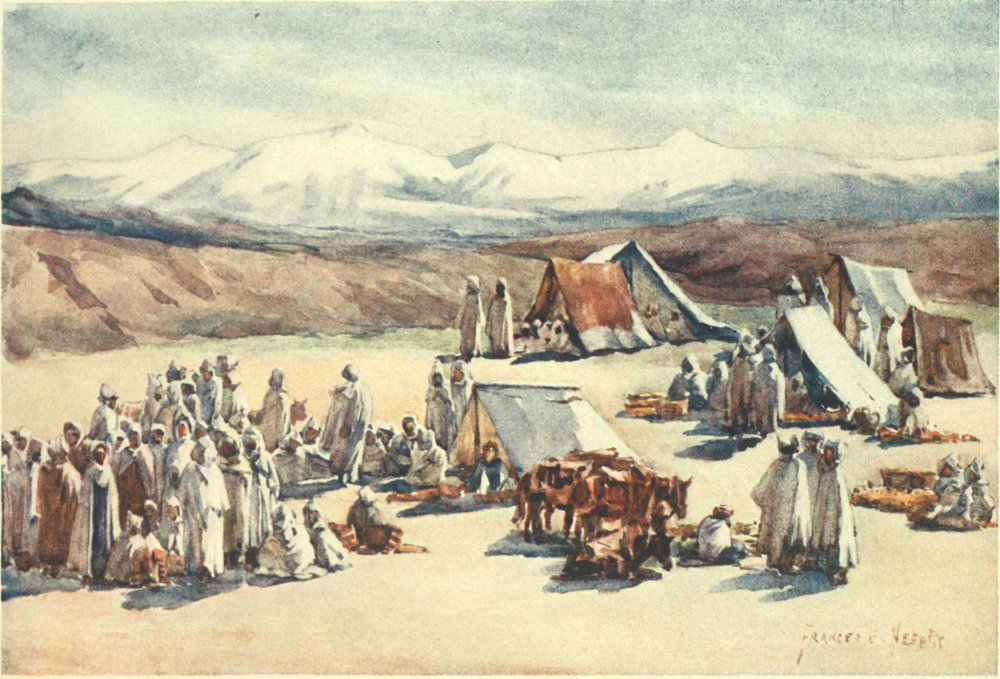
MARKET DAY, TIMGAD
Of the temples the most imposing was, and is, even in its ruins, that of Jupiter Capitolinus. It stands on a hill, the highest point in the city. Two columns with Corinthian capitals are still standing, but, to judge by the immense quantity of debris of marbles of all colours found in the cella, it must have been truly magnificent. The marble is supposed to have been brought from Mahouna, near Guelma.
The triumphal arch, or Arch of Trajan, the finest in Africa, is almost perfect, though slightly restored. However, much cannot have been done, because there is scarcely any difference between its condition now and when drawn by Bruce. The arch has three openings, and both sides are alike. It is built of warm golden sandstone, and the beautiful fluted Corinthian columns are of a stone so fine and white that it looks like marble. The capitals, bases, and pilasters are of the same stone. Over the two side gateways are niches for statues, only one of which is left. The whole is simple in design and beautiful in form and colour, whilst from its position it becomes the key-note of all views of the city.
In these days of her desolation and abandonment, Timgad is only inhabited by the two or three Frenchmen who superintend the Arabs in the work of excavation, and by the family of the innkeeper, who have not too much to do in feeding the travellers who appear now and then in the middle of the day for a few hours. So it is odd to awake one morning to find the whole place alive with crowds of men, their mules and horses; the ground in front of the inn and up to the Museum 104 gates covered with small tents, and all the clamour and bustle of a busy fair. The whole scene is changed as by enchantment, and a new, vivid, noisy life intrudes in dreams of bygone days. These Arabs, or rather Berbers, come from far—from homes high up in the distant hills or far out on the plains; these hills and plains which look so inhospitable and wild, but in some parts are really beautiful and both green and fertile. There are amongst them wild men—rough, uncivilised, and very dirty, but there are also Sheikhs and Caïds who would look well anywhere. This weekly market is to them a great institution and a delightful change, but Timgad seems to look twice as solitary as before when the crowds have melted away and the last white robe has disappeared.
Travellers’ tales and descriptions of Constantine are full of such boundless admiration that they are really little more than a chorus of applause and wonder. The consequences are not quite what might be expected, because it is impossible to believe that all this praise is justified. Sober truth seems hidden by flights of fancy. So the sceptical mind prepares itself and fears no disappointment or disillusion, heedless of the fact that it is the unexpected that always happens. In this case such wisdom is wasted, for the situation of Constantine is amazing beyond all expectation, and wholly beautiful.
In former times the city was apparently as picturesque as its site, but this, alas! can no longer be said. The rage for modern improvements has destroyed so much, that it is only in nooks and corners that Oriental architecture still lingers.
The original city of Cirta or Kirta, the capital of the Numidian kings, has entirely disappeared, and no traces are now left of the splendid palace of Syphax, or of the fine buildings that Micipsa is said to have built here. 108 Even the old name, signifying an isolated rock, has been superseded by the later one of Constantine—a name that even the poetic attempts at new derivations made by the Arabs, such as Ksar-Tina, the castle of Queen Tina, the castle of the fig tree, and so on, have failed to make interesting.
Their own name for the city, as given by El Bekri, namely, Belad el Haoua, sums up its individuality perfectly. The single word Haoua means not only air, but also ravine and passion. The city of air tells of its height, over 2000 feet above the level of the sea. City of the ravine is a title that suits it even better, for no other city stands on a rock encircled on three sides by a chasm instead of a moat; and history, starting with the tragic tale of fair Sophonisba and her pathetic speech (ere she drank the cup of poison sent her by Masinissa) about “dying with more honour had she not wedded at her funeral,” shows that passion has never been lacking.
Roman rule has left a deeper impress, but soon there will be little of the flourishing colony of Cirta Sittianorum, founded by Julius Cæsar. There are many inscriptions, among them one proving that Sallust, who was once the Governor, possessed a vast domain.
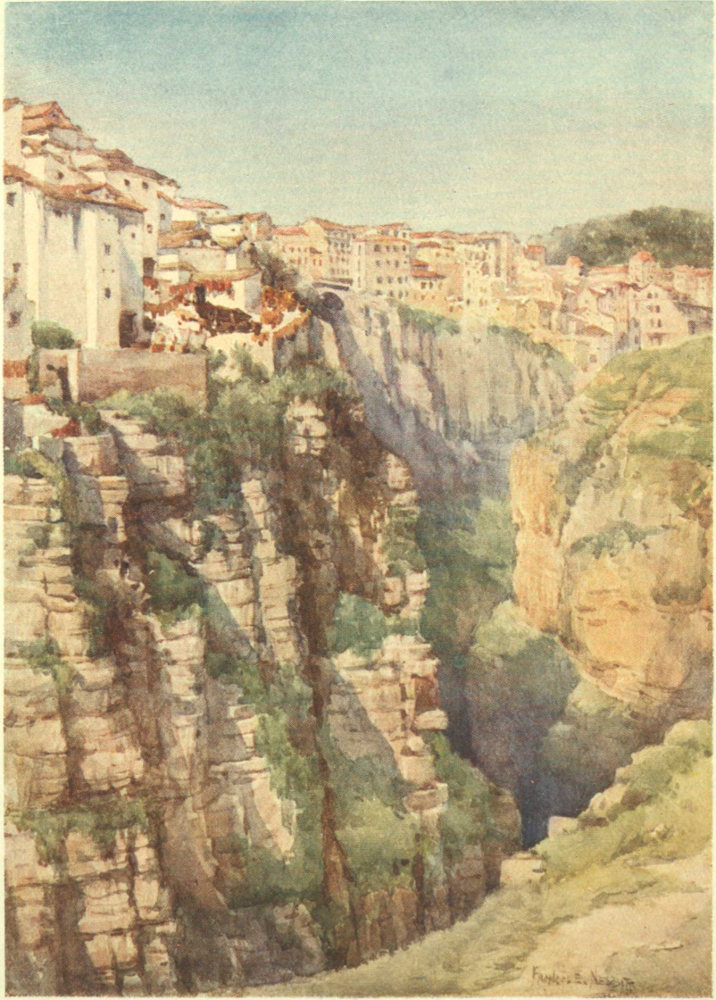
GORGE OF THE ROUMEL, CONSTANTINE
Of a fine aqueduct, built in the reign of Justinian, only five arches remain, prettily situated among the trees by the river. As for the ruins of the old bridge, dating from the time of Constantine the Great, it would probably be hard to say how much was truly Roman, so often has it been restored. This bridge was double, and built on the foundation of a natural arch; the upper part, formed of huge blocks, carried the road, the lower was purely ornamental. Shaw says it was indeed a masterpiece of its kind, which makes its end the sadder. A pier of the upper story gave way in 1857, and as restoration was supposed to be impossible, heavy artillery was used to batter it down. Now the chasm is spanned by a useful but ugly iron erection, built exactly above the ruins, and forming a pitiful contrast between the old style and the new.
Few cities in the world have suffered so many changes, for notwithstanding its apparently impregnable position, Constantine has been besieged and taken no less than eighty times—that is, if tradition can be trusted. It escaped destruction under the Vandals because the bishop in those days was a Donatist. The victorious Belisarius found that no harm had been done, and even the Arabs spared the ancient monuments, so that the strain of these many sieges seems to have worked less havoc than the fighting which took place during the French conquest, when both besiegers and besieged showed the greatest heroism. The old bridge was the scene of the first fierce assault, when the French were driven back in 1836. The successful attack in the following year was made on the side of the isthmus, or neck of land, which connects the rock with the mainland, but even so the French lost heavily, General Damremont and General Perrégaux being killed in the breach, and officer after officer falling as he took command.
For many years afterwards the military government 110 took no interest in preserving antiquities, and so they were broken up, cut through and destroyed, to make way for new buildings, for roads, and for the railway. The greatest loss, perhaps, was the splendid triumphal arch, which was still perfect in 1734; but temples, arcades, vaults, porticoes and baths were all swept away by the Genie militaire in its thirst for improvement. The cisterns alone remain. They have been restored, and still serve to hold the water-supply.
The new roads are worthy of the Genie, but the new buildings are mostly blots on a beautiful landscape. From almost every point hideous, bare-looking barracks and many-storied modern houses crown the rock, and stand on the very edge of the precipice, whilst the new suburbs, springing up on the heights of Mansoura and on the side of Koudiat-Aty are scarcely more attractive.
And yet, taking all these drawbacks into consideration, the view from the bridge of El Kantara is astonishing. The grandeur of the gorge dwarfs all man’s works into insignificance, and the rocks tower with such majesty over the river which they hide at their feet that the houses above them pass almost unnoticed.
The ravine is narrow, not more than two hundred feet across, though the summit of the crags is quite a thousand feet above the river. The river Roumel comes from the sunny country-side, from the woods and fields, the poplars and the hedges, and plunges suddenly into the shadow of the huge vertical cliffs, twisting and winding in the dark depths on its way round the city, losing itself at times in gloomy caverns 111 and under natural arches, to emerge joyously beneath the grim Sidi Rached, then to fling itself thundering over the falls, out of the shadows at last, and into the lovely valley once more.
From the town it is difficult to peer into the depths, but on the other side a road follows the course of the ravine for its whole length. The most picturesque point is just opposite the tanneries, a delightful jumble of old Moorish houses, with white or pale-blue walls, and brown-tiled roofs built to withstand the snow and torrential rains, and very like the roofs of Constantinople in form and colour. The tanneries are perched on the walls of rock so close to the edge of the precipice that the Arabs when at work often fall over into the abyss, though it is said that the devotees of hachish will descend the same precipices, at the risk of breaking their necks many times ere they reach the bottom, just to meet together and smoke. It is giddy work to stand on these heights and look down over the first green slopes where hungry cows and goats find some foothold in their search for food, in places on the verge of the cliff where there is nothing but their own agility to prevent their falling straight into the gulf below. The boys on guard keep more wisely to the little footpath, and shout their commands to the straying herds.
The Cornice road runs from the bridge down towards the valley and the sea, and that is grand with Nature’s dignity alone. As a mountain road it is fine also, after the Swiss fashion, built round and tunnelled through the rocks of Mansoura, following their curves, half-built 112 out on supports, half-blasted out of the living rock.
Opposite the tanneries the road runs on the top of the cliffs, and the city stands on the same level on the other side of the chasm; but here the road, though it is still a considerable height above the river, is itself shut in by walls of rock, so grim and forbidding that if tales of dreadful deeds did not already abound, legends must have been invented in their stead; for there is something about the precipices of Sidi Rached which suggest and invite horrors. So perhaps it is no wonder that the Moors in barbarous times thought it a suitable place for getting rid of criminals, or of the wives of whom they were weary. It is, however, hard to believe that men were ever cruel enough, not only to fling a beautiful woman over a cliff by the Bey’s orders, but also, when she had been saved as by a miracle by her clothes catching midway on the rocks, to rescue her and then kill her deliberately by some other form of torture.
At the French conquest the defenders retired, fighting, to the Casbah, and there as a last resource tried to fly from the hated infidel by means of ropes. But the numbers were too great, the ropes broke, and hundreds perished in the attempt, though it is thought that a few may have escaped.
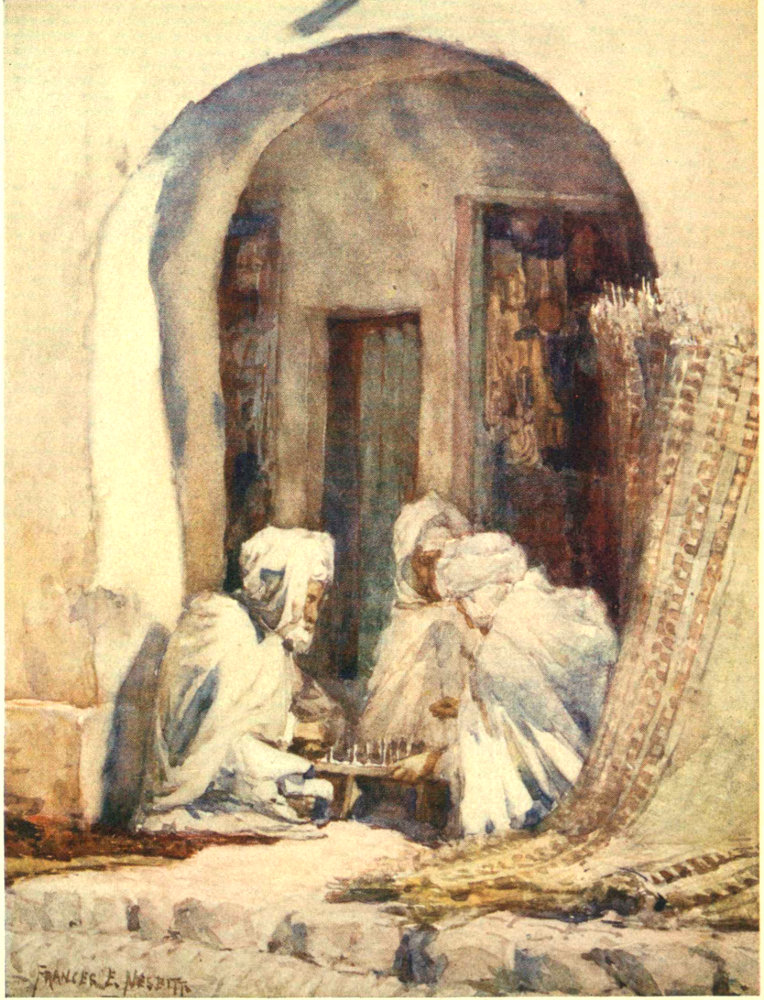
A GAME OF DRAUGHTS
The Chemin des touristes is a path through the ravine, winding up and down, and cut out of the rock, or built upon it. It is a path full of surprises and fascination, formed for a great part of staircases, and in most places a strong railing is necessary. Near the bridge are seemingly endless steps, and little bridges descend in uncanny gloom into a huge cavern, where the path becomes a balcony of wood over the river. Giddy steps, slippery with damp, lead through the cave, a true orrido, and then come wonderful effects of light and shade. The light falls from above through four natural arches whose height is over four hundred feet. From the bottom of the gulf the sky seems far away, the city hides itself, whilst the rocks appear more imposing than ever. Artists might spend their days here, for subjects are endless, but they must be impervious to chills, and have no sense of smell or any fear of typhoid. Even in winter to walk through the gorge and wonder at its beauty is a penance for the nose, for it receives the drainage of the tanneries and the town; but in late spring or summer, when it would be a cool retreat, the inhabitants say that the air is even more deadly.
Within the walls a superficial observer sees nothing but steep and dirty French streets, and it is easy to walk all over the town without ever finding the Arab quarters. This does not mean that the whole place is not crowded with indigènes—far from it, for it is a busy centre, in which the province of Constantine does its shopping. No town in Algeria is so laborious and active, the chief trade being in shoes, saddlery, and burnouses. Town Moors are in the minority, the streets being mostly thronged by white-robed countrymen, of a rather dirty type. The Arab women wear dismal grey haïcks, and the young girls and Jewesses, who are strikingly handsome, wear a coquettish cap, a cone of coloured velvet 114 embroidered in gold. Sometimes it is covered by a cunningly tied kerchief, but is often set like a flower on the wearer’s dark locks, very much on one side of the head. Arab chains of round, flat links, very large and heavy, are used by the rich to keep on this cap, and big ear-rings are also worn. The rest of the dress is usually commonplace, though on Saturdays gay shawls and gorgeous gowns of velvet and plush are popular.
What is left of the Arab town concealed behind the modern houses is something like old Algiers. The streets are even narrower and often as steep, but instead of the cedar beams, the upper stories are built out on inverted steps till they almost touch each other. Pillars and capitals from Roman buildings fill corners, form gateways, and have been used to build the mosques, which are neither very important nor interesting. Up a few steps on a small vine-covered terrace is the tomb of a famous saint from Morocco, built partly of fragments of Roman work. But the individual buildings are nothing. It is the life, the bustle and confusion in the streets, the tiled roofs, the pale-blue colour on the walls, the odd-looking shops, the scarlet and blue hanging up in the streets of the dyers, the glitter of the silver as men crouch over their tiny fires making rough jewels, the more delicate tones and rhythmic movements of those who weave silks or belts, or twist soft yellow floss round enormous winders—small details these, like fine threads weaving one magic spell—the spell of the East.
Unconsciously this hovers over everything, giving distinction to the Cathedral, once a mosque with the 115 poetic title of Market of the Gazelles, by the old tiles and the fine carving of the mimbar, or pulpit. Even the Palace of the last Bey, really so new, built so quickly by the simple method of pulling down other houses to provide beautiful carving and richly coloured tiles, and by stealing columns and capitals from temples, gains its originality in the same way—the singularly naïve paintings of battles and ships that decorate the walls helping to give the last touch of apparent age and orientalism to the many courts filled with orange and lemon trees.
Late in the spring Constantine should be delightful, but, owing to its elevated situation in a mountainous district, it is often too cold in the early part of the year for those who come from the warmth and glow of the desert. It is wintry, though the sun is bright and the air clear, so that sketching in the chill shade of the streets is out of the question. It is scarcely warm enough even to enjoy drives, beautiful as is the countryside and the views from the heights over hill and valley. There are woods and charming dells, with here and there a Roman ruin as an object for a walk, such as the aqueduct or the baths of Sidi Meçid. This bracing mountain air makes the climate splendid for the colonists, for the extremes of heat and cold are much the same as in their own beloved France, and to cheer them on their way the Romans have left inscriptions showing that many centenarians flourished here, and though the women only managed to live a hundred years, one man, Ælius by name, reached the age of one hundred and five. Could anyone want more?
The next stage on the long journey to Tunis is Hammam Meskoutine, or the Accursed Baths. Now the name alone ought to be sufficient to scare strangers away, but it seems to have precisely the opposite effect. Many, indeed, come for one night only, and linger on from day to day, loth to leave a place so unusual and attractive. The wayside station, half-hidden by graceful eucalyptus trees, leads to no village, for the simple reason that there is none—nothing but the baths, a farm or two, and a few scattered gourbis.
There is not much to see. There are no fatiguing sights, no amusements whatever—only a tranquil country, a freshness of untrodden paths, a touch of the unknown and exceptional in the hot springs and falls to give piquancy to the surroundings. It is a country of soft outlines, Greek in its simplicity, breathing rest and peace. A land of hill and dale, rich pastures and many trees, where glare, dust, and bustle are alike forgotten.
The uplands are covered by a cloud of grey-green olives, some of them age-old trees, whose gnarled and 120 twisted trunks look silvery against the deeper tones of the leaves, the bright green of the long grass, and the purple and blue of the mountains beyond. Under the trees the flowers of the asphodel shine starlike, calm fills the air, the flocks come and go, and the slender figure of the white-clad shepherd who leads and watches them, piping on his queer rustic flute, is in harmony with the spirit of a half-unconscious dream of the days of long ago.
Cutting across the smiling landscape like a scar is a plateau of whitish grey rock, pools of boiling water and clouds of steam, the region of the springs. The water comes bubbling up through the grey crust, then flows out over the surface with no fuss, no fountain, no spray. Dense clouds of steam rise from these bubbling springs in all directions, and also from the water as it falls over the rocks down to the valley below. This water as it cools leaves a thick white coating on whatever it touches, thus raising in the course of ages a succession of terraces now some two hundred feet high, resembling on a smaller scale the once famous pink terraces in New Zealand. These terraces are of every tone of yellow, orange, russet and green, and are full of small cauldrons. Pouring over these natural basins and mingling with these many tints flows a steady stream, sometimes the rich colour of thick cream, sometimes the snowy whiteness of foam, but though airy in appearance, perfectly solid, absolutely still. Only the water moves softly and the steam rises ceaselessly—a wonder straight from the under-world, a silent waterfall.
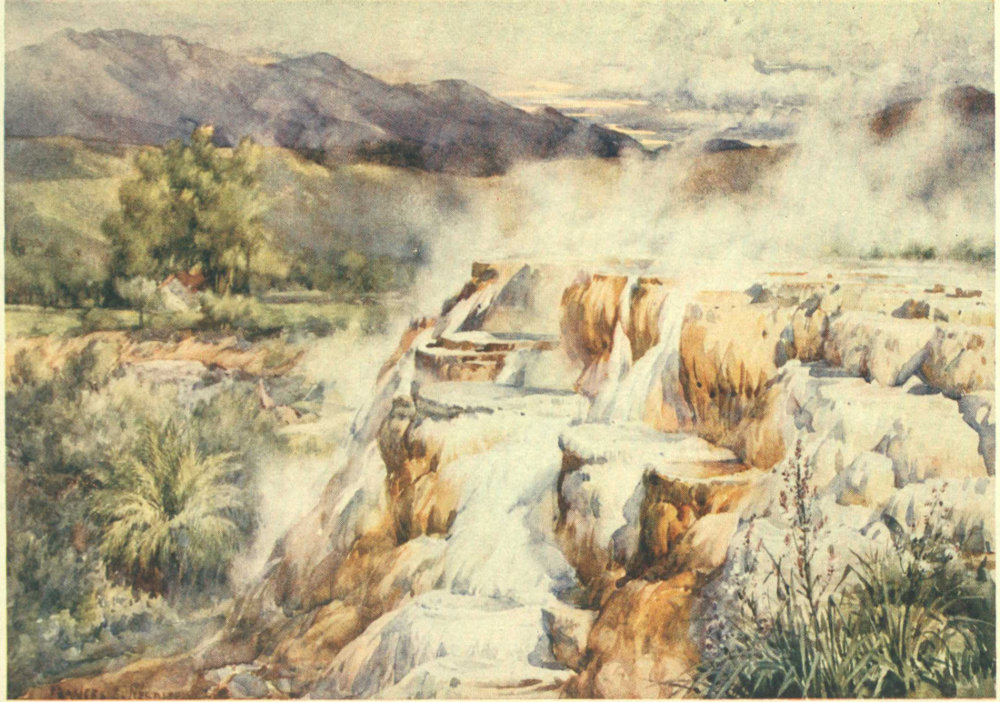
THE SILENT WATERFALL, HAMMAM MESKOUTINE
And not silent alone, but carved in stone—a finished work in one sense, yet ever changing; for the springs are capricious, appearing now in one place, now in another, and just now a new stream has started some little preparations for terraces on its own account at the side of the railway, and has even arranged to cross it. The earth’s crust seems unpleasantly thin and crumbly, and the heat is so great that it is well to be heedful and walk warily, for water at a heat of 203° Fahrenheit is too warm for comfort, even when it has cooled itself somewhat on the rocks. The only other springs known to be hotter than these are the springs of Las Trincheras in South America and the Geysers of Iceland, but they are only 3° and 5° warmer respectively.
It is amusing to watch the amount of cooking done in the open—eggs and vegetables are put into a bubbling pool, and anything else the chef thinks a good scalding will improve. Hot water for baths is fetched in a garden tank on wheels, and if any is wanted at odd times a jug can always be dipped in a stream, for the hotel is quite close to the falls. The old baths—some of them Roman of course, for what did not the Romans know?—are still in use, for these are the most celebrated springs in Algeria; though Hammam R’hira, beautifully situated in the mountains not far from Algiers, runs them very close. The hotel is built on no conventional plan; it is a series of low buildings set in the olive grove with a wild garden in their midst. An Eastern garden with a central fountain, surrounded by lemon and orange trees, laden with golden fruit, shading fragments of 122 Roman reliefs, capitals, and columns—an unwonted form of museum and a pretty one. Pretty also are the rooms in the long bungalow, with windows looking out on one side on the flowery meadow under the olive trees, where the steam from the falls can be seen in the distance. Seen and smelt also, be it said, for there is much sulphur in the water. The other window, which is also the door, opens on to a rough colonnade and the garden. Two more bungalows, and a house that shelters the kitchen and its excellent chef, as well as the dining-room and dull salon, complete the establishment. On warm days the pleasant custom prevails of taking meals at small tables under the deep shade of an immense sycamore—a real open-air life, fresh and delightful—in fine weather. We were not there in rain.
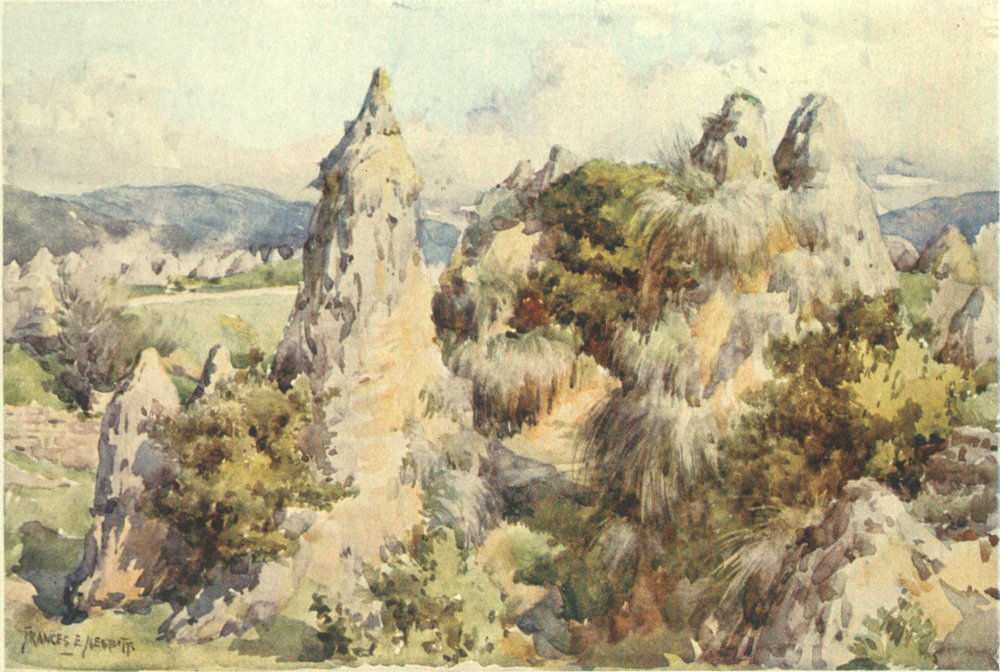
THE ARAB WEDDING, HAMMAM MESKOUTINE
In a little hollow near the springs is a group of curious cones, petrified like the falls, and now half-covered by grass and shrubs. Exhausted and now quite dry, the water having long since found new ways to escape, these cones are scattered over the ground for some distance. One special group, distinguished both by its size and by the peculiar shapes of the pillars of stone, has such terrors for the Arabs that they dare not pass it at night, from their firm belief in the legend which gave the place its name of the Accursed Baths. For once there was a sheikh, a rich and powerful man, who had one only sister, beautiful as a flower. He loved her with an exceeding great love, and thought her so supremely fair that no man could be found worthy of her. He therefore determined to wed her himself. The elders of the tribe arose and made loud protestations, for as an Arab told me in his odd French, “Il est très défendu dans le Koran de marier avec sa sœur.” But the sheikh paid no heed to their exhortations or their prayers, and caused those elders to be beheaded before his tent door. Then he made a great feast, but as the end of the marriage festivities drew near, a great darkness overtook them, a tremendous earthquake shook the earth, out of which came flames of fire, and demons were seen abroad. Deafening thunderclaps followed, and a storm raged mightily. In that moment the accursed couple met their fate. Ever since that dreadful night the whole wedding party has stood there turned into stone: the Sheikh Ali and his bride, Ourida; the Cadi who married them, and who is known by his turban; the father and mother who gave reluctant consent; all their friends and servants; the musicians, the camel laden with bridal gifts, the distant tents, even the cous-couss left over from the feast. The wrath of God had fallen upon them because they did not obey the laws of His prophet, and for evermore the smoke of the fire ascends—a witness to all men of the punishment that awaits the evil-doer.
The subterranean lake is an excuse for a lovely walk over the hills. This lake only came into existence about twenty years ago after a great storm. The earth fell in with a tremendous crash, disclosing the entrance to a cavern. From some hidden source water came rushing in for about six weeks, and then suddenly ceased. The cavern is dark as night, even in the afternoon 124 when the sun shines on the opening; the entrance is steep, and very slippery; the lake lies far below, the dark vault looking like the gate of the under-world. Arab women bring piles of brushwood, and with bare feet descend easily to make a flare at the water’s edge. The light is weird and unearthly, the moving figures suggest witches, the water glimmers dimly, reflecting the flames as they leap up, and accentuating the gloom and vastness as they die down again.
One of the women was beautiful, her colouring was of the North, and the moon of her fair face was surmounted by a crescent moon of white linen. At least this veil, stretched over a frame or cap, should have been white, but was, in fact, sadly dirty; the gourbi they lived in was even worse. It was built of stone, roughly thatched, and surrounded by a wall to form a sheep-pen. The ground within and without was trodden into mud. Many of the animals shared the hut with the family, who seemed to have scarcely any possessions, and who, had it not been for their beauty, would have seemed lower in the scale of life than their own flocks.
The joyous rush of a motor car on a good road is no bad antidote to overmuch strolling in flowery meads or lounging under trees. Ancient ruins and motors sound incongruous, but, after all, surely the Romans would have revelled in the sport, and the fear of demons would scarcely have terrified them as it would the men of the Middle Ages, or the Arabs of the present day, whose ways made the drive to Tibilis amusing. The road twists and curves round the hills far above 125 the clear stream, and as the motor with much hooting rounded the endless corners, Arabs rushed up steep banks out of reach of the monster, pulled their animals into shelter by main force, or covered their horses’ heads with their own burnouses. These were those who knew and understood. Those who did not, paid no heed to the coming of the “Turnobil,” and the chauffeur had to creep slowly and carefully past them. Others again climbed to points of vantage and shouted, and those shouts were not blessings on our progress, whilst a few naughty boys indulged in throwing stones which did no damage.
The ruins of Tibilis, now Announa (found by General Creuly in 1856), are finely situated on a hill, so the last part of the journey must be done on foot. The path, when it exists, is only to be avoided, so stony is it and rough, and also swampy in places. The distance is nothing, but the way seems long from its steepness and the scorching sun. It runs first downhill to a brook which it crosses by a bridge of slippery planks, then up a steep brae, and along a valley, when the toil is ended by a final scramble to the top. Here on a bare brown hill are a few weather-beaten trees, leafless and desolate, and all that remains of the ancient city—a stretch of paved road, a simple triumphal arch, one of the town gates, two or three arches, a Christian basilica, a few fallen columns, and traces of many buildings, including an amphitheatre.
A last gleam of sunshine touched the arch to beauty, then storm-clouds gathered on the neighbouring heights, 126 a bitter wind blew fiercely, the weather by its gloom emphasised the long-forgotten loneliness of the place, once sufficiently important to give its name of Aquæ Tibilitanæ to the waters of Hammam Meskoutine, and now neglected, visited only by a few out of the many drawn to the baths by the quaintness of the scenery and the legends of the place.
Forsaken ruins such as these are to be found all over Algeria, but more often the sites are now occupied by modern colonists, and the ruins sacrificed to or incorporated with new buildings. A few, however, are still preserved to attract travellers, as at Tebessa, Tipaza, and Cherchell. In Tunisia ruins abound, and are even more remarkable for their extent and beauty. But it is a thousand pities that in both countries nothing is done to remove difficulties, so that expeditions are given up in despair from absolute lack of information and fear of discomfort. It seems a point of honour to know nothing off the beaten track, and as even on it the standard of comfort is not high, and requires some experience and a little tolerance, much of the country cannot be visited by ladies at all without a camp—a rare luxury. Even men, accustomed to really roughing it, suffer more than they care for from bad food in the French villages, and from noise and dirt in the native Fonduks.
One of these out of the way places is Dougga, where the Roman ruins are so beautiful that no one should count the cost in fatigue and trouble too great for a visit.
About two hours short of Tunis is the station of Medjez el Bab, the gate of the ford. In olden days a triumphal arch and a fine bridge across the Bagrada (Medjerda) justified the name. Both have now vanished, and the new bridge, built of the debris, is absolutely picturesque with age. One of the chief roads of Roman Africa passed over the original bridge, uniting Carthage with Theveste and continuing to the borders of Numidia. Military boundary stones all along the route still bear this testimony—Karthagine ad Thevestem ... usque ad fines Numidæ.
The walled town nestles on the river banks almost under the shade of a wide avenue, much appreciated in the burning sunshine of May.
In obedience to orders a carriage and pair awaited our arrival in the station-yard. This sounds imposing, but its appearance was utterly wanting in dignity save that conferred by the dust of ages. The vehicle was a rattling old shandrydan of a waggonette, roofed after the fashion of the country, and with leather curtains, which could be buttoned together closely to keep off the sun or rain; and, strange as it may seem, the darkness and shadow of this box were after a time a relief from the glare. Heat shimmered over the plain—blue, with a flickering haze. The white ribbon of the road looped carelessly round the olive groves, or stretched boldly across undulating fields, already golden and ready for harvest. The men amongst the corn, the very horses on the road, were steeped in lazy drowsiness. They worked, but it was as in a dream—just a pretence suited 128 to the placid prosperity which brooded over all. Now and then, as the hours passed by, towns and villages came into view crowning the heights, all fortress-like, many with towers, picturesque in outline and dirty within.
One of these, surrounded by ruins, bears the name of Chehoud el Batal, or the false-witness; for once, so runs a legend, men, women, and children united in bringing lying evidence against a man great and holy, much beloved of Allah, so in the very act they were all turned to stone, and the stones remain where they fell for a witness to this day.
At mid-day we halted at Testour, once Colonia Bisica Lucana, though little is left to tell the tale. Really it is a bit out of Spain, an Andalusian hill city, with minarets that recall the old belfries of that country. The inhabitants are still called Andaleuss, and are said to be direct descendants of those Moors who escaped from Spain in the time of Ferdinand and Isabella.
Donkeys, laden with huge water-pots, led us up the steep hill, into the town, towards an open space, or plaza, with arcaded cafés blinking in the sunshine. Low one-storied houses with tiled roofs are built on either side of a street which is both wide and straight—a most unusual plan in a Moorish town, and very unsuitable for great heat.
Every scrap of shade was occupied by listless Arabs, who just roused themselves sufficiently to take part in the slight bustle of our arrival, followed by the 129 diligence, and then crept back to doze once more. There is no inn, but the postmaster’s wife provides food in her cool, clean rooms for dusty, wayworn travellers. Her patient face, sad with the loneliness of exile, lighted up with pleasure at the chance of a chat with some of her own sex who knew la belle France. Only three or four European families live at Testour, and she and her husband are the only French inhabitants. Many men pass through on business, but ladies are comparatively rare. In the summer, traffic almost ceases, for the heat is so trying, and, notwithstanding the breezy situation, the thermometer occasionally rises to 112° Fahrenheit. There was a note of plaintive endurance in all the talk of the hostess, an attempt to make the best of things, a certain pride in the knowledge of Arabic and of triumph over housekeeping difficulties, mixed with a thorough dislike for the country, and contempt for the indigène and all his ways. Yet the country is beautiful, almost homelike, and could be made very rich.
A little further on is Ain-Tunga, or Thignica, a small village now, whose importance in the past is shown by the ruins scattered round a few poor houses. The Byzantine fort still preserves an air of solid strength, but only fragments enough remain to excite a languid interest in the two temples, the theatre, and a triumphal arch.
As the shadows lengthened, the country became more and more charming, for we were nearing the borders of Khroumirie, the most beautiful part of 130 Tunisia. Clear streams and glades of olive trees became more frequent, and peeps of distant mountains gave variety to the hills and dales of a pastoral land.
Wonderful legends of lions are told of all this district. As many as sixteen are said to have been seen together at one time in one valley, through which we now drove so carelessly. The scenery is too peaceful to suggest the thought of wild beasts, and it is easier to believe in lions amongst the rocks of El Kantara, or the mountains of the Atlas and the Aures, than in this sylvan spot.
Teboursouk, the goal of the day’s journey, appeared at last on the brow of the hill, its walls and minarets rising from a silvery sea of olives, the witchery of the sinking sun increasing the effect of height and distance, and throwing a veil of light over the few modern houses on the outskirts.
Notwithstanding the noise and clatter caused by our arrival, the inn, with its imposing name of Hôtel International, seemed fast asleep; but at last the shouts of the travellers by diligence produced an Arab servant. Happy-go-lucky is the only way to describe the place. The Italians who kept it were fettered by no ordinary ideas of the proprieties. Dogs and babies, food, empty plates, pans and brushes, decorated the staircase and upper hall; pretty girls trotted about in an artless négligé of chemise and petticoat, with their hair down and their feet bare, until the second déjeuner, when they appeared in flowery cotton wrappers, with their hair elaborately dressed. It was not till dinner-time that 131 they donned a full toilette, and enjoyed little flirtations with the officers. They made a cheerful din, with loud shouting and much laughter, but the Arab servant did all the work, smiling and willing as usual. The rooms were fair, and the food, considering all things, quite tolerable, though when hot water was asked for, it made its appearance in a small, rather dirty, saucepan.
Another of the peculiarities of Teboursouk was that it contained no carriages, so that we were bound either to retain our rattling, boneshaking conveyance at a fee of twenty francs a day, or else pay the penalty by making the return journey in the diligence, a still sorrier vehicle, always crowded to suffocation with colonists and Arabs with their bundles, who, not content with over-filling the seats, perched themselves on the top of the baggage on the roof.
Though Teboursouk looks its best from a distance, it is still an attractive country town, with few pretensions and almost unspoilt. Two mosques, one with many domes, and both with good square minarets, stand in its narrow, winding streets. There are only a few tiny shops—hardly enough to call a bazaar, but the whole effect is picturesque. The children are particularly pretty and charming, playing games gaily in every nook and corner. Small girls dance about with still smaller children, riding in a sort of pick-a-back fashion, with legs round the bearer’s waist instead of their shoulders. The colour adds to the effect; in no other village have we seen such perfect shades, or such variety of red, yellow, and orange. Many of the boys were in 132 pale blue, and the women were as gay as the children. A dancing negro, a terrible monster in a mask, dressed in a shirt and kilt of skins, with animals’ tails and foxes’ brushes, and charms dangling from his girdle, drew all the small folk after him like the Pied Piper, as he danced, sang, and played his odd home-made guitar on his way through the town. His head-dress was a marvel in itself—a sort of fool’s cap of red and gold embroidery, set with coins and shells, and with another fine brush hanging down like a feather.
Columns and fragments of the Roman city Thibursicum Bure are built into the walls, and near the old fountain is an inscription recording its name. In the walls are also to be seen the remains of a triumphal arch. There is a Byzantine fort formed for the most part of ruins. Several bishops of this See are mentioned by Saint Augustine, and it is also known as the place of martyrdom of a Christian called Felix, in the reign of Diocletian.
Early morning saw us once more on the road, or rather the rough cart-track, to Dougga. The air was deliciously fresh and pure, and laden with the fragrance of the wild flowers that covered the sward. The horses did not like their work, and jibbed at the constant hills. Progress, therefore, was slow, as they only behaved properly on the down grades. A few Arab boys, who had invited themselves to places on the box and roof, jumped down and pushed and shouted lustily, but the last hill was too steep, so we climbed it on foot. However, the driver insisted on the poor horses going to their orthodox stopping-place half-way up, and rewarded them by fetching us in the evening with a team of three, harnessed abreast.
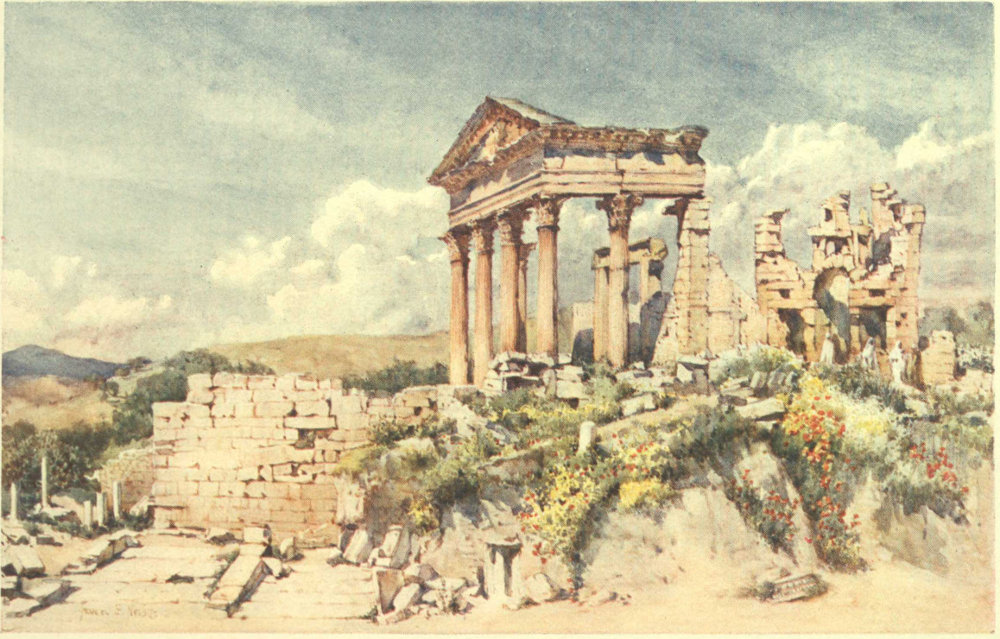
TEMPLE OF CELESTIS, DOUGGA
A primitive Arab village covers part of the site of the ancient Thugga. This is the simplest form of the name, but an inscription near the temple gives the following elaborate title, much too ponderous for daily use: “Respublica Coloniæ Liciniæ Septimiæ Aureliæ, Alexandrinæ Thuggensium.” The name was probably derived from the Berber, and means green grass. The city stands on a green hill, olive groves surround the ruins, and the valley of the Oued Khaled, a tributary of the Medjerda, is rich with green also.
Undoubtedly the most beautiful of all the ruins here is the great temple of Celestis, sometimes called the Capitol, which stands on the top of the hill, commanding a wide outlook, a really exquisite view of wood, valley, and mountains. The fine lines and proportions of this building, the situation, and even the warm, mellow tones of the stone, bring memories of Athens.
Time and weather have worn away the stone and added tender greys to the colouring, but have not greatly injured the grace of the fluted columns, the delicate work on the Corinthian capitals, or the richness of the mouldings. The sculpture on the pediment, however, has suffered much, giving the opportunity for many discussions as to whether it represents a lion, the rape of Ganymede, or the eagle of Jupiter. Wings are certainly visible, but the rest is a blur. The fine door of the cella is still perfect, and consists of three 134 huge stones bearing an inscription; there is another on the portico, which states that the temple was built by two brothers at their own expense:—
L. MARCVS · SIMPLEX · ET · L · MAR
CIVS · SIMPLEX · REGILLIANVS · S. P. F.
It was dedicated to Jupiter, Juno, and Minerva.
At the present time workmen are busy rebuilding the walls of the cella—a work which seems a sad waste of time and energy. The existing masonry, of a later date than the rest of the temple, possibly Byzantine, is of a style much used in North Africa, consisting of courses of stone laid horizontally, with upright bars of stone at intervals of about four feet, the square interstices filled with odds and ends of stone, like “the long and short bond” found in Roman and Saxon work in Britain. Bruce thought this “one of the most beautiful ruins of a temple in white marble in the world.” Playfair considers it as built of nothing less than Lumachella Antica, one of the lost Numidian marbles, now worth its weight in gold.
The theatre is also a gem, and though there is now no performance, it is still a joy to sit in the deep, cool shade on the almost perfect marble seats, and look across the stage and the broken columns to the sunny landscape beyond. It is finer in every way than the theatre at Timgad, and almost as large as the well-known theatre of Taormina.
At the entrance to the olive groves stands a triumphal arch of the decadent period, called Bab el 135 Roumi, or Gate of the Christian. There are also the remains of the temple of Saturn, baths, an aqueduct, seven cisterns like those at Carthage, a circus, a fortress, monuments, and many other ruins too numerous to mention. Last, and perhaps most important of all, because it dates from the Phœnician times, is the great Mausoleum, wrecked by the Arabs employed by Sir Thomas Reade to remove the celebrated bilingual stone now in the British Museum.
Though the men and boys spent the day in a circle round us to watch and to criticise, thoroughly absorbed in the sketch, yet they had charming manners, dignified and smiling faces, and not even the smallest boy dared to be troublesome—a great contrast to many in Algeria, who have picked up the bad ways of the modern town-urchins. The same may be said of Teboursouk.
At Medjez el Bab another display of fine courtesy was found in a most unlikely quarter. The hotel was said to be quite impossibly dirty, so we were advised to dine and wait for the late train to Tunis at a cabaret near the station. The place was a shanty, full of men drinking and smoking, colons and railway employés. Every one took our appearance as a matter of course, bowed politely, and did their utmost to make us feel at home, the smokers retiring outside. Dinner was served for us at a table apart, quite nicely laid and cooked. There was good soup, chicken, wine and dessert, all for a ridiculously small sum. After dinner some of the men wished to talk, asked many questions 136 about home and foreign affairs, and discussed the latest news of the war in the East. The wistful little woman who did the cooking could hardly make enough of us, and when the train arrived at last, no one would say good-bye, but only “Come again.”
Through darkness broken by hardly a gleam of light, and silence stirred by no sound but the throbbing of an overworked engine, in much weariness and at night, Tunis is reached at last with a suddenness which almost startles the traveller. The hours that passed so quickly in the morning, grow in length with the day, and after sundown every minute counts, and the hours in the dimly lighted carriages seem interminable; for travel in this part of North Africa is tedious and uncomfortable to a degree only known in Spain and perhaps sometimes in Italy.
Consequently the first impression of Tunis as one enters it by train is neither artistic nor Oriental, but rather a mingling of bustle and glare with much noise, followed by a rattling drive over paved streets, and the comforting assurance of rest. The arrival by sea has much the same disadvantages, for the steamer has a way of getting in after nightfall, so that the new-comer drives from the quay, along brightly lighted streets, side by side with an electric tram. This may 140 be a blessing in disguise, as the darkness hides the sordid details, and makes it possible, with some luck in the choice of a room, to find that a glance out of window next morning reveals the old Moorish city in the first blush of the morning light.
Tunis is still the “white city”—still also, in more senses than one, the “odoriferous bride” of the Arab writers. The other name of El Hadhera, the green, hardly seems so suitable from this point, for at an early hour the whiteness is more noticeable. The sunlight falls on the houses at an angle that suggests pre-arrangement, a scheme without a shadow. This gives a look of unreality, a curious lack of substance. If the actual lines were finer the effect would be that of a fairy city built of pure light, but as it is now, a later moment is more beautiful, when the shadows creep across the white walls and give value to the graceful forms of the minarets.
All this pearly whiteness is full of colour, though in the ordinary sense of the word there is little or none. What there is, however, is green, as becomes a Moslem stronghold. Far below, as it seems looking down from the roof, lies a garden full of orange trees and one feathery palm. This hardly comes into the picture, but a few other trees do, and one or two lonely palms, and the colour of the foliage is repeated in the wondrous green of some of the domes. The minarets and two or three of the mosques have pointed roofs of green tiles, and green also predominates in the tiles used for decoration; so that even in the heart of the city there is more than a mere suggestion of green.
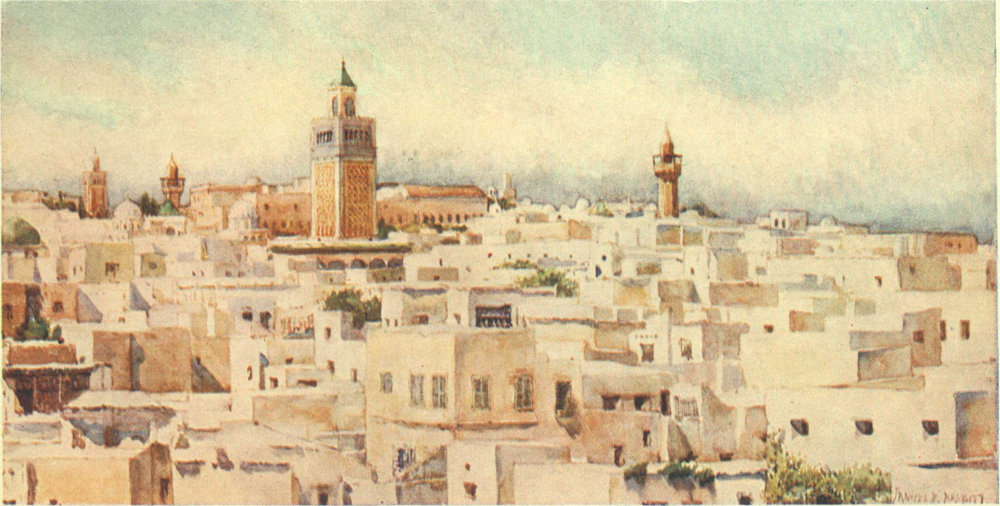
TUNIS
The walls and roofs rise terrace-like one above the other to the Casbah, which, as usual, is built on the highest point—blank walls mostly, with few windows (often mere holes), though occasionally a balcony with a tiled roof, shading a carved window-frame inlaid with bright tiles, gives a hint of taste or wealth. All these straight lines and plain surfaces are redeemed from monotony by the curves of domes and the height and variety of form shown in the minarets. The small fluted domes of the great mosque are dazzlingly white; the minaret is square, with delicate Moorish tracery in a yellowish stone; the upper story of marble is set with coloured tiles, and with an open gallery of horseshoe arches.
The minarets of Sidi Ben Ziad and Sidi Ben Arous are slender, octagonal towers of the same warm-hued stone, surmounted by turrets with jutting balconies quaintly roofed with green tiles, from which the muezzin sings the call to prayer. Much older, but not so imposing, is the square minaret of the mosque of the Casbah, said to date from A.D. 1232. Such is Tunis, a compact mass of white buildings, with no open spaces and no streets visible.
So old, and yet with such a continuous history, that although founded before either Utica or Carthage, it is still known by its original name. This name of Tunis is in Punic characters Tanaïs, and is identical with the name of the Persian Venus. Probably the city was 142 called after her, as other towns in Tunisia bore the names of deities. In those days Astarte, or Ashtaroth, combined the attributes and duties of Venus, Minerva, Juno, and Ceres, and was not only the goddess of beauty, the mother of love and queen of joy, but also the protectress of chastity, of war and of arms, and the patroness of corn and of husbandry. Such a divinity might well be invoked to take charge of a city, and in this case she evidently succeeded.
The city shared in the prosperity and also the evil days of Carthage and Utica, and, as a Roman province, endured all the changes in the life of Rome down to the fall of the Empire in Rome and Constantinople.
When the Vandals were cast out of Europe in A.D. 430, they devastated the north coast of Africa till they in their turn were driven by the Greeks beyond the mountains of the Atlas. Next, the Arab invaders swept over the land like a torrent, and in A.D. 644-648 took possession of Tunisia, which was thenceforward governed by Emirs appointed by the Khalifs.
The later history of Tunis, like that of Algiers, tells of a period of calm and culture, followed, after the expulsion of the Moors from Spain under the Christian kings, by a long chronicle of fighting and piracy; for thus these fugitive Moors vented their rage and avenged their wrongs on all seafaring people, merely because they were Christians. Slavery was carried on to the same terrible extent, for in 1535 no fewer than 20,000 Christian slaves escaped from the Casbah to open the city gates to Charles V.
Amongst other noted captives St. Vincent de Paul spent two years here in slavery, and in consequence devoted his after life to helping prisoners and galley slaves. An old house still exists with a fine courtyard, called even now the house of the Christian, which is said to have been built by a slave, who was killed by his owner as soon as the work was complete. The mosque of Sidi Mahrez, with its many domes, is supposed to have been the design of a French architect captured by the Corsairs.
A great part of the old walls and many of the gates still remain, and though modern buildings are closing round and gradually replacing the Moorish dwellings in the outlying quarters of Bab Djazira and Bab Souika, yet, within the magic circle, Oriental style, manners, and customs hold their own.
This is one of the many ways in which the French have gained experience in Algeria and profited by it in Tunisia. The old cities are left intact, instead of being destroyed to make way for new boulevards, and the French quarter, its public buildings, theatre, shops and restaurants, grow up outside the walls. The two races dwell apart, but both flourish together. Street names, lighting, and cleaning have been introduced, and the old town itself is incredibly clean for an Eastern city—cleaner by far than many cities of France and Italy. Though trams encircle the city and run through the suburbs, all proposals to disfigure the central quarter, the Medina, have met with a stern refusal. To walk through its gates is to step into another world—a 144 world as full of surprises and romance as it is of variety.
The old water-gate, the Porte de France, a simple horse-shoe arch, opens into a great hive. There, in a little open space, a swarming crowd, busy and noisy as bees, pushes towards the narrow streets which mount to the bazaars. At first East and West mingle. Then, step by step, the half-French, half-Levantine element gives place to the real East. “Bara Balek” (“Take care”) is the continual cry; and one must be watchful, or pay the penalty. It is true that wheeled traffic almost ceases, for the few carts generally only succeed in blocking the way, and must take hours to reach their destination. But strings of tiny donkeys, hardly larger than dogs, do all the work, helped occasionally by camels, which shove through the throng regardless of consequences. Then there are the porters. At first it is startling to see wardrobes, beds, or huge cases walking apparently on their own feet; but after a time the oddest loads are taken as a matter of course, a part of the universal strangeness of things. Yet it is wonderful to see these men in their characteristic dress, with bare arms and legs, and scarlet kerchief by way of turban, coolly walk off with a heavy weight that would take two men to lift at home. If it is so easy to bear a burden on the back by means of a rope passed round the forehead, why has not this simple method been adopted in the West? Thus, slowly, and in stately fashion, with all due regard for each other’s dignity, the crowd presses onwards to the heart of the city, the great Souks.
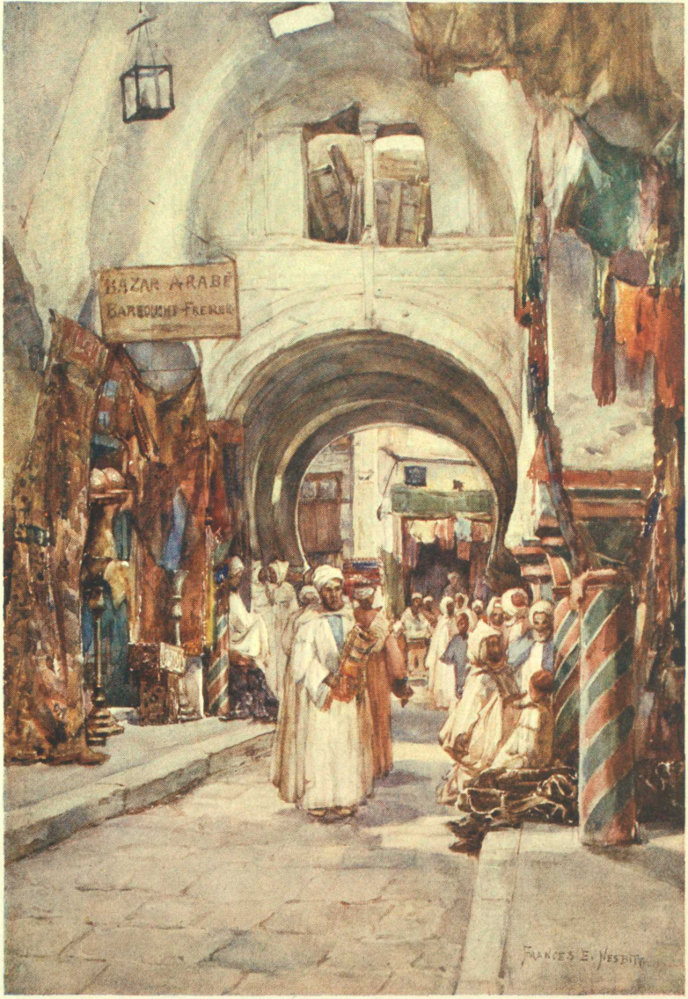
SOUK DES ÉTOFFES, TUNIS
There are no such Souks in all the near East. In Constantinople the men have discarded their turbans and flowing robes, and the vaulted halls though fine in form are cold and poor in colour. The bazaars of Cairo are quaintly informal, but lack architectural style, though the people are picturesque enough. In Damascus the buildings are modern, and look outside like railway stations with arched roofs, though within is seen the true and perfect life of the East, so unspoiled that the passing stranger feels his European clothes a positive eyesore, and knows that it is barely possible that the picture will be marred for him by any other intruder. Here the long vaulted halls, lighted only by rays of sunshine falling through square holes in the roof, are as fine as in Constantinople, and, in addition, are full of life and colour. The crowd is even more picturesque than in Damascus,—though here, alas! it is twice as difficult to dodge European figures,—whilst Cairo itself cannot show more quaint corners.
Each of the trades has its own Souk, and each Souk its peculiar character. Some only contain goods for sale, but most of them are workshops as well—a far more interesting arrangement. Bewildering, yet enchanting—a pageant of pure colour, where dusky twilight holds its restful sway, harmonising the tints, veiling the forms, filling the dark recesses with mystery.
Hour after hour, day after day, may be spent threading the mazes, watching and trying to decipher the open book that seems so full of ideas, some half-remembered, others wholly new, but all subtle and elusive, so different 146 to our usual life. Bible stories mix themselves hopelessly with the Arabian Nights, and the whirl of thought is as rapid as the change of colour.
The first day it seems impossible to think of finding one’s way alone through this intricate network, but gradually the main lines become clear, and then it is easy enough to wander in and out at will, with the certainty that confusion, or even total loss of bearings, means nothing worse than another turn or two, and then the sight of some well-known landmark.
Such a landmark is the Souk des Etoffes, very formal, absolutely straight, but decidedly the most distinguished of all. A low archway of horse-shoe form opens into a hall with three aisles, of which the centre forms the actual street, and the two others the side walks. Short and sturdy pillars, roughly but effectively painted in pure scarlet and green, support the arched roof. Rows of square cells on either side, dark yet glowing with colour, are packed with piles of silk and embroideries of every tone and texture, overflowing the narrow space within. They are hung on the walls and from the pillars in well-arranged disorder. Persian and Kairouan carpets deck the walls with rich, soft hues, old brass lamps from the mosques, of fine damascene work, stand side by side with inlaid furniture, odd-shaped mother-of-pearl caskets, weapons, and other treasures, all placed by a master hand so as to tempt customers to the utmost. In each tiny shop the owner sits dreaming over a cigarette, or entertains a friend or possible purchaser with coffee. In one corner, bright 147 with coloured tiles, a man whose whole equipment appears to consist of a charcoal stove, a pan of water, a wee coffee-pot, and some microscopic cups, does a thriving trade, and trots up and down the Souk continually to supply this pressing need; for without coffee nothing could be settled, nor any business done.
Watchful touts with keen eyes lie in wait for the unwary, whom they inveigle into the shops, whilst in a high-handed fashion they order about the real owner, who meekly obeys their orders. They pretend to bargain, but really raise the prices, which are preposterous even for the East, and of course pocket a large percentage themselves. However, they are very quick, and never forget a face, so that it is only the casual visitor who suffers. After a day or two one is free of the bazaar, and begins to have many kindly acquaintances. Bargaining is the game of the place, and a most amusing game it is to play. It demands infinite patience, much diplomacy, some instinct for fun, and, above all, either a real or a well-feigned indifference. The shopkeeper, impassive and smiling, has no hesitation in announcing that he will be ruined and his throat cut if he sells at such low prices. He is sure that anyone so exceedingly tall must be also extremely rich, or he tells you that your face speaks of riches. This was said to a very thin woman. But if the would-be customer answers in the same strain, the prices will descend by leaps and bounds, and on the conclusion of the bargain the ruined man implores his victims to come again to-morrow: “For, see, I have given it to 148 you because I like you; you are my friend.” In out-of-the-way shops a few words of Arabic are a great help, as the owner often says, “Makansch Francees,” which means, “No French here.” The language is a dialect, and few of the familiar Egyptian phrases are of any use. Even to be able to count in Arabic is something, as the officious person who usually appears to translate invariably doubles the price. But though the Arabs often talk excellent French it is a terrible drawback neither to understand nor to talk Arabic easily.
The Arabs declare that under the old régime business in the Souks was better regulated, and every trade had its own Sheikh, who ruled it with a rod of iron. He fixed the prices, and woe to the man who charged less or more, for when convicted the rod descended, and he was beaten then and there. The value of fruit, meat, and vegetables, etc., was announced by a crier at night, and next day each shop was bound to obey the order. This sounds somewhat tyrannical, but they liked it.
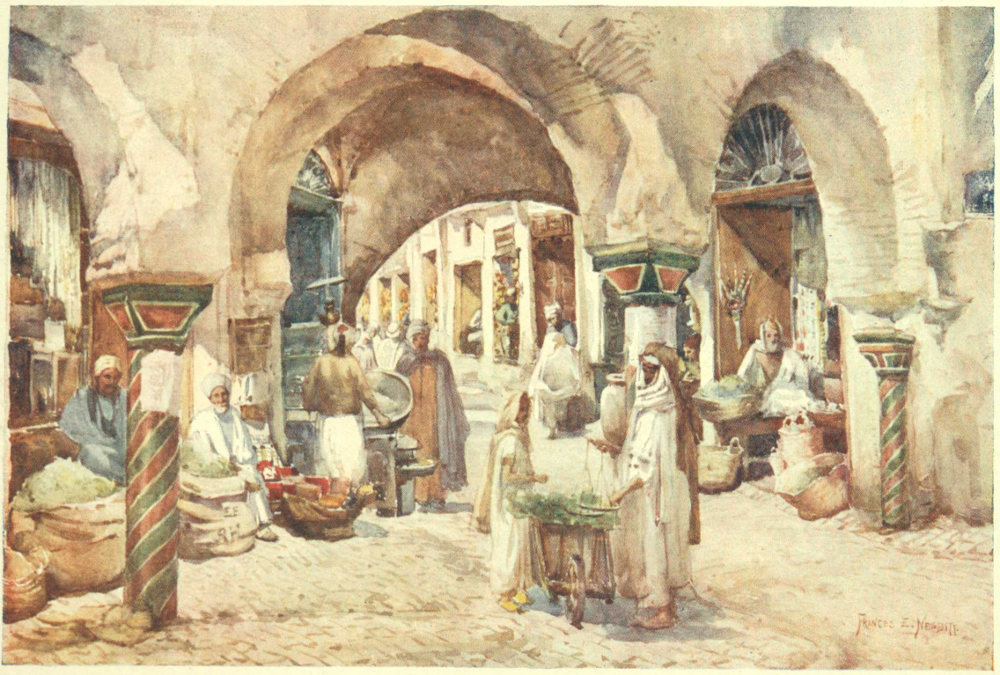
SOUK EL ATTARIN, TUNIS
The Souk el Attarin, or scent bazaar, is the aristocratic quarter, and the owners of these square cupboards, with huge painted shutters, are, it is said, nobles, the descendants of the Corsair chiefs, and often very rich; but, as good Moslems, they do not care to meet in each other’s houses, for that would upset their harems. Clubs do not exist, but in the bazaars all the news is to be heard and social life is to be found. So they spend their days sitting calm and imperturbable each in his niche, to which they mount with the assistance of a cord suspended from the ceiling. Enormous candles, gilded and fantastically coloured, hang like a curtain round them. In the mysterious recesses are jars and bottles, containing the priceless attar of roses, essence of jasmine, geranium, or amber, and countless other sweet scents. The whole bazaar is full of perfume, making it a pleasant place to tarry in. On the ground are baskets and sacks filled with dried leaves, or piled with green powder, both preparations of henna. Outside each shop stands a chair or two, on which grave elders rest and talk. Younger men stroll about, true types of Moors, their handsome, smooth faces equally calm. They are great dandies, and wear robes of soft cloth and silk of most delicate tints. On festivals they place a flower coquettishly between their turbans and their ears, which gives a curious touch of the feminine to their appearance. Some also carry a rose or carnation in their hands “to live up to” in true æsthetic style.
No one bothers about business: they are too dignified for that. Only once did anyone ask us to buy, and when we said “another day,” we were adopted as friends, to be greeted placidly and talked to occasionally, and we found ourselves remembered and on the same footing another year.
The Souk el Blagdia, or the shoe bazaar, is quite different. The street is narrow, there are no gay pillars, the roof is of wood, the shops are a trifle larger, and hold one or two men who are ceaselessly at work. They make the soft yellow and red slippers which the Arabs wear, and keep on so easily, though 150 they are such a failure when Europeans try them. Here life is earnest enough, and so it is in the bazaar of the tailors, where the shops are larger, and divided one from another by the usual green and red columns. In each shop eight or ten men and boys, many of them Jews, in the distinctive dark blue turban, squat on the floor, sewing busily. They stitch, embroider, and decorate most elaborate outfits, cloaks of every colour in and out of the rainbow, and of the most perfect shades. You can see them at work upon gandourahs of deep red silk, embroidered in green, and tiny jackets for boys, of pale yellow, orange, and red, whilst the finished garments hang as draperies behind their heads, and the sun peeps through the rough splintered boards of the roof and sends shafts of light that flicker and change as they touch the moving crowds. The jewellers dwell in a narrow passage, and hardly display their goods at all; some silver jewels, mostly hands of Fathma, and a pair of scales, being perhaps all that is shown, but a big safe gives promise of hidden treasures. Near by is the old slave-market, a picturesque hall, dark and lonely, with the usual gay pillars and but few quiet shops.
The Souk des Femmes, like many others, is a white tunnel lined with shops. It is very crowded in the early morning, and is almost the only place where many women are seen together. Some sit on the ground and sell their own handiwork, others are busy bargaining for veils and embroideries. All are of the poorer class and heavily veiled, if two strips of black crépon covering the face like a mould, with half an inch gap between them for the eyes, can be called a veil. It is quite hideous, and, as the rest of the dress is white, makes them look like negresses.
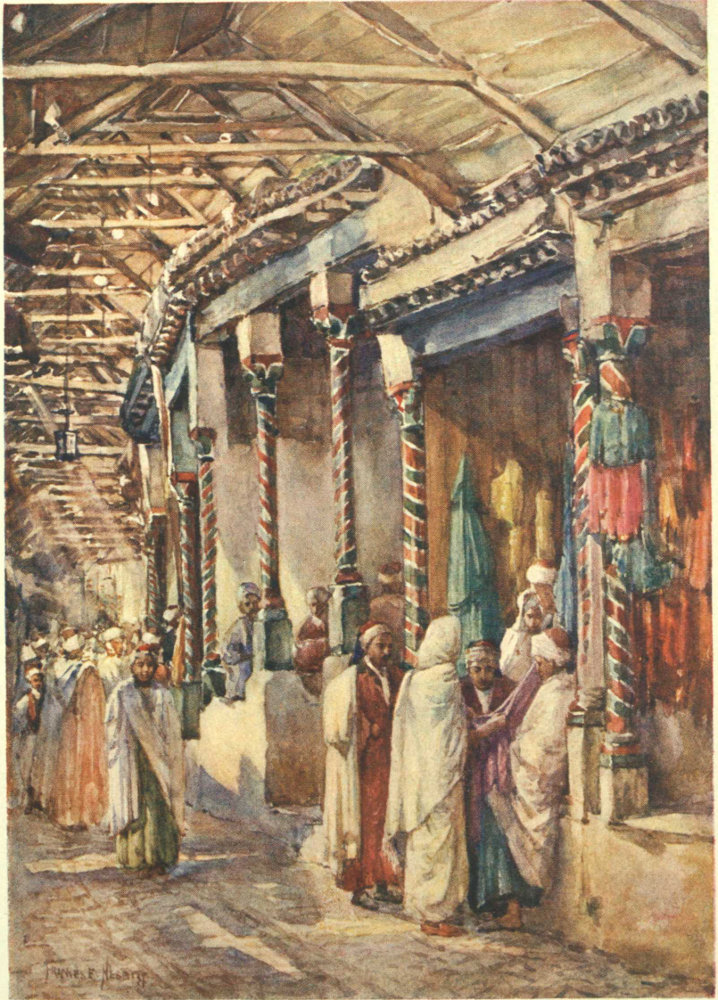
SOUK EL TROUK, TUNIS
One bazaar is full of terrible compounds of dates and figs, dried fruit and grain. Another small street is given up to the sieve-makers, who weave their webs at looms which look like strange musical instruments. In many places baskets and mats are made. Silk weaving and the making of belts and scarves are other flourishing industries, and to stand and watch the long, slim fingers moving quickly at the old-world looms is a sight that one never tires of watching. Hands and feet come into play together at the turners and the cabinet-makers in a long street of many arches. Deft fingers and delicate handling are seen also at the copper-workers. In fact, at every turn there is something strange or beautiful, and at the least entirely different to anything we do, or see at home. The harness-makers rival the tailors in the brilliance of their goods. Gorgeous saddles there are, with red and gold and silver decorations, marvellous saddle-bags also, gay with stripes and tassels. They sell huge hats, at least a yard in diameter, with narrow crowns a foot high, ornamented with quaintly-cut leather and bright balls of wool. They make cushions and odd-shaped pouches and money-bags, and leather amulets to carry the charms without which no one can live, and round mirrors for the women. Their bazaar is also noted for the tomb of a Marabout, a gaudily painted sarcophagus which almost blocks up the narrow gangway.
After this the Souk where the lawyers sit waiting for business, and now and then writing a few letters which earnest men dictate to them, seems tame, and the libraries are quiet too; but another turn lands you amongst truly magnificent boxes painted and inlaid.
So the show goes on, at once grave and gay, from year’s end to year’s end, always the same, as it has always been, and so may it long continue.
All the more important Souks have thick roofs, and consequently keep cool in the hottest weather, so that even when the thermometer stands at 100° in the shade, the bazaars seem quite fresh, almost chilly at first, as one steps into the dark out of the sunshine.
Some of the small bazaars, however, in the poorer quarters are only protected by shutters, blinds, awnings, rags, or anything that will keep the sun away. How strange this sounds to us! Such a street is the Souk el Belat, a name which is said to mean “a paved street”—hardly a distinctive title in a town where all the streets are paved. The shops are queer little places, some full of strange, unknown commodities, and others full of food of various sorts, which the owners have to protect by flicking it with fans or whisks, as the flies are so troublesome. The beauty of this street lies in its windows, which are screened with ornamental wrought ironwork.
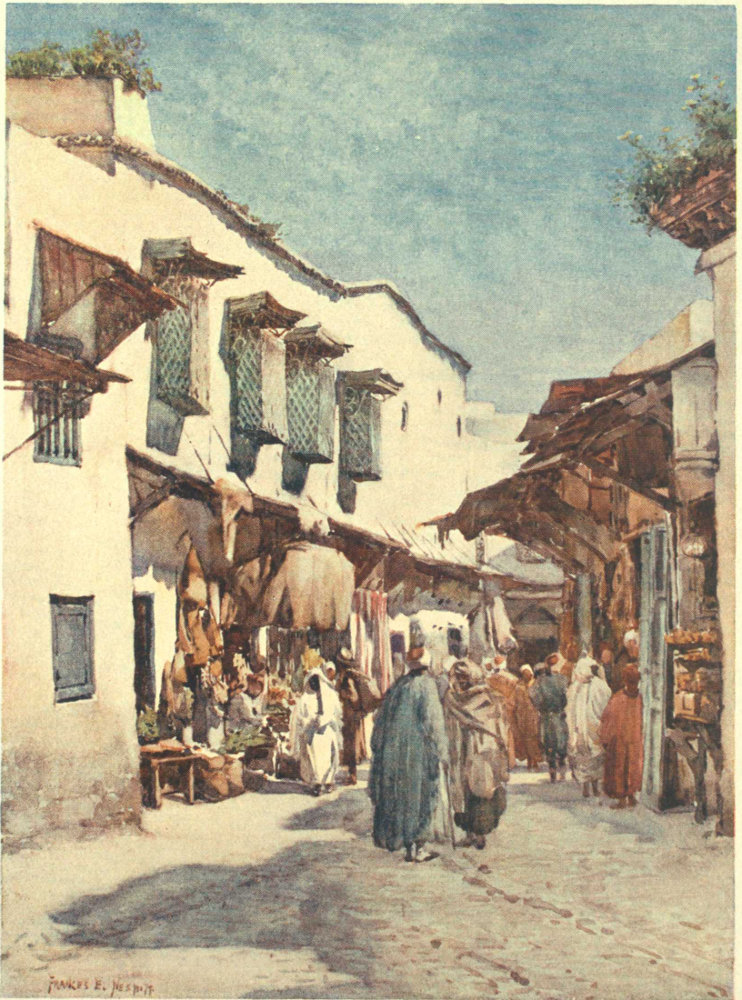
SOUK EL BELAT, TUNIS
Another constant amusement is to watch the informal sales by auction. Men walk up and down laden with various goods and chattels, embroideries, or lengths of silk, shouting a price as they move along. The bystanders occasionally make a bid, or nod, and in time a bargain is made. Furniture and carpets are sold in an open space at the end of the Souk of the tailors, just under the windows of the Bey’s Palace. The auctioneer usually sits on the object, if it is big enough, and the bidding goes on in leisurely fashion, but with a deafening noise, for hours together. It is a grand place for seeing life, for crowds always collect, especially on the days when the Bey comes to Tunis, and they stand and watch him as he sits in a gilt chair near a window, resting after his morning’s work. He has a decided advantage over his subjects, as they cannot see him properly, whereas he has a series of peeping-holes in all his principal rooms, and can see and hear all that goes on in the Souk, without any one guessing at his presence.
A gem of a mosque, that of Sidi Ben Ziad, stands in this street, catching the sunlight on the characteristic black and white marble façade, on the splendid green tiles of the roof, and on the most beautiful minaret in Tunis. When the call to prayer is heard at mid-day echoing from the gallery, the listening crowd of Arabs set their watches and disappear, some to prayers, others to dinner, and the noise and bustle is succeeded by the silent emptiness of a buried city.
In all Tunisia, except at Kairouan, it is a forbidden pleasure to visit the interior of the mosques. Even furtive peeps are guarded against, by large green screens in all the open doorways. This is especially disappointing at the great feasts, though the scene in the bazaars ought to be compensation enough.
On the 26th of May, the birthday of the Prophet, the Bey goes in state to the great Mosque, a pilgrimage that he only makes twice in the year. It is situated in the heart of the Souks: doors open into the court from every side—one with a flight of steps, a terrace and colonnade; another, in the Rue des Libraires, with a beautiful porch and green-tiled roof; the rest with no architectural interest. It is called Djama el Zitouna, the Mosque of the Olives, and many of its pillars are spoils from Carthage.
In honour of the occasion, or of the Bey, the Souks are decked with carpets and wonderful embroideries; every space on the walls is covered till the whole is aglow with colour. The way to the mosque is packed with the Faithful in gala dress—men and boys alike in exquisite tints; for the Tunisians have an innate sense of colour, and blend and combine hues that would be unthinkable elsewhere, although the result in their hands is charming. The Arabs say that it is the sunshine that makes the harmony, and that that is the reason why imitations of Moorish decoration look so garish under our cold grey skies. On such a day the flowers behind the ear add a touch of perfection to the radiance on every face. Each shop in the street of the tailors looks like a collector’s cabinet of idols, for the master sits cross-legged in the centre, motionless as an image of Buddha, with his men round him. When the Bey has passed, the shops are closed and the festivities commence. As night falls the illuminations begin. All the minarets are outlined in light, and the square in front of the 155 Palace is a fairyland of cherry-coloured Chinese lanterns. It is almost impossible to move, and the gendarmes are already closing the entrances to the Souks, but way is promptly made for such important people as ourselves, and we walk down the familiar street with our proud guide and find it all new and strange.
The details are extraordinary, a true picture of the East, where horrors in the shape of European novelties are set side by side with treasures of Oriental art. Here no sort of contrivance for giving light has been despised. Queer old lanterns and sconces alternate with common lamps, flambeaux, old lustres, and glittering glass chandeliers. It is all incongruous—absolutely wrong from a properly artistic point of view, but that does not matter in the least. Light and an air of festivity are what is wanted, and, let purists say what they will, the effect, though amusing, is as delightful as it is unusual, making the colour of the gay crowd if possible more entrancing than in the morning. From the dignified shelter of one of the biggest shops we sit and watch the moving throng, and prepare to receive the Bey. Presently the procession appears, and adds a last touch of incongruity by its want of order. Soldiers and guards in a travesty of European uniforms lead the way. Some look like old watchmen, as they stoop and carry lanterns dating from the days of Dogberry. The Bey is also in uniform, with stars and orders, and jewels in his fez, and is followed by his chief officers. Even for this occasion they abjure native dress, and so the very least of all his subjects appears with more dignity 156 than himself. The great man approaches smiling, salutes the owner of our shop, condescends to enter, drink a cup of coffee, and talk a little, then passes through the rooms, and every one rises and bows, whilst he with many salutes goes his way to the mosque. He never fails to pay a yearly visit of ceremony to this old dealer, or to traverse all the main bazaars, and he sometimes calls on one or two other merchants. After the service is over, fireworks wind up the proceedings. Thus do the Tunisians celebrate the birthday of Mohammed, whom they believe to have been so unlike and so superior to other men; because, as the legend says, all children are born with a black spot in their hearts, and when God chose His prophet, an angel opened his heart and took the natural stain out of it, so that he alone of all mankind had no taint of original sin.

TUNIS FROM THE BELVEDERE
Even in the quiet and silent streets of Tunis, where every footstep echoes between the high white walls, the hum of the distant hive can still be heard. The streets even of the rich quarter are never straight, but meander in and out, and are withal so narrow as to fit to a nicety the lumbering old carriages that convey their stately owners about the city. No two vehicles can ever attempt to pass each other, but have to manœuvre down side alleys. Now and then the red blinds are tightly closed, which means that the ladies of some harem are taking an airing. But this is rare, for the poor things have a very monotonous life in Tunis, are never allowed to walk, do not seem, as at Algiers, to picnic in the cemeteries, and seldom even drive.
Poor women are little seen in the streets, and those of their rich sisters who have no pretensions to rank are only permitted to walk about occasionally, and then do so under the surveillance of servants, and with such heavy silk veils that they must be almost smothered. These so-called veils are of black silk, with decorative 160 borders and fringed ends of many colours. The width is considerable, and the length sufficient to cover the head and fall nearly to the ground on either side. Exactly in the centre a small square of thinner material is let in, but the wearer, in order to breathe and see the ground at her feet, lifts the lower border a few inches with both hands, and then toddles along in her high-heeled slippers. Over the black veil comes the white haïck completely covering the whole figure.
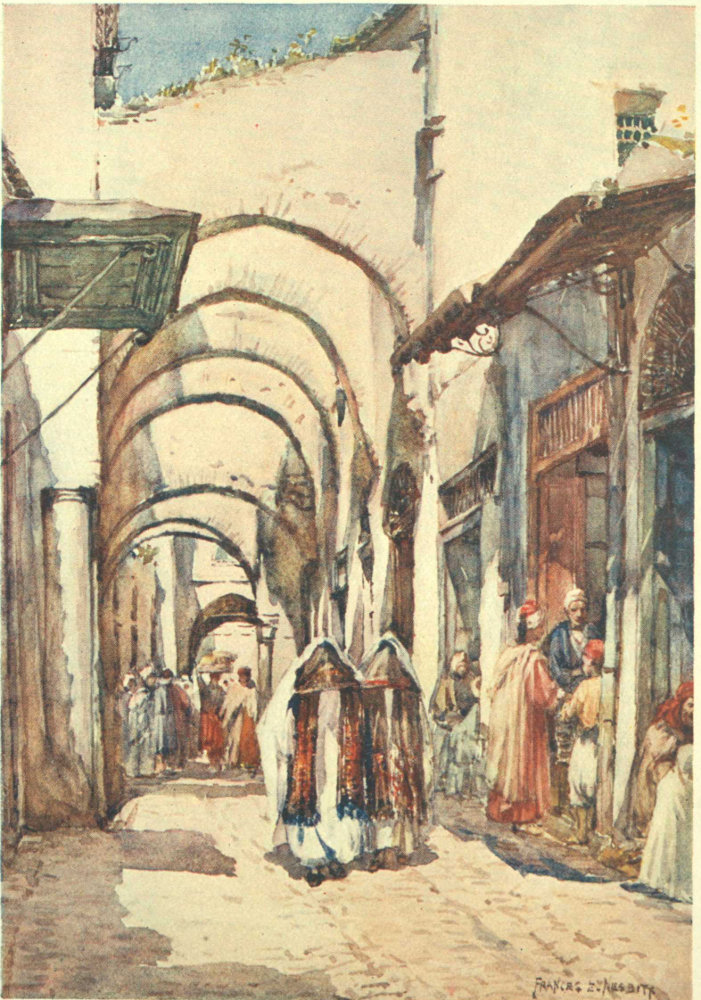
A STREET OF ARCHES, TUNIS
These veiled women, the closed carriages, the elaborate wooden or wrought-iron screens that mask the windows, and the air of reserve about the houses, all hint at a strange life within. The very doors open in such a way as to reveal nothing of the inner court, and the gay flowers in the windows alone show visible signs of a woman’s care. The closed doors are the symbol of secrecy as impenetrable as the women’s veils. When, as occasionally happens, some story of the life of the harem is allowed to leak out, the tale is always of terror, cruelty, and persecution. Not that a visit to a harem is at all tragic—quite the reverse; for though it is no new thing to be amused, it is rather unusual to find oneself so amusing, to see that no detail escapes criticism, to hear endless comments, and understand nothing but the smiles, the gestures, and the stroking of soft fingers. It is all guesswork from the moment that the beautiful being, who acts as Cavass to the Consulate, hands over his charges to a smiling woman, with a great horn on her head, covered by a haïck, the dress of a Jewess, who is to act as escort. With becks and nods and many smiles, for she knew only two words of French, she dived down street after street and along narrow passages, which we could never find again, till at last she stood at a door and knocked. Almost noiselessly it opened, and we found ourselves exchanging solemn greetings with our host, who sat on a divan in the entrance. Having welcomed us, he allowed our guide to lead us into the covered court filled with a gay throng. Such a hubbub! Music and singing and long drawn-out trilling cries of joy, for this was a party after a wedding. A group of women with musical instruments sat on a mattress in one corner, and sang and played at intervals, while the rest of the company formed a circle on chairs and divans. As soon as we entered every one crowded round us, and we were stroked and patted, given coffee and chairs, before the serious business of examining all our possessions began. Our first breach of etiquette was that we forgot to unveil. Our hostesses frowned and pointed till the objectionable bit of net was removed. Hats were of no consequence, as head-dresses were worn, handsome kerchiefs of all colours with fringes, and many jewels on the forehead. The dress consisted of sleeveless embroidered coats over lace jackets or ordinary low bodices, full trousers of rich brocades and satins, or, in the case of visitors, of white cotton with stripes of insertion and ribbon down the front, white stockings and smart shoes. Beneath all this finery their necks and arms were covered by ugly striped vests, so, decidedly, the inherent good taste of their lords is not 162 shared by the ladies of the harem. They were all short and generally stout, handsome in a rather heavy way, with thick, painted eyebrows, darkened eyelashes, and henna-stained hands. They peered into our faces to try and discover paint and powder, took off our gloves to see our hands, admired some real old lace, and, having got over their first fear, fell absolutely in love with a fur stole with little tails and claws. Our simple gold chains and watches and our lack of other ornaments evidently surprised them, as they were adorned with golden cables and plaques of gold and brilliant blue enamel. It was most embarrassing to talk by signs, and our few words of Arabic were soon exhausted. All their treasures were displayed: the mother-of-pearl coffers, the great divans, the French bedsteads hidden in alcoves. On one divan, two pretty imps of children were lying with their faces buried in the cushions. The women explained that they were in terror at our great height; they had never seen such monsters. By force of contrast our slender, dark figures may have appeared gigantic, but what would they have thought of some of our six-foot friends? Before we left we had the pleasure of watching some of them dress to go away. Some changed their socks into commoner ones for the street, then the black veils went on, and after that, with deft grace and subtle twist, the haïcks were arranged. Then they were ready to face anyone, even their host in exile at his own front door.
There was nothing remarkable about the house, but 163 the interior of many of the old buildings is very fine. The rooms, opening out of the usual courts, have carved ceilings and delicate stucco work, after the fashion of the Alhambra. The effect is generally spoilt by European hangings, carpets and furniture of the worst period of the nineteenth century.
The Bey has some beautiful rooms in his town palace of Dar el Bey, where fine old work is, with the same want of knowledge, marred by the addition of gilt clocks, glass chandeliers, and poor carpets, so that it is a relief to escape to the roof and look out over the city, and try to trace the whereabouts of streets and bazaars hidden in the mass of white.
The Bardo, or show palace, in the country suffers even more from the same want of artistic feeling. Built mostly of marble, an imposing staircase, flanked by lions couchant, four on each side, leads to an open loggia and a fine court with horse-shoe arches, slender columns, and the usual fountain. Other halls and courts, beautiful in Moorish style, have the exquisite lace-like stucco that is almost a lost art nowadays, and wonderful ceilings; but each hall contains gilt chairs, the inevitable clocks, glass chandeliers, terrible portraits, even cheap lace curtains and Brussels carpets with glaring patterns, for which there is no possible excuse, as the bazaars are full of splendid native carpets and hangings of harmonious colourings and suitable designs. However, the guardians are prouder of the enormities in the way of portraits than they are of the place itself.
In the rich quarter the only other buildings of note 164 are the many white domes of the Marabouts, or tombs of the Saints, and the yet more attractive green domes that cover the burying-places of the Beys. These can only be admired from the outside, as they share the sacred character of the mosques. Green tiles also appear as roofs for fountains, and are sometimes supported by antique columns. Numbers of these columns may be found all over the city embedded in the walls and covered with whitewash.
The Hara, the old Jewish quarter, no longer holds the enormous population. The old rules are things of the past, the gates are no longer closed at night, so the overflow fills the surrounding streets and gives its own indescribable touch to the whole district. The old men still wear the dark turbans and blue or grey clothes, but the younger imitate the Moors if poor, and if rich the Europeans. Driving is now a favourite amusement, possibly because formerly those who possessed donkeys might only ride them outside the city walls, and horses were entirely forbidden.
Now every peculiarity of Eastern life seems intensified if not doubled. Twice as many people as in the Arab quarter crowd into still narrower streets. Noise and confusion never ceases. There are certainly fewer shops, but the dirt is more than double, and as for the smells, the variety is greater and twice as strong. Even the name of the main street, Souk el Hout, or “Fried Fish Street,” suggests this.
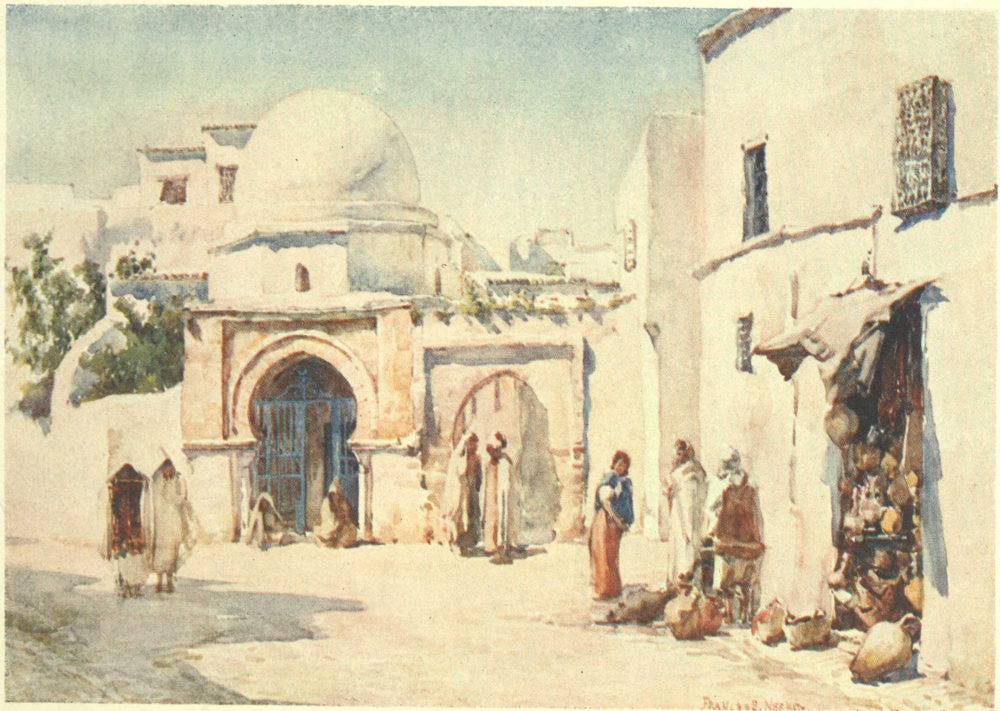
THE ZAOUÏA OF THE RUE TOURBET EL BEY, TUNIS
Women and children abound, so do beautiful faces. This is difficult to realise, till the first shock caused by seeing so many unwieldy forms has been got over. All the married women, however young, are moving mountains of fat. It is considered their greatest adornment, and they are systematically fed on sweets and fattening foods all day long till the requisite result is attained. No one ever seems to fail in the effort!
Before the process begins the girls are lovely and graceful, and their method of winding a wide piece of striped material round them by way of a petticoat shows their slender frames to great advantage, whilst the gay kerchief on their heads contrasts brilliantly with their dark hair and eyes.
The married women wear a quaint head-dress consisting of a gold embroidered horn, kept in its place by twisted scarves of black and gold silk. Out of doors the haïck is draped over it—a fashion said to be a legacy of Crusading times. The rest of the costume is hideous, and appears to be designed to accentuate the stoutness as much as possible. A short and loose coat is worn over white trousers that are also short but tight; and though the coat of silk in vivid colours is worn over a lace shirt with full sleeves to the elbow, that does not help matters much. Out of doors the all-enveloping haïck is useful as a cloak, but indoors, in one of the big courtyards where countless families live and work together, these prodigious figures can neither be overlooked nor ignored.
Going from quarter to quarter sketching is like moving into a different country. Amongst the Arabs and the Moors, whether rich or poor, the same courtesy 166 is always to be found. Although an Arab thinks it wrong to draw any living thing, and believes that an artist in reproducing a man’s image gains power over his soul, yet he will gravely permit his shop to be used, and quietly prevent anyone getting in the way. Some Mohammedans carry this curious belief still further, and imagine that in the next world a painter will be surrounded not only by the souls he has thus appropriated, but also by those he has created through the power of imagination; but in any case, and whatever their creed (though here and there a saint may frown), the men of Tunis are always considerate and kindly. As for the boys, they are a marvel—almost too good. The magic word “Balek,” or a wave of the brush, keeps them at a reasonable distance, and there they will stand quietly watching for hours. The regular street-urchin with his short striped coat and hood, his ready basket, and his cry “Portez, Portez,” is just as virtuous as the dainty little gentleman in silks and fine linen.
Only once did a difficulty occur, and that was in the Place Halfaouine, where the story-tellers draw such crowds. As we walked down the very untidy picturesque Souk (it is a poor district), an unearthly yell was heard, as a huge gaunt man leaped up from a divan. His hair was matted, and he was so filthy that lumps of dirt stood up on his bare legs, so there could be no doubt that he was a saint. A small sketch-book or a kodak excited his ire, and he dogged our footsteps, circling round us like a bird of prey. When we stopped he sat down uttering strange shouts or yells from time to time. If we looked at anything or moved the camera the yells became more fierce and insistent. As he was obviously crazy and an extremely powerful man, it would have been out of the question to upset his holiness any further. So, as no story-telling was going on, we turned back. He followed us up the bazaar, under a running fire of half-jeering remarks from all the shops, which troubled him not at all. His duty was done: he had succeeded in getting rid of another painter, and when he reached his own divan he cast himself down with a final howl of relief, and we were free once more.
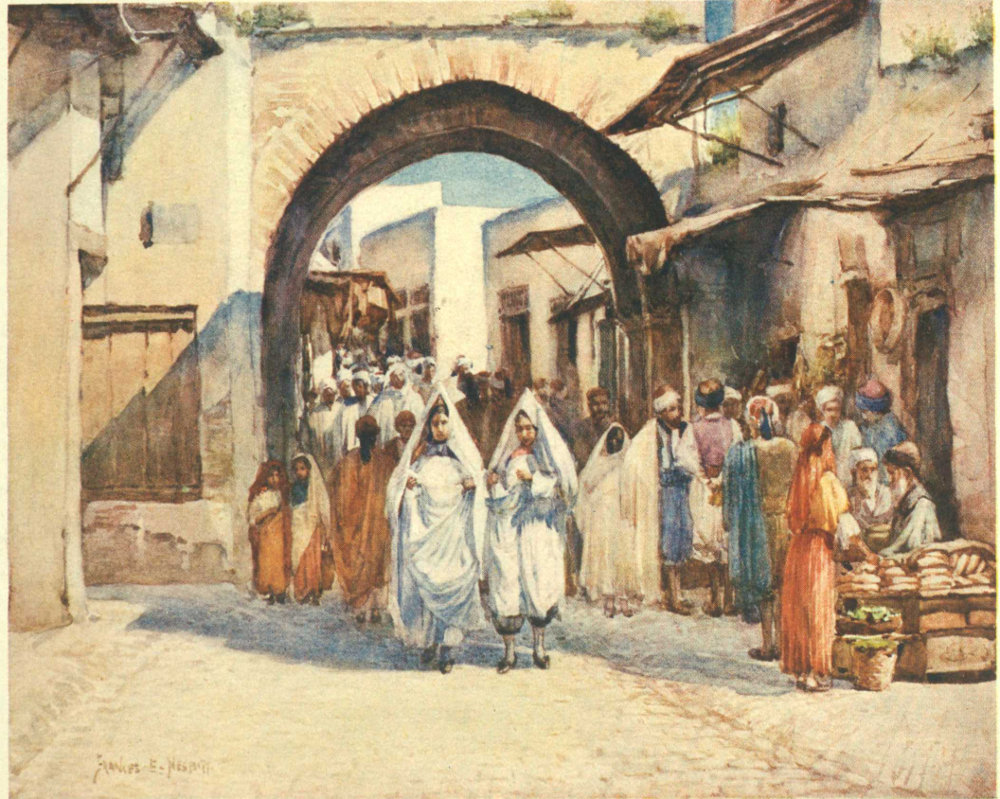
SOUK EL HOUT, TUNIS
One statement often made in the Arab quarter comes with rather a shock to insular prejudice. Sometimes an Arab, but more often a Maltese, Indian, or Levantine, in full national costume, says, “You Ingleez? I Ingleez same as you,” and promptly relapses into French, as those are the only words he knows of the language which he claims as his own. It is usually quite true, nevertheless, because even now they gain security and protection by naturalisation, and formerly it was their only safeguard.
In the Jewish quarter sketching is by no means so easy as amongst the Mohammedans. Not from any want of civility or friendliness, but from over-interest and want of comprehension. Strangers are uncommon and therefore exciting, a crowd soon gathers, and becomes so dense that the victims are almost smothered. One day a big smiling fellow came to the rescue and proceeded to keep order in his own way: first with 168 a stick, and, when that failed, with splashes of water from a copper pot, which he replenished continually. Naturally there was a tremendous outcry; the crowd beat a hasty retreat, only to re-form immediately. It took two men all their time, with much assistance from gendarmes, to enable us to get that sketch finished, whereas in the Souks one small boy was ample protection. Another quarter is called “Little Malta,” and the curious arrangement in black silk that the women wear, half-hood, half-veil, is a picturesque addition to the many national costumes seen in Tunis.
The Italians have also their own quarter, which might be a fragment torn from Naples or Palermo, so identical are the manners and mode of life. Even the macaroni hanging out to dry is not forgotten. They greatly outnumber the French, and have been a source of considerable trouble, as Tunis was the refuge of fugitive criminals from Italy and, indeed, all parts of the Mediterranean. Although their advent is now forbidden by law, and murderers are calmly returned to their own countries, yet there are still enough desperate characters left to make things difficult for the authorities, who would like to keep up a pose of virtue on behalf of all Europeans. In sober truth, however, most of the frays and robberies are the work of the mixed low-class population.
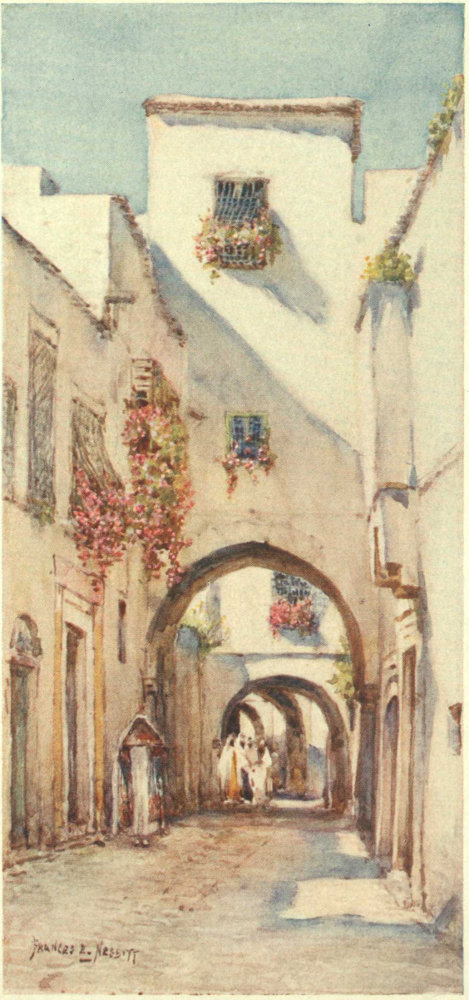
RUE TOURBET EL BEY, TUNIS
In Mohammedan Tunis, outside the Medina, perhaps the most typical quarter is that of Bab Souika, of which the Place Halfaouine, already mentioned, is the centre. Full of cafés, it is the scene of wild excitement during the month of Rhamadan, the great fast of the Mohammedans, kept, it is said, because Adam wept for thirty days when he was driven out of Paradise, before he obtained God’s favour and pardon. The fast is so strict that from sunrise to sunset no food whatever is taken, not so much as a cup of coffee, or even a drop of water on the hottest day, and smoking is also forbidden. Then when the sunset gun is fired, feasting and revelry begin, and are kept up all night. A certain gaiety and good humour is visible at all times. There are as many cafés as in the main street in Damascus, and in the afternoon they are always full of men smoking, and playing games. A young story-teller with the face of a monk holds his audience entranced by his dramatic talent. He not only tells his tales, but lives them. He has an endless flow of words, and never pauses except for effect. The listeners form a circle round him, either standing or sitting on the ground, wholly absorbed in the story. Snake charmers are his only rivals in the afternoon, but at night dancing goes on in some of the cafés.
Silk weaving and pottery are the industries of the district: one long bazaar is given up to weavers, and a row of queer, square shops to the sale of pottery. Porous water-jars, beautiful in form—some plain, others roughly decorated in dark lines, both wonderful for cooling water by evaporation—cost only a few sous. Green pottery for ordinary household use of a more durable kind, designed with a most unusual quaintness, is also to be had.
Another open space, devoted to snake charmers and a sort of rag fair, is to be found near Bab Djedid, the finest of the old gates. Old rubbish of all sorts—brass and iron, rugs, rags, glass and pottery, mostly broken—is spread out on the ground, and behind each little heap sits its watchful owner. A few women, usually Bedawin or negresses, bring food and grain, which they pile up on cloths, laid in the dust. Hither come all the strangers—men from the country and the desert, and here again the triumph of Tunis over all the cities of North Africa in the matter of clothing, of all varieties of shape and colour, is made manifest.
Here is no dull uniformity, no monotony, as in other places. The well-known white folds of the burnous may be admired once more, but raiment of camel’s-hair, in tones of warm brown, quite alters the scheme of colour. It is fashioned into a gandourah—a long, hooded coat or shirt reaching to the knees. Sometimes, however, the gandourah is hoodless, of a very dark brown tint and braided with white. Again, it is often striped in natural colours, or with threads of red and blue, but occasionally plain dark-blue is seen. Very often the wearers of brown burnouses might be taken for Franciscans, but when blankets with stripes and fringes are in question, no one but an Arab could arrange them with such unconscious art.
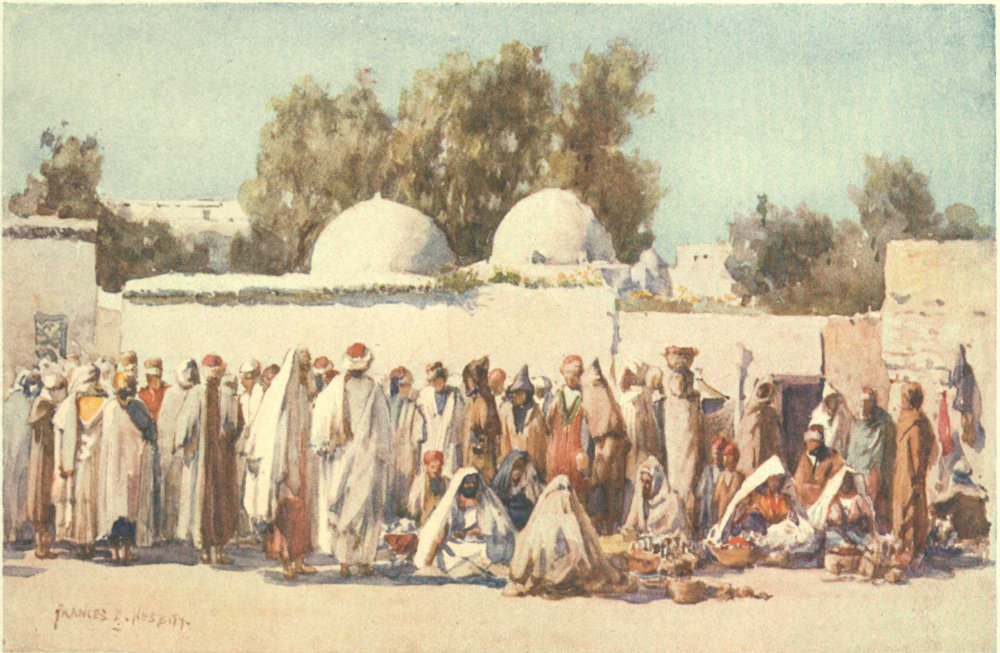
RAG FAIR
Long draperies and floating folds may outshine the Turkish dress of embroidered coat and vest, gay girdle, and full, short trousers, supplemented by a cloak, but it is equally popular. The same costume, without the coat, in white or drab, is worn by pedlars and fruit-sellers. Their legs are bare and their feet slippered; socks and shoes are pure luxury. These fruit-sellers are a joy. They own tiny donkeys, and lade them with huge open panniers of sacking, or queer double twin-baskets, lined with green, and filled with oranges in winter, and by the end of April with apricots or almonds. Fruit is both plentiful, cheap, and varied. The province was once the Roman granary, and could still do much for Europe in the way of luxuries, as well as send over great supplies of corn and olives.
The cook-shops have also fascinations. They are all dim and dark, mysterious with the smoke of ages and the steam of the moment. Dim figures flit busily to and fro, stirring strange ingredients in huge pans over their charcoal fires. Coloured tiles give relief and gaiety to the entrance, cover the stoves, and form a sort of counter. In early morning the maker of pancakes has it all his own way; at dinner-time he of the cous-couss does a thriving trade, and at night, and all night through, it is said there is a great sale for a special kind of peppery soup.
The walls and gates on this the southern side of Tunis are of great antiquity, and consist not only of the original walls of the old town, but also of an outer circle with five gates enclosing the suburb of El Djazira. Within its boundaries are held horse and cattle markets, which no doubt account for the variety of tribes and costumes to be seen.
Through the outer gate come caravans from the 172 desert, and camels laden with fodder and fuel. Men and camels find a lodging in the many fonduks near the Bab el Fellah—resting-places as primitive and patriarchal as the caravans themselves.
From the hilltop outside the walls is a superb outlook over the city, and also across the salt lake to the mountain of Zaghouan, though for pure charm it is outdone by the view from the park-like grounds of the Belvedere, some distance out of town through the curious double gate of El Khadra.
Only a few years ago the barren hillside was skilfully laid out and planted with trees, and already the ground is carpeted with wild flowers, and the eucalyptus has reached a respectable height. The delicate grace of the pepper trees and the silvery grey of the olive mingle with masses of mimosa and acacia, Judas trees, and many flowering shrubs, to give their own brightness, and fill the air with perfume. So once more the country has a chance of returning to its earlier aspect before the Arabs cut down forests and olive groves for firewood, after their usual extravagant custom.
It is a pleasant place truly in spring and in summer, and the nearest refuge from the heat. Here many jaded Tunisians linger in the comparative freshness till long after midnight, though, being French, they must needs have a theatre and casino to amuse them. They have also transplanted and restored two Moorish pavilions that were falling into ruins, owing to the curious local custom by which no Bey, or exceptionally rich man, may dwell in the same house in which his predecessor died, but has to abandon it entirely. Probably a survival of ancestor worship.
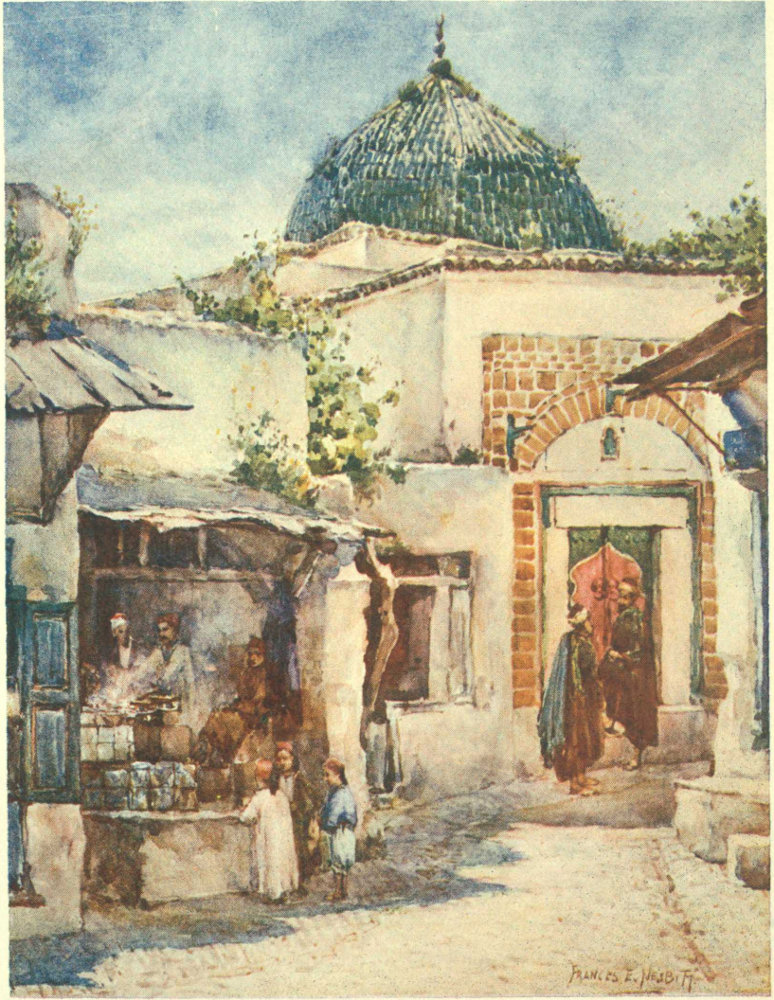
THE FRITTER SHOP, TUNIS
Whether the Arabs appreciate the ever-changing beauty of their country or no, their descriptions never vary. Tunis incontestibly merits the title of the “white” as it stretches across the isthmus dividing the stagnant lake of El Bahira from the salt lake, Sedjoumi. It certainly might be “a diamond in an emerald frame,” though a pearl would express the white wonder amongst the green with more precision. As for the familiar “burnous with the Casbah as the hood,” surely they might have invented a new simile, though it is apt enough.
The forts on the hills are no concern of theirs, for, like the aqueduct in the plain, they are picturesque legacies of Charles V. The harbour full of shipping is a thing of to-day, and so is the modern town. La Goulette (Halk el Oued, or the throat of the canal), glittering at the further side of the lake, is of yesterday; its importance gone with the new canal, but its Venetian charm happily undimmed. Carthage and La Marsa, a third lake towards Utica, El Ariana, the village of roses, the holiday resort of the Jews, are all visible from the gardens, the whole held tenderly in wide-reaching embrace by the mountains and the sea.
The new town, which starts from the Porte de France in such imposing fashion, a wide, straight avenue bordered by flowering acacias, reaches its finest point where the Residency fronts the Cathedral across some gardens, then gradually diminishes in grandeur 174 till it ends in a collection of huts, cabarets, and warehouses standing on untidy wharves.
Twenty years ago, so an old officer told us, the land was a desolate morass, unspeakably dirty. Now it is a flourishing city, and though fault may be found with the style of the building on account of the want of shelter from heat and glare, and the unsuitability of such high houses in case of earthquake, these are minor details. The great need now is for some system of draining the Bahira, which has received the filth of ages, and takes its revenge in sending in hot weather and in certain winds a truly terrible smell to torment the city. It is an unaccountable fact that some perfect quality in air or soil fights against this evil and overcomes it, keeping the city free from epidemics and noted for its general healthiness.
The harbour has as yet a very unfinished appearance. The native boats with lateen sails are its great attraction, though ships of all nations and considerable tonnage can now approach the quays. Gay little scenes occur when the fish comes in, or when timber is being landed by gangs of Arabs wading in the still water; for all that is evil in this remarkable lake is hidden by the calm loveliness of a lagoon.
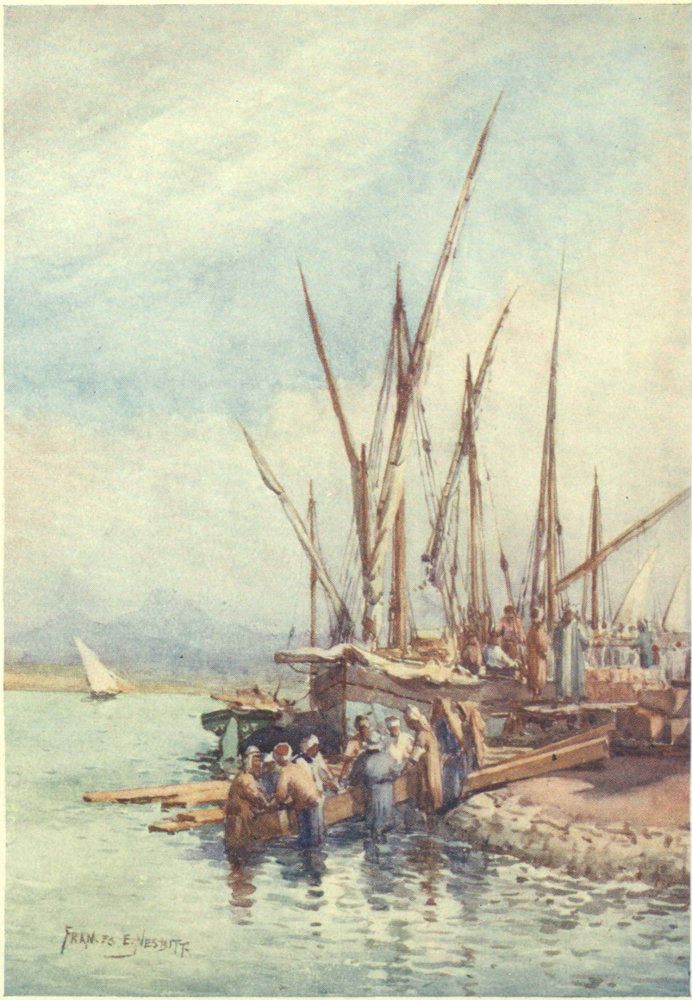
UNLADING WOOD
What is known to the Tunisians as les chaleurs, or real summer heat, sets in towards the end of May or beginning of June. With the heat come many changes. The town Moors drop their many cloaks and display the wealth of silk and embroidery usually hidden. The men from the country wear yard-wide steeple-crowned hats over their turbans; for if the burning sun is trying in the city, what must it be in the country, where no cool shadows offer shelter? The Europeans, soldiers and civilians alike, appear in white, and the tyranny of the shirt collar is ended with the coming of sun helmets and umbrellas. Ladies don their thinnest muslins, and do not venture out before the evening. Everyone seeks the shade except the Italian women, who will stand bareheaded, idly swinging their closed parasols, where no Arab would keep them company.
A scirocco or wind from the desert intensifies the heat to an unbearable degree, night brings no relief, and this burning blast may last three, five, or nine days; and a nine days’ scirocco is an experience to be remembered. A resident gave us this warning encouragement: “If you stay till June and come in for a bad scirocco you will think you will die, but you won’t.” The sensation of misery could hardly be better expressed: one gasps for breath, sleep is impossible, and the only tolerable moments are those passed quite close to an electric fan. Plants and trees shrivel up, so that the gardens look as if they had been actually burnt. The country is scarcely cooler than the town, and at the seaside there is little relief, as four or five degrees’ difference does not help much when the thermometer is once over 100° Fahrenheit.
The realm of the Queen of the Seas is now desolate—desolate, but untouched by sadness. Tragedy and doom are hidden beneath the brightness of summer flowers and the promise of an abundant harvest. The ruins that remain are not fine enough in themselves to call forth memories of a glorious past. The greatness is gone. Nothing is now left to speak of bygone ages with an insistent voice; nothing strong enough to break down the dulness and create an interest in ancient history. Those who expect to have their historic sense awakened and quickened by the sight, turn empty and disappointed away, for all enjoyment rises from the dreams and imagination born of some knowledge or wide reading, and not from what Carthage can now show; for the Phœnician city was so utterly destroyed by the Romans under Scipio in the year 146 B.C. that the plough was driven over the site. Subsequently city after city rose from the same ground to be destroyed almost as entirely. Columns and capitals from the Roman, Vandal, and Byzantine cities 180 may be seen in Tunis, Kairouan, and Sicily, and even so far away as Italy and Spain. Here there are few left.
Traces of the original city are still harder to find, and must be sought far below the earth’s surface under successive layers of ruins and soil. Three mosaic pavements of different periods have often been discovered one below the other, whilst the foundations of Punic temples and inscriptions in that language thus buried still show signs of fire. The story of Carthage is also shrouded in mystery; even the date of its foundation is uncertain. All that is known is that in the dawn of history, when the Israelites took possession of Palestine, the Canaanites retreated to Tyre and Sidon, and there built up a mighty state. From these two cities daring mariners set forth in frail coasting vessels to found settlements in Asia Minor, Greece, Africa, and Spain, extending their voyages of discovery in later times, gathering riches and treasures from the distant ends of the then known world.
One of the earliest of these colonies was the city of Utica, and probably when Dido arrived in Africa (if she ever did), after her flight from the cruelty and treachery of the Tyrian king, there were already other cities on the plain. Her taste and judgment must have been equal to her beauty and artfulness when she chose this spot for her city of refuge, and beguiled the inhabitants into granting her the land that the traditional oxhide would cover; for the situation is as lovely as any on the north coast of Africa, the harbour good, and the country rich. The colony was known at first as Kirjath-Hadeschath, or New Town, to distinguish it from the older city of Utica. The Greek name was Karchedon, and the Romans called it Carthago.
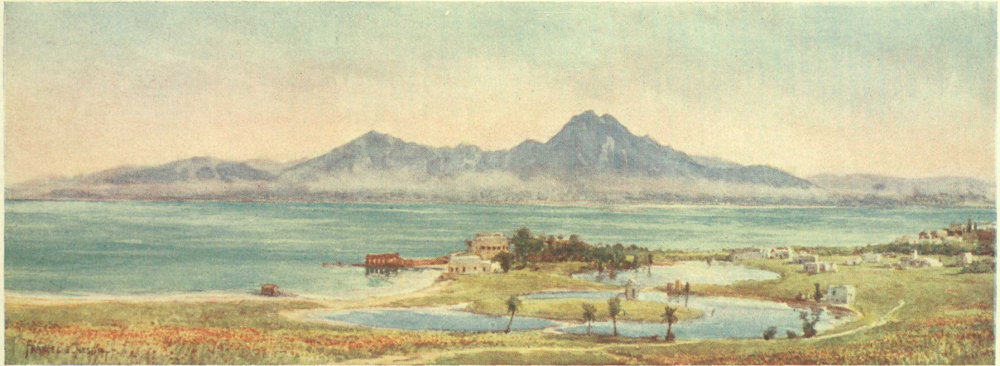
THE ANCIENT PORTS OF CARTHAGE
Strangely enough we depend on the enemies of Carthage for accounts of her history, as, with few exceptions, her own records were destroyed. No great poems are left, no annals, nothing remains but a few inscriptions, some fragments, and the three treaties with Rome. The Roman narratives are tinged with envy and hatred, yet even so the fame of Carthage stands out clearly, and the deeds of her sons, both as sailors and soldiers, surpass those of other days and other peoples. What admirals of any time would so gallantly have dared such a voyage in small vessels as did Hanno, who almost reached the equator from the north coast of Africa, or Himilco, who, in a four months’ voyage, “keeping to his left the great shoreless ocean on which no ship had ever ventured, where the breeze blows not, but eternal fogs rest upon its lifeless waters,” discovered the Scilly Isles, Ireland, and the wide isle of Albion? These admirals have left records of their doings which still exist. Generals more famous still, vied with each other in their country’s service, fighting bravely on in face of neglect and want of support, knowing that success met with scant praise, and that failure meant death if they returned to the capital. Such names as Hamilcar Barca and the still greater Hannibal recall to memory the tales of the genius of those who upheld her power.
Yet for all this Carthage was no warlike city, but was given over to the arts of peace, to the pursuit and enjoyment of wealth. It was a city of merchant princes, an oligarchy like that of Venice in later times, and the Romans were astounded at the luxury and beauty of the buildings and the far-spreading suburbs.
Agriculture was apparently a favourite pursuit, as a treatise on the subject, in twenty-eight books, was written by Mago, who was called by the Romans the father of husbandry. This book they saved from the general destruction of Carthaginian literature and translated into their own language. Varro, whose own work on ancient agriculture is the most valuable we possess, quotes Mago as the highest authority.
As the city was looted and the treasures carried to Rome it is idle to expect to find anything very noteworthy to show the Carthaginian skill in art. But the White Fathers have in their museum a large collection of bronzes and pottery, and a few jewels of all periods, some of them of peculiar interest because of the strong resemblance between the Punic designs and those of Egypt. Many of the gods are the same, and sacred eyes and scarabs are plentiful. Curious bulbous vessels, used as feeding-bottles for babies, have faces roughly painted on them, the spout taking the place of a mouth. The bronzes have much in common with those of Pompeii, and some fine tombs with full-sized figures might be Greek. The garden of the Monastery is also full of fine fragments and inscriptions, and stands on the brow of the hill that was once the Byrsa, and is now known as the hill of St. Louis. It faces the Gulf of Tunis, charming in outline, glorious in light, and full of colour.
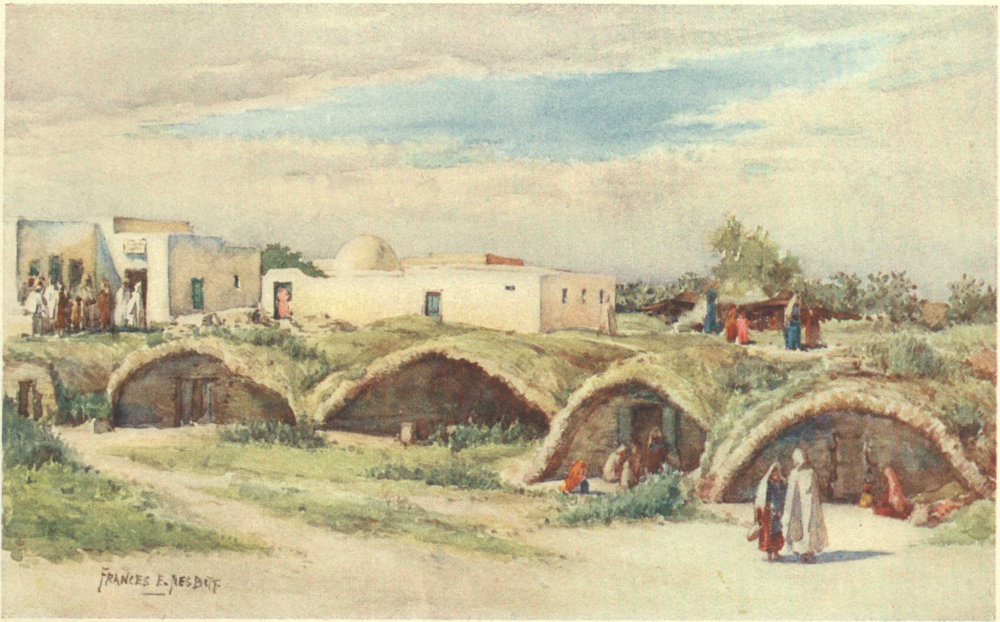
THE OLD PUNIC CISTERNS, CARTHAGE
The twin peaks of Bou Korneïne, the Gemini Scopuli of Virgil, soft as a dream in the early morning, are the distinctive beauty of the curve of the bay to the right. On the other side rise the heights of Sidi Bou Saïd, or Cap Carthage. The Mediterranean and the lagoon of the Bahira, “the little sea,” or lake of Tunis, are of a wondrous blue, the water shimmers in the sunshine, the town of La Goulette gleams likewise, and so do the houses scattered along the coast. The slopes of the hill and the whole of the plain towards the sea are covered, as it were, with cloth of scarlet and gold and green, poppies and marigolds and waving corn, in masses such as can rarely be found elsewhere. The ancient ports of Carthage, now so reduced in size, still retain something of their original form. The military harbour is circular, with an island in the centre where the admiral once dwelt. These tiny lakes, calm as glass, and almost more definitely blue than the Mediterranean itself, hardly suggest themselves as the busy harbours of the Queen of the Seas, but look rather, as a French author says, like the lakes of an English garden.
Here and there shapeless masses of masonry can be seen scattered over the plain, either hardly visible under the living veil of green, or showing like scars, but there is nothing that is in any way an addition to the picture. The view on all sides is beautiful, which is more than can be said by the most charitable of the buildings 184 which crown the hill. Neither the Cathedral of Cardinal Lavigerie, the Chapel of St. Louis, nor the Monastery are worthy of their position in style or treatment. On a bare hillside it might be possible to conjure up fine temples and stirring scenes, to imagine the terrors of the last days of the siege, and the heroic death of the wife of Hasdrubal. Now even St. Louis is too picturesque a figure for the prevailing commonplace, and it would be almost a relief to think that he died at Sousse, as some people suppose.
One remarkable work, and one only, has survived all the changes and chances in the life of Carthage, and still endures to show that the vast size of the original city was in no wise exaggerated. Not only have the aqueduct and cisterns outlasted all the other buildings, but they have been restored, and once more fulfil their purpose, bringing fresh spring-water to a thirsty city—no longer indeed to Carthage, but to the equally ancient and still flourishing Tunis.
Modern Tunis does not require nearly as much water as the greater Carthage, so that only the smaller group of cisterns, lying near the sea and the ruined baths, is now in use. These cisterns are eighteen in number, and can only be called small by comparison, as they are said to be 135 mètres long, and hold nearly 30,000 cubic mètres of water.
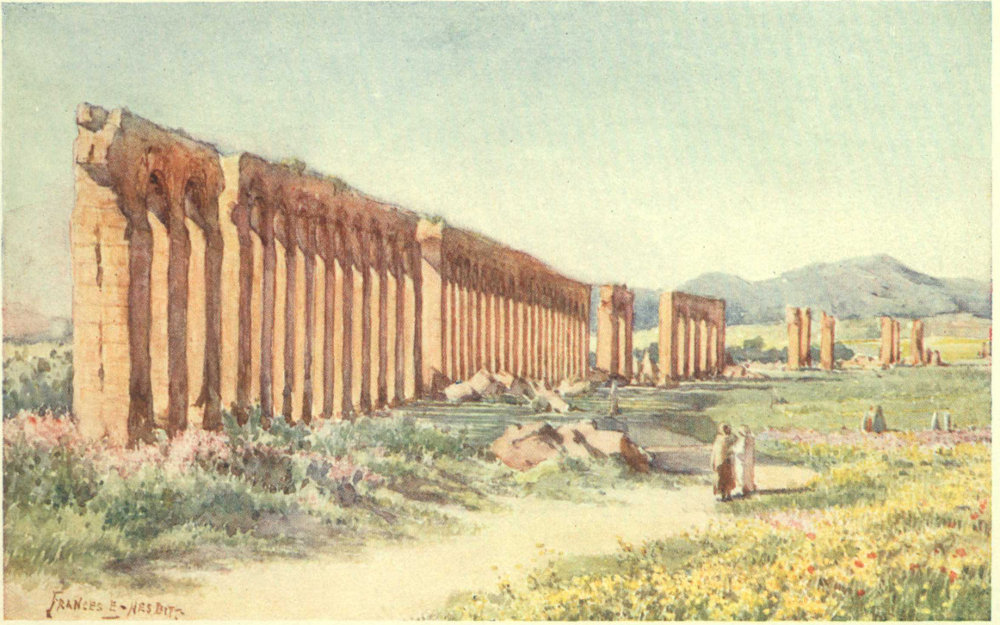
THE CARTHAGE AQUEDUCT
The larger group is quite ruinous, and is broken down in the midst, forming an open space on to which the cisterns face, built as they are in parallel rows. Here the Bedawin dwell who have turned the Punic cisterns into the Arab village of La Malga. These underground homes are supposed to be far superior to tents or huts, as they are cool in summer, and warm and dry in winter. They look like vaulted halls, as the lower half has become filled with soil, and they are closed at the ruinous ends by rough wooden walls and doors. At any rate if not quite ideal dwellings, they are picturesque and at least unusual. Though there are many theories on the subject, the design and much of the actual work is considered to be Phœnician, though considerably restored and in part rebuilt by the Romans. Some authorities find traces of Punic work in the aqueduct also, others suppose that the Carthaginians used the cisterns merely to store rain-water, and think that the Romans, when they defied the curse and rebuilt the city, found the water-supply insufficient, and therefore made an aqueduct in the reign of Hadrian, A.D. 117-138. It underwent many disasters, and was partially destroyed and rebuilt over and over again. First, the Vandals, under Gilimer, did their worst to it, and Belisarius restored the damage; then the Byzantines had their turn, and it was put in order by their Arab conquerors, only to be again injured by the Spaniards. Finally, some part of it began useful life once more under a French engineer in the reign of Sidi Saduk, the late Bey.
One spring still rises in the Nymphea, or temple of the waters, amongst rocks and trees and flowers at Zaghouan, Mons. Zeugitanus, and the other is brought from Djebel Djouggar, Mons. Zuccharus. The great 186 aqueduct stretches out like a chain connecting the mountains and the plain—a chain of massive links, sadly broken and often interrupted in its long course of over sixty Roman miles. The channel is carried down the mountain-side, sometimes over and sometimes under the ground, and on the plains it is often raised on immense piers. Near Carthage it has been broken up and entirely destroyed, and the water has then to find its way through ordinary modern pipes.
There is a look of grandeur and beauty about the ruined arches, as they are seen rising from the sunny, flowery fields, that is usually wasted on an unappreciative world, as few drive far enough out from Tunis to enjoy the sight.
At Carthage the masses of flowers give a certain charm to ruins of no intrinsic beauty. Brilliant marigolds crowd every nook and cranny in the Punic tombs, shedding the glory of their golden life over the dreary maze of catacombs, where formerly the dead rested, but which are now bare and empty; though in another district one curious tomb, formed of three solid blocks of stones, in form like the beginning of a house of cards, is built with a few others in the side of a shadeless, barren cliff. Flowers fringe and cover the Basilica, surround the newly excavated Roman villa, contrasting daintily with the broken columns and mosaic pavements, and touch with their brightness the elliptical outlines of the Roman amphitheatre, where many Christian martyrs suffered for the Faith. Of these St. Nemphanion was the first (A.D. 198), though the best known and most 187 loved are Saint Perpetua, and Saint Felicita, to whom the little chapel in the centre is dedicated.
The flowers harmonise with thoughts of the young and beautiful widow who gave up child and wealth, and who herself wrote of her joy and suffering in prison. She tells us of her vision of a golden ladder, beset with swords and lances, and guarded by a dragon, whom she quelled in the name of Christ, and so mounted to a heavenly garden, where a white-haired shepherd, surrounded by his flock, gave her a welcome and a piece of cheese, whilst thousands of forms in white garments said “Amen.” The vision foretold her martyrdom, which took place between A.D. 203 and 206. According to a custom peculiar to Carthage—a relic of old Phœnician days when human sacrifices were offered to Baal-Moloch, and men worshipped the horned Astarte—the men were expected to wear scarlet robes, like the priests of Saturn, and the women yellow, after the fashion of the priestesses of Ceres—a reason perhaps for the wealth of scarlet and yellow blossoms that now flourish so abundantly. The Christians refused, saying that they suffered in order to avoid such rites, and the justice of the plea was allowed.
A cross marks the spot on a little hill between La Malga and the Byrsa where St. Cyprian was beheaded in A.D. 258. An interesting fact, to which Archbishop Benson calls attention in his Life of Cyprian, is that long before any Bishop of Rome appears with the title of Papa, or Pope, in any sense, it was used as a formal mode of address to Cyprian by the clergy of Rome. 188 And it is clear from the history of his times that there was then no idea of Papal supremacy, but that, on the contrary, the Bishop of Carthage once at least overruled the decision of the Bishop of Rome.
Strange as it seems now, with Mohammedanism all around, Christian Carthage became in its turn a great power, with a long line of bishops, whilst North Africa not only counted some six hundred Episcopal sees, but also produced such famous men as Tertullian, Cyprian, Lactantius, and Augustine. Nothing is now left anywhere except the ruins of three or four basilicas, some lamps with Christian emblems, and a few inscriptions.
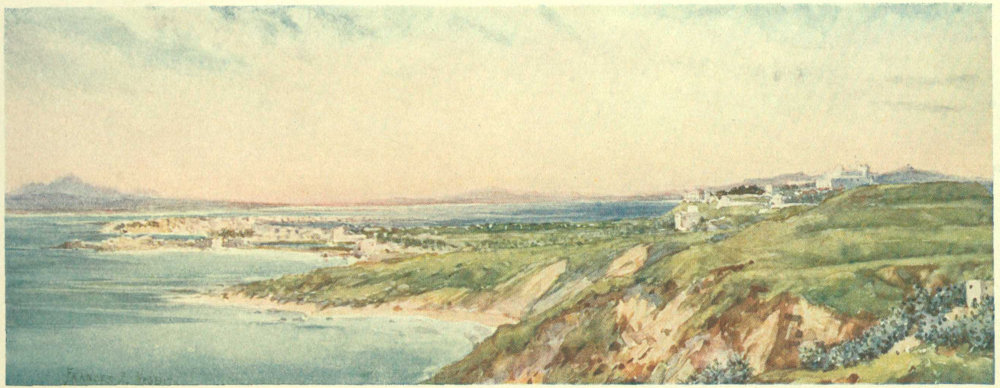
THE SITE OF CARTHAGE FROM SIDI BOU SAÏD
To see all the ruins at Carthage is no light matter. Distances are so great, and there is such a dearth of conspicuous landmarks to guide the search. The nine miles’ drive from Tunis is mostly considered very monotonous, as the road itself is straight and dull, though the beauty of the mountains and the lake, the flush of scarlet from the flamingoes in its marshy edges, the marvels of the flower-clad meadows, the dark tents of the nomads, and the picturesque workers in the fields, are surely enough to make even a longer distance seem short. The first impression is altogether finer if it is gained by driving through the country to the gay villas of La Marsa, and so up the hill to Sidi Bou Saïd, than by taking the railway and then walking from point to point. The Arab town of Sidi Bou Saïd is so holy a place that no unbelievers were formerly allowed to live there, hardly even to walk its streets, and yet the saint after whom it is called is no other than St. Louis of France, the Crusader who died of pestilence before the walls of Tunis. The Mohammedans, however, believe that he adopted their religion, died and was buried in this village, showing how even his enemies admired his saintliness, and also that the God whom both worshipped was the same God as Mohammed always taught. The small town is piled up on the highest point of the hill in true Oriental fashion, and from the lighthouse on the summit the view is superb, with the Mediterranean almost surrounding the cape. The whole site of the ancient city is visible, from the rocky headlands in front to the distant town of La Goulette on the promontory that separates the open sea from the lake; a wide sweep of plain, the many low hills, the Byrsa marked by the whiteness of the new Cathedral, the whole circle of mountains, the summer villages gleaming at their feet, Tunis, the villas and gardens of La Marsa, the site of Utica, now more desolate than Carthage itself, the beautiful line of cliffs towards Bizerta—all combine to give some idea of the possibilities and beauties of ancient Carthage.
A refreshing uncertainty, almost amounting to a touch of adventure, gives zest to plans for a trip southwards. Beyond the one undisputed fact that the inn at Sousse leaves nothing to be desired, information is vague and scanty.
The journey opens in a fashion that promises much. There are only two trains in the day, and both are inconvenient. One starts too early and the other too late. The railway carriages with their narrow seats and hard cushions proclaim by sheer discomfort the unfrequented route and the dearth of travellers. The windows, that are either wide open or shut, but know no happy mean, guarantee a pleasing alternative of cold or stuffiness, for it soon becomes impossible to hold a heavy frame perpetually at a proper height.
It is delightful to feel that all sorts of possibilities lie hidden in the immediate future, and that the rate of progress already lifts the journey out of the commonplace. It is slow enough to be phenomenal, and gives time not only for observation but for quiet 194 meditation on every detail of the landscape before it disappears.
There is no objection to this for some distance out of Tunis, as the route is pretty. The line skirts the edge of the bay, passing through the gay watering-places full of sunshine and flowers that lie at the foot of Bou Korneïne. During the sunset hour, when the plains are flooded with glory, the train might stop entirely, and welcome. But when the last tint of colour has vanished and no consolation is left, then the long, purposeless halts at wayside stations become exasperating. It does seem wasteful to spend so much time over so short a distance.
When morning comes, this mood flies away at the unexpected sight of a mediæval town on the opposite side of the harbour; for Sousse follows the Tunisian fashion, and the French colony dwells apart. The old town stands on a gentle rise beside the waters of the Mediterranean, a complete survival from the Middle Ages. Not grey and timeworn like our northern strongholds, but radiant in the sunshine, a mass of glittering white, crowned and girdled by gold—towers and bastions and crenellated walls. The reflection of these old-world defences in the calm waters below is almost as brilliant as the reality.
In the evening a change comes over the spirit of the place, the brightness fades away and is succeeded by a gentle melancholy, a slight film, the dimness of age, as if the warriors of bygone times returned at sundown to hover over their old castle, full of unavailing regret that their day is over, and that from the topmost battlements an alien flag now floats.
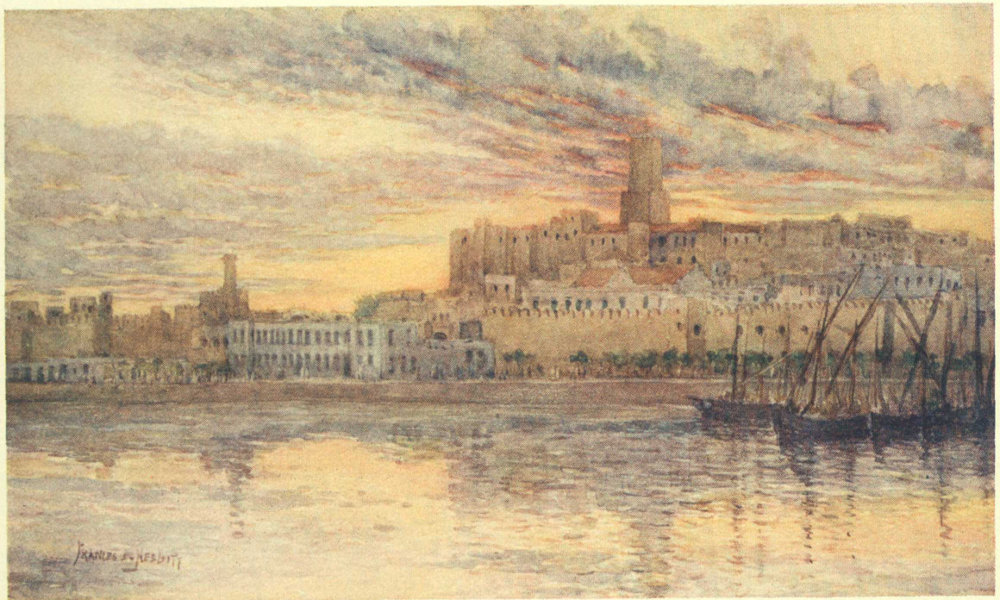
SOUSSE
Sousse, under its old title of Hadrumetum, has a quite respectable antiquity. Sallust mentions it as a Phœnician colony of older date than Carthage. Under the Emperor Trajan it became a Roman colony, the capital of the Byzacene or mid-Tunisia. No one knows when or how it received the name of Sousse, and even the fact of its being Hadrumetum at all was once a matter of dispute. Hercha and Hammamet are both supposed by some to have a better claim to the distinction, and Ruspina has been given as the original name of Sousse. It fell into the hands of the Normans from Sicily during the twelfth century, but has otherwise remained a Moslem fortress from their first invasion to the time of the French occupation in 1881.
Now the French colony seems bright and prosperous, and the inhabitants talk more cheerfully of their fate than usual; for there is much to do, and the recently opened harbour is a great improvement, as formerly the roadstead was defenceless in certain prevalent winds, and now ships can ride safely at anchor and take in immense cargoes of corn and oil, the staple produce of the district.
Once within the old gates the Arab town, though most picturesque, shows little that is distinctive. It possesses narrow Eastern streets, whiter even than usual, and small bazaars, after the manner of Tunis, but with no individuality of their own. Tunis, Algiers, and Constantine have so much character that their 196 identity could hardly be mistaken by anyone who knew the tokens, even if he were dropped unawares into one of their streets. The architecture, the colour, and the appearance of the inhabitants are all so different in type.
From every side Sousse presents a striking picture, and from the towers of the Casbah the view over the sunny terraces to the wondrous blue of the bay and the soft green of the olives is beautiful. But the only building that is really curious in the town itself is the Kahwat el Koubba, or café of the dome, a small Byzantine basilica. Unfortunately, it is so built into the bazaar that it is difficult to see its peculiarities. It is quite square for rather more than the height of a man from the ground, then round for the same distance, and has a fluted dome.
The rue Halfaouine, the street where pottery is sold and mats are made, is quainter than in Tunis, for there the two trades work separately. These men were very busy, and with one exception had not the slightest objection to being watched or painted. The one man who did object wore the green turban of the descendants of the Prophet, and built up an elaborate screen of plaits to hide himself. He soon forgot his dread, gradually used up the plaits, and forgot to replace them.
Granted a little patience with the shortcomings of the train service and it is no trouble to see Sousse, but the excursion to El Djem is quite another matter. Until quite lately difficulties strewed the path, and the drive alone took one long day or even two. Now, thanks to the introduction of a postal motor-car service, the journey between Sousse and Sfax is smooth enough.
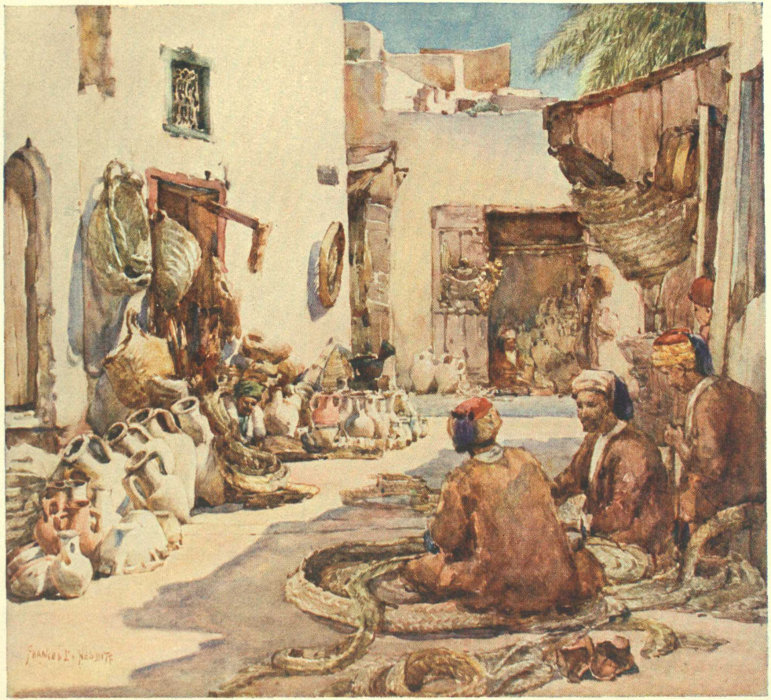
THE BASKET-MAKERS, SOUSSE
The shaky old diligence still runs for the benefit of second- and third-class passengers, and takes a wearisome time about the journey, which the motor accomplishes in rather more than three hours. This motor is a heavy, but very roomy vehicle, somewhat like a coach with six places inside, two beside the driver and more on the roof, and moves with the steady, resistless force of great weight. As a rule, all the seats are taken some days beforehand, for there is much coming and going of business men between Sousse and Sfax; but we were lucky enough to secure ours after only two days, and to have only one other passenger in the interior, which meant heaps of space and a clear view with no intervening heads. The straightness of the road is at first mitigated by the beauty of the old olive trees, but when these give place to new plantations, the young trees and bushes are so few and far between that they only accentuate the dreariness of the landscape. Still, a look of wellbeing is coming over the land, and if all goes well, the arid plains will once again become fruitful, and the mischief wrought by El Kahina, the celebrated chieftainness of the Aures, who destroyed all the farms and villages, will be remembered no more. Formerly the whole country from Tripoli to Tangiers was wooded and fertile, but the destruction of the forests has given the land its present inhospitable character, so that where twenty inhabitants flourished 198 in Roman times, it was hard work for one man to get a living, till the French came and began to restore the ancient order.
One village of importance, and one only, breaks the monotony of the route, and the motor passes through its narrow streets, which it almost fits, hooting and scattering the people right and left, shaking them out of their dreamy ways with its message of speed and progress. Yet though some grumble more admire.
Even on this frequented road, where the motor passes twice daily, the same amusing precautions are taken by the Arabs as at Hammam Meskoutine. The camels are ridden off into the plains, carts are dragged to the side of the road, and the horses’ heads covered up—even the donkeys are held very tight. And if any man is too sleepy to attend to them, his animals give him enough to do to pacify them after the horror has passed.
After this village the olives disappear. Nothing is visible but a wide plain, literally carpeted with wild flowers, mostly common ones, but exquisite from pure abundance of colour. Amongst them are masses of small purple gladiolus, the most beautiful flower of them all.
For miles ahead the road stretches out straight as a gigantic ruler, diminishing in perfect perspective to a vanishing point on the horizon, the effect enhanced by the slight undulations of the plain. The road is without shade or trees, there are not even villages to be seen, only a few Bedawin camps, and an occasional house 199 surrounded by fragrant mimosa and olive trees, the dwellings of the French road-surveyor. Innumerable traces of the Roman occupation are to be found on every side, ruined farms, old walls, and fragments of buildings, showing that this must have been almost as densely populated as the district between Hadrumetum (Sousse) and Carthage, which, as a Roman historian tells us, was shaded for the whole length of the road by villas and beautiful gardens.
At last, dimly discernible in the distance, a vast form rises, desolate and alone upon the earth, a forlorn relic of Roman splendour, the African rival of the Colosseum at Rome—the amphitheatre of El Djem. It is only a few feet smaller than its great original, is built on the same lines, is of the same massive breadth, and what it loses in actual measurement is regained by its isolated position. A building of such proportions is sufficiently impressive in the heart of a famous city, but out here in the wilderness the effect is overwhelming. The very existence of such a huge place of amusement so far from the present haunts of men, on a spot so bereft of all visible means of supporting a city large enough to send 60,000 spectators to witness the games, is strange, almost unthinkable. The land, of course, is good, but water is not here in any abundance, and there is no stone in the neighbourhood—the fine white limestone used in the building having all been brought from Sallecta on the coast.
Nothing now remains but this, the wonder of North Africa, of the whole city of Thyrsus mentioned by 200 Pliny and Ptolemy, except a half-buried Corinthian capital of colossal size, a road, fragments of a villa, some baths and a few mosaics, all more or less hidden and much scattered among the olives.
The Proconsul Gordian rebelled against Maximin, and was proclaimed Emperor at the age of eighty, at Thyrsus in A.D. 238, about the time of the building of the amphitheatre, which is sometimes supposed to have been his work as Emperor. But this could hardly be, as he was defeated in battle, and died by his own hand within two months.
The amphitheatre was looked upon by the Arabs as a place of refuge in troublous times, and was often used as a fortress. It is called Kasr el Kahina, or Palace of the Sorceress, after the celebrated El Kahina, of whom many legends are told. When she was besieged in this singular castle of hers, she caused subterranean passages to be made to the sea coast at Sallecta, and had this done on so large a scale that several horsemen could ride through them abreast. The Arabs believe firmly in these marvellous passages, but the entrance to them has not yet been found. However, later on, another siege had to be raised, because the defenders were so well supplied that they mockingly threw down fresh fish to the besiegers, who were already suffering from want of food.
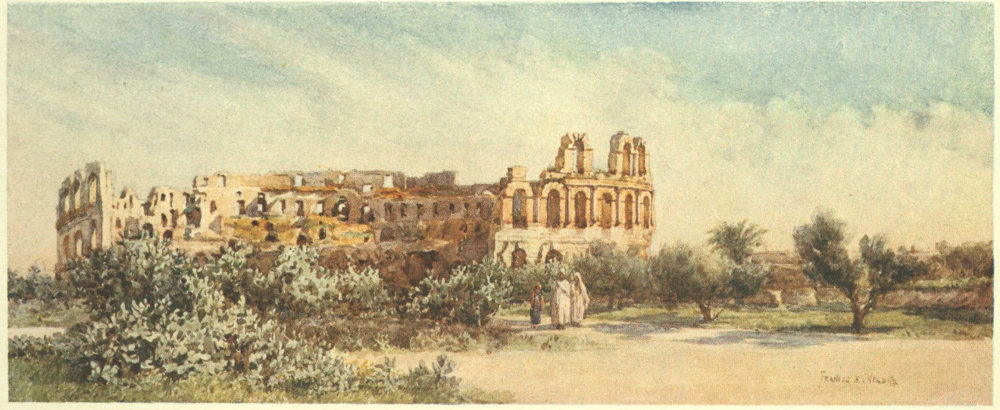
THE ROMAN AMPHITHEATRE, EL DJEM
In modern times the great breach made in one of the sieges has been enlarged by the Arabs, who used it as a quarry, and built their large village beneath its shelter entirely out of the spoils. Now this quarrying has been stopped by law, happily in time, and the breach, overgrown as it is with moss and plants, only serves to make the ruin more beautiful as it lies among the prickly pears and olives. On the side nearest the village, however, it is in such good preservation, and the four galleries are so perfect, that with the regularity comes a certain loss of picturesqueness. The village is quite unusual: the stolen stone has been used as if it were mud, the houses are built like huts with large walled courts, and big doors, which are defended by barking dogs.
The men are indifferent to strangers, but the children, pretty as they are, become a positive torment. They have learnt the value of a petit sou, and keep up a never-ending litany in the vain hope of obtaining one. This comes of the bad habit of throwing coins from the automobile for the pleasure of seeing a scramble.
In the evening some sort of a fête was on hand, absolutely different to any we had seen. Bowers had been built, flags and greenery were festooned across the street, and in one large booth, covered with green, a crowd was gathered to watch a performance of howling dervishes, probably Aïssaouas. A long row of men and boys with streaming hair were working themselves into a state of frenzy, with violent rhythmic movements of their heads, as they threw them backwards and forwards, and panted like steam-engines. There were also groups of masqueraders with unearthly masks, pretending to be animals and going on all fours, and a mock bridal party with a soldier arrayed as the bride, his feet and gaiters alone betraying him.
There is no inn of any sort, so travellers stay at the school, which is also the post-office. The French schoolmaster, his wife, and a little girl, are the only Europeans in the place, though it contains one Jew and one Maltese—so Oriental as not to count.
The school is an old building, once the house of a Bey; it was then a big open cloister. Now walls, doors, windows, and partitions have been added to form large double cells, vaulted as in a monastery, but with horse-shoe arches. These cells are scantily furnished, so that they look both bare and spacious. Once they were used for storing gunpowder, which has left the walls sadly discoloured. In fact, the appearance of the house was well in keeping with predictions which we had received about roughing it; but we found that instead of starving, the meals were quite elegant, consisting of many courses, and including such luxuries as chicken, lamb, and quails. The bread was very dry, and there was no butter; but much experience had foreseen that difficulty, and jam, biscuits, and tea travelled with us. The schoolmaster was silent, but contented. His wife, however, suffered much from the loneliness; for the small doings of the household, teaching a native servant and superintending the cooking, could not fill her life. She was pining for friends and sympathy, and her nearest neighbours, a detachment of soldiers, lived fourteen or fifteen miles away. The diligence and the motor cars alone brought variety, and they passed quickly with some pleasant bustle, and then silence came once more. The school itself is a success: the boys 203 seem to learn well, and are eager to air their French and pick up new ideas.
At night, even when the little garrison has been raised to five, there is a strange eerie feeling of loneliness, which camping somehow does not give. The great doors are bolted and barred, the watch-dog is on duty in the court, which the moonlight makes almost as light as day, brightening the treasured but miserable garden with its tender touch. All is made perfectly safe. Yet the thought recurs insistently, what could one man do, should anything rouse the hundreds of half-wild Arabs in the village out of their ordinary quiet hatred? A life of this sort is only possible where the fascination of the East is strongly felt; but for a poor woman like this, out of sympathy with the country, its people and their ways, it is little short of martyrdom.
Quiet is not a feature of the nights at El Djem. Every house in the village owns several dogs, and the only dog that does not seem to bark all night is the dog at the school. As for the cocks, they begin to crow at bed-time and keep it up till morning. Jackals and an occasional hyena swell the chorus. Then in the small hours the diligence arrives, with rattle and rumble along the road and a thunderous knocking at the great door, till the whole household is awake to give it welcome.
The motor appears at the respectable hour of nine in the morning, and manages with infinite cleverness to catch the mid-day train to Kairouan, although it should 204 have started before the time at which the motor arrives. There is so much leisure and so little punctuality that, with friendly assistance, seats are taken, luggage registered, and lunch purchased before the train finally starts.
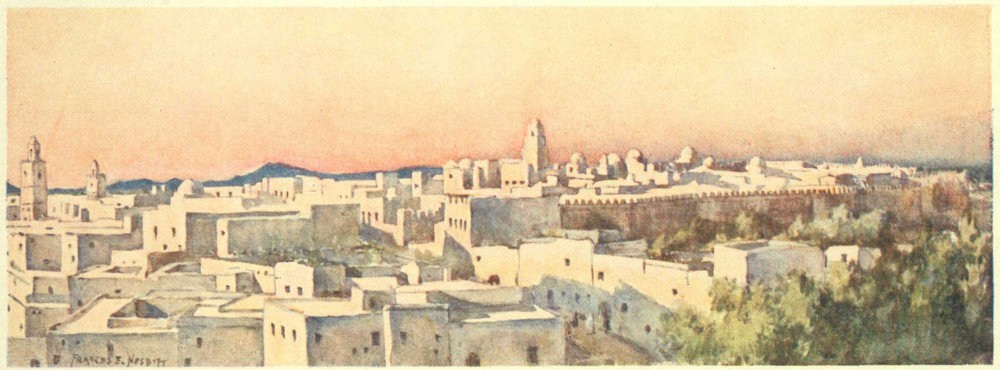
EVENING, KAIROUAN
Seven visits to the sacred city of Kairouan are equivalent for the devout Mussulman to one pilgrimage to Mecca. A pleasant alternative for those who wish to gain a high degree of sanctity at a small cost, for since the railway simplified the journey there are neither terrors nor difficulties to overcome.
Picturesque hill towns are passed on the way, and also the first of the chain of Chotts, or shallow salt lakes, almost or quite dry in summer, strange reminders of the time when the Mediterranean penetrated the desert as far as Biskra. Plans have often been proposed for letting in the water again from the Gulf of Gabès to the Ziban. But though in some ways this might bring added prosperity, in others the change of climate would probably spell ruin. The date harvest at Gafsa and Gabès would be spoilt, and most likely that of Biskra and Tougourt as well.
The Tunisian oases vie with, if they do not surpass, those of Algeria, but they are little visited, partly because it is not the fashion, but much more in consequence 208 of the discomforts to be faced, as travellers are mostly dependent on their own resources, a native fonduk, or the kindness of some French officer. The fonduks by all accounts are intolerably dirty, and sleep has to be snatched during a lull in the noisy talk, in the corner of a crowded space, with a portmanteau for a pillow, the mud floor and a rug by way of bed. No food or refreshment are offered except coffee. The inns when they exist give rise to pathetic tales of food and dirt. Birds apparently made of india-rubber, quite black and utterly impervious to the blunt knives, pose as chicken, the eggs are of untold age, and the bread sour. Cous-couss is the best thing; it is not at all a bad variety of stew when well made, rather like curry, but laid on a bed of semolina instead of rice, with a very hot, piquant sauce. The number of ingredients is always rather mysterious, and when ill-made it is horribly greasy.
These various drawbacks make even the excursion to the fine Roman ruins of Sbeitla too uncomfortable without a camp, as it is a two days’ ride from Kairouan. The road is supposed to be fit for carriages, but owing to the badness of the track, a strong country cart cannot stand the strain, and is always coming to grief, or losing a wheel at critical moments, so that a rider finds he has chosen the better part. Then it is rather a shock to be told on the return journey, with many miles yet to travel and darkness coming on apace, that no Frenchman considers this district safe without a revolver loaded and ready to hand.
Altogether it is decidedly annoying as well as disappointing, because drawings and photographs of curious places and buildings make the longing for adventure in the wilder regions so strong as to be almost unbearable. There are houses at Tozeur with decorative façades, built with raised designs in projecting sun-dried brick. At Matmata and Douïrat the Troglodytes dwell in rock-hewn cells, forming hill cities cut out of, not built on, castellated crags, whilst at Medénine the houses are built one above the other, five stories high, with doors that serve as windows. Most of these houses are reached by climbing up on jutting stones built into the wall, which, even with the assistance of a cord, needs a steady head, though a few have the luxury of an outside staircase.
There is great consolation in the thought that until quite lately Kairouan itself was almost a sealed book, for travellers could only see it when provided with an escort and a special permission, and these were not sufficient to admit them to the mosques, or to protect them from insult or stones in the streets, so that little joy came from a visit even so late as 1888.
Now the nervous need have no misgivings, as the train crawls like a snail over the barren waste, redeemed from desolation by the flowers, more glorious than ever in contrast with the monotonous brown-hued desert framed by distant mountains.
The old walls that encircle Kairouan, with their tones of dusty brown, blend with the plain they rise from, and would be invisible at a little distance were it 210 not for the white minarets and domes within their bounds, which stand out clear-cut as a cameo against the blue of the sky, the purple of the hills, and the faded tints of the soil.
Tradition says that in the year fifty-five of the Hegira (675 A.D.) this was a vast forest, almost impenetrable, and full of wild and terrible beasts of prey and still more alarming serpents, huge and poisonous. Hither, surrounded by his conquering host, came the warrior-saint, Sidi Okba. Here he planted his lance in the ground, saying, “This is your ‘Kairwan’” (caravan, or resting-place). After which he caused fifteen chosen men, the companions of the Prophet who were with the army, to come together for prayer. Then advancing he called out, “Serpents and savage beasts we are the companions of the blessed Prophet; retire! for we intend to dwell here.” At the sound of his inspired voice they fled in a body with their young, and took refuge in the wilderness, whilst the woods that had been their home vanished also. Moreover, it is said that this miracle so astounded the Berbers who dwelt in that land, that they were one and all converted at once, and further it is alleged that it is for this reason that the holy city continues to stand in the midst of a desert unto this day.
Mohammed is said to have taught that there are in this world three gardens of Paradise, four cities, and four oratories. The three gardens include Mecca and Jerusalem, whilst Kairouan is the best known of the oratories or gates of heaven.
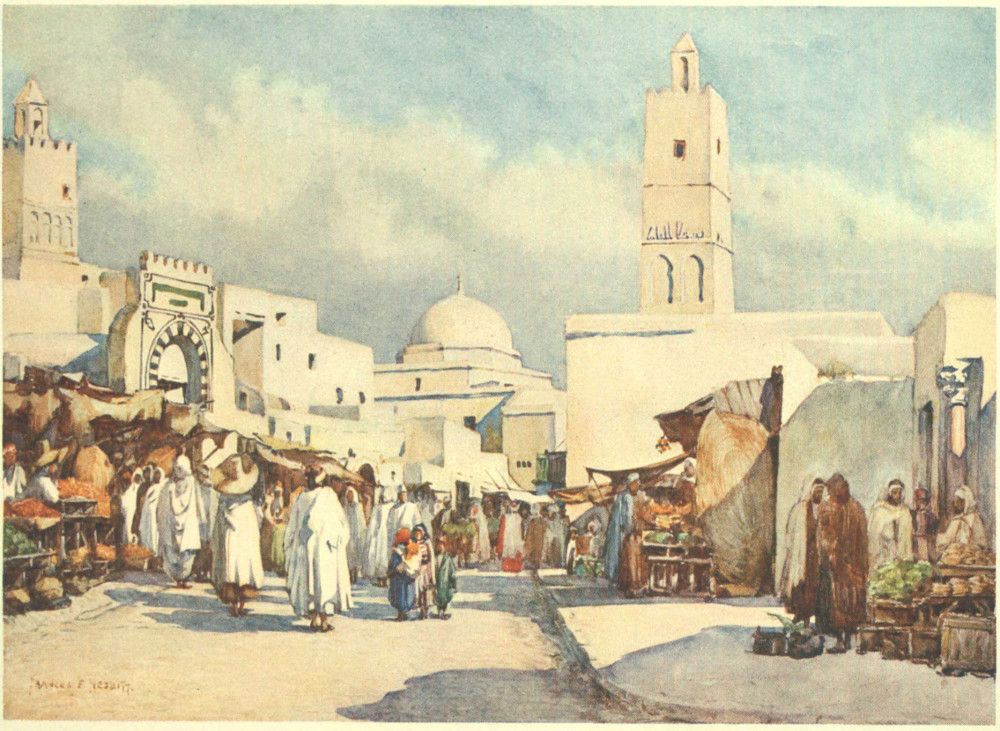
LA GRANDE RUE, KAIROUAN
Kairouan has evidently no doubt about its own sanctity, and tries to live up to its reputation, for it is most serious, full to overflowing with mosques and Zaouïas, or tomb-mosques, which are often both oratories and schools.
An air of austerity seems part of the religious character of this place, as yet untouched by the stir and onward rush of modern life. The easy ways of Tunis, the smooth, smiling faces of the Moorish dandy, the wealth of harmonious colour, are not found here. The men are of a grave, stern race, not given to bright garments, but content, as a rule, with white, or tones of brown. A woman is a rare apparition in the streets, and her closely shrouded form in its sombre black reminds one of a misericordia brother in Tuscany,—though she, poor thing, scurries away as if in search of a hiding-place instead of boldly begging an alms.
The main street, or Zankat Touila, runs from the Bab Djelladin to the Porte de Tunis. Though unusually wide and nearly straight it has a charm of line that makes the irregular grouping of minarets, mosques, and domes, set as they are amidst a tangle of booths, shops, and balconies, into a bewildering succession of ready-made pictures. Both minarets and domes are as white as white can be, like those of any and every city in Tunisia, nevertheless Kairouan, whitewashed as it may be with the same brush, has a few little peculiarities to distinguish it from its fellows. Some of the minarets, for instance, severe to plainness in their construction, have for their sole decoration an inscription in projecting 212 bricks, carried round all four sides, setting forth the creed of the Mohammedans. “There is no God but God; Mohammed is the messenger of God.” Many of the domes, again, differ from those in other places by being fluted, which not only gives variety to the surface, but also a peculiarly graceful curve.
The well-house of El Barota stands in this street; outside it resembles a marabout, but instead of the tomb within there is the sacred well, the only well in Kairouan. The water is brackish in taste, and was discovered after the orthodox legendary method in time of need, by a greyhound scratching up the soil. To add to its sanctity it is said to be in touch in some mysterious way with the still more sacred well of Zemzem at Mecca. This underground communication is in such perfect working order that a pilgrim who lost his drinking-vessel by dropping it into the fountain at Mecca, found it again, on his return to his native city, in the waters of El Barota.
The entrance to the bazaars is through a gateway decorated with black lines, whilst black and white are used alternately round the horse-shoe arch. Inside the bazaar is simple—a whitewashed tunnel, dimly lighted from above, with the usual square, cavernous recesses. Shoemakers, coppersmiths, and tailors are to be found, the latter have already succumbed to the fascinations of a sewing-machine—one of the first signs that the thin end of the wedge of so-called improvement is being driven in. Most of the shops, however, are given up to carpets, the well-known industry of the place. Here, though there is some dread of the coming of aniline dyes and other European enormities, the work is still carried on, as it always has been in hundreds of homes, principally by the women and children. The designs and methods are matters of tradition, vary in different families, and are handed down like heirlooms from generation to generation.
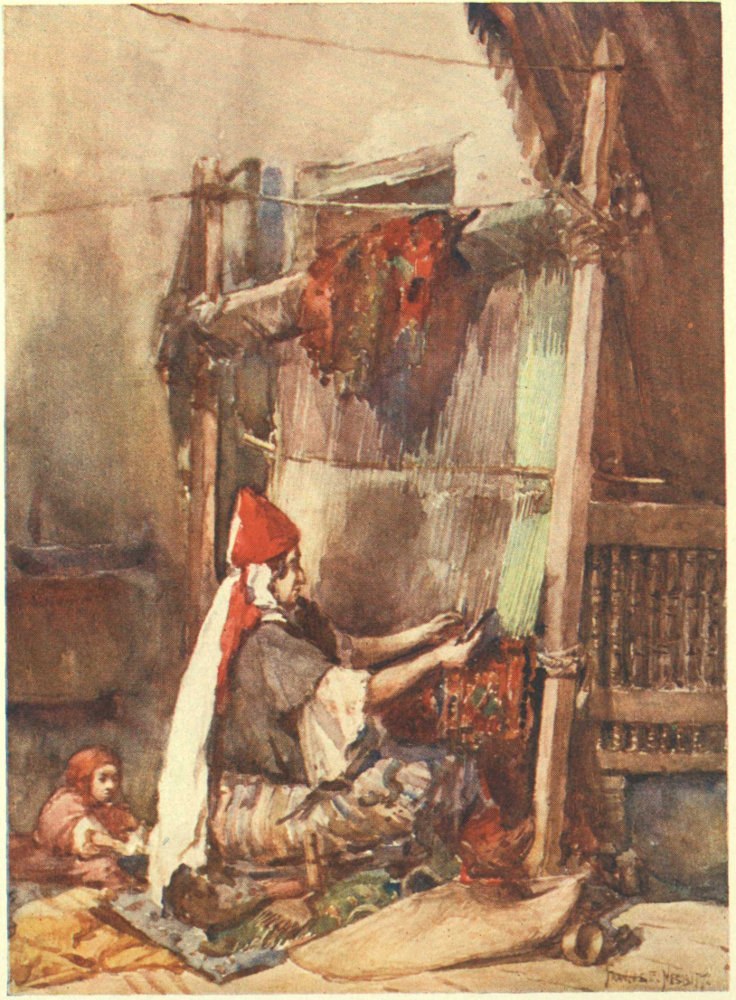
CARPET-MAKING
It is purely a home industry; there is nothing of the factory or workshop about it as yet. The loom, large as it is, with its heavy beams and many cords, takes a good deal of space in the characteristic narrow room, yet it is set up in the guest-chamber opening out of the quiet court. It is placed as near the door as may be, for the sake of light and air, the windows being small and of little account. It casts a dark shadow over the divan in the alcove, which in Kairouan is often of wood elaborately turned or carved, gilt and painted in brilliant colours. The mother sits and works steadily; the babies play with her skeins and balls of wool; the husband dozes or meditates; other women come and chat, and prepare vegetables, though the cooking is done in another room on the other side of the courtyard. All the time the threads are being deftly tied and knotted, clipped with big scissors, and beaten down at intervals with much energy and a heavy iron comb, shaped like a hoe. The carpet grows visibly in a rather mysterious way, as often there is no pattern to be seen, the worker apparently evolving the design out of her inner consciousness, which accounts for the delightful irregularity and vagaries of hand-made rugs.
The maze of the narrow streets is more puzzling than usual; there is a mean and squalid look, a hopeless sameness about them that makes threading one’s way difficult at first. The great Mosque has to be sought carefully, although from outside the town it is the most conspicuous object. Massive walls, huge buttresses, and towers with fluted domes, protect the inner court, which is entered by gateways under the towers. Vastness and simplicity as befits its name are the keynotes of the building, the slight efforts at decoration lost in the blinding whiteness that is almost unbearable in those hours when the noonday sun beats down upon the city.
Sidi Okba is said to have traced out the foundation of the mosque himself, which he called the Mosque of Olives, and on this ground, already held sacred, he caused prayers to be celebrated before the work of building was even begun. The great difficulty was to find the true position of the Mihrab, the niche which indicates the direction of Mecca. In all other mosques the Imaum who leads the prayers turns slightly to one side or the other of this Mecca niche, to show that the direction is not absolutely correct. Here, however, he stands perfectly straight, because the Mihrab was miraculously revealed to Sidi Okba in this wise. Wearied out by long prayer he fell asleep, and in his dreams an angel appeared unto him saying: “Thou favourite of the Ruler of the Universe, thy prayer is heard. Behold, when day dawns, thou shalt take thy standard and bear it upon thy shoulder, then shalt thou hear a voice crying before thee Allah Akbar (‘God is great’). No ear but thine will hear this voice. Follow, and where the cry ceases, in that place shalt thou build the Mihrab.”
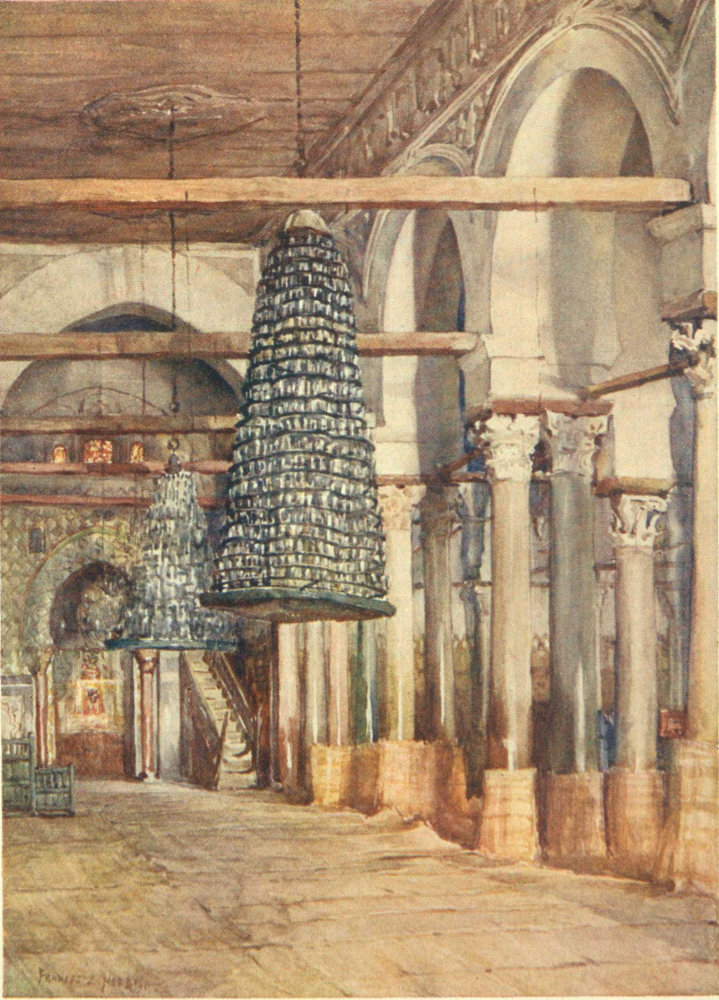
MOSQUE OF SIDI OKBA, KAIROUAN
At daybreak Sidi Okba heard a cry, and when he demanded of his companions whether they heard ought, they answered, “Nothing.” “It is the command of God, the All Powerful,” he said, and raising the standard he followed the voice till the cry ceased. Immediately he planted the standard, saying, “Here is our Mihrab.”
The minaret stands at one end of an immense courtyard, partly paved with Roman tombstones and surrounded by a double cloister. Underneath the court is a vast cistern to hold a reserve of water. At the opposite end, under a fine colonnade, in which Roman columns are found as usual, are the nine great doors of the mosque. These doors are of good old Moorish design, worn with age and softened in colour, but still truly magnificent.
The sudden change from the glare outside to the darkness within transforms the mosque into a forest, mysterious and vast, glowing with rich colour beneath the gloom. And indeed it is a forest of stone, for there are seventeen naves and who knows how many columns. The columns are antique and of fine marbles, onyx, and porphyry, rubbed by the shoulders of the Faithful till they shine. The capitals are also spoils from other buildings, Roman or Byzantine, and one there is of a design so unusual as to be considered unique in its treatment of plant form. Matting is 216 swathed round the base of the columns and covers the floor with its cool cleanliness. The great horse-shoe arches are whitewashed, the roof is rather plain, with heavy beams like a network between the columns. In the central nave hang some wonderful old lustres, with myriads of tiny lamps.
Before the Mihrab is the one incongruous and tawdry decoration—a crystal chandelier, but the darkness happily hides it, and prevents its interfering with the general impression of stately simplicity.
The Mihrab, with its inlaid work and tiles, its coloured marbles, graceful columns, and finely cut capitals, is worthy of the shrine, and shares the admiration of the pilgrims with an exquisitely carved Mimbar, or pulpit, polished and worn with age, which is said to be made of wood brought from Baghdad on purpose.
Most of the pilgrims strive to squeeze themselves between two closely wedded columns standing near by, because, so the old Sheikh said, “those who can pass through this narrow portal will also be able to enter Paradise.” Besides this appeal to the future, there is the less romantic inducement that the passage of the pillars is a certain cure for rheumatism. Whichever reason prevails, no one minds taking off cloaks and burnouses and then trying hard to wriggle through. It is a less difficult feat to accomplish than the trial of truth between two similar pillars in the mosque of ’Amr at Cairo.
A few years ago, strangers of an alien faith had to content themselves with a bare glance at the outside of 217 this famous mosque as they rode past. Now a solitary Christian, having duly deposited a pair of European shoes amongst the Oriental slippers at the door, may enter boldly, rest and dream the day away, tranquil and alone, without let or hindrance. No rude word will be spoken, nor will angry looks trouble or annoy. Nothing will disturb the quiet, for the pilgrims wander softly to and fro, making no sound on the matted floor with their slipperless feet. Now and again the voice of a reader echoes through the silence of this house of prayer, and occasionally a man, bent on asking questions and trying to pick up a few words of useful French, will take his place on the matting beside the stranger, or, if sketching is going on, a small boy will come and kneel for hours absorbed in wonder, watching each movement of the brush, his eager face almost resting on the paper. Yet perhaps this boy’s own father was one of those who indulged in throwing stones at the Roumis less than twenty years ago.
These peaceful ways are the direct result of war. The Sacred City alone resented the coming of the French sufficiently to resist in arms, and therefore alone pays the penalty of its daring in being forced to throw open the mosques and holy places to the tread of the Infidel.
The upper gallery of the minaret commands a wide view over a scene curious enough to attract those already accustomed to Eastern cities. The houses are more like cubes than ever, and lie so close together that their flat roofs seem to form one continuous terrace, 218 broken only by domes and minarets. Every house is square, with a central court. The court and the house-tops are the women’s domain; etiquette does not permit a man to enjoy the air on his own roof, but if business calls him there, he must send warnings to his neighbours, so that their womenfolk may withdraw from courts and terraces and seek refuge indoors.
Quaint and characteristic as the outlook from the minaret undeniably is, yet there is no doubt that its own picturesque outline adds much to the charm of the view from other housetops. The sturdy tower with its warm tones has a look of strength that matches the equally massive walls of the city, and suggests a watch-tower crowned by the white galleries of a minaret.
All round the city walls, towers and battlements dating from the fifteenth century draw a strong dividing line between the white houses and the sandy waste, still dreary, desolate, and treeless as in the time of Okba.
The breach made by the French in 1881 is still left, partly as a warning, and partly because it is now used instead of the old Tunis gate on account of its greater width, and also to avoid an awkward turn; for, like many Moorish gateways, there is a double turn in the thickness of the wall, to assist in keeping out the foe. With this exception, the walls and gates are perfect as in the days of old: perfect not only in preservation but in form. But of all the gates none is so fine as this same Porte de Tunis with its double arch. Both façades are remarkable for the skill shown in the use of black and white marble as decoration. Deep shadow throws a mysterious gloom over the interior of the gate, now a picturesque Souk with an arched roof, beneath which many merchants spread out their wares.
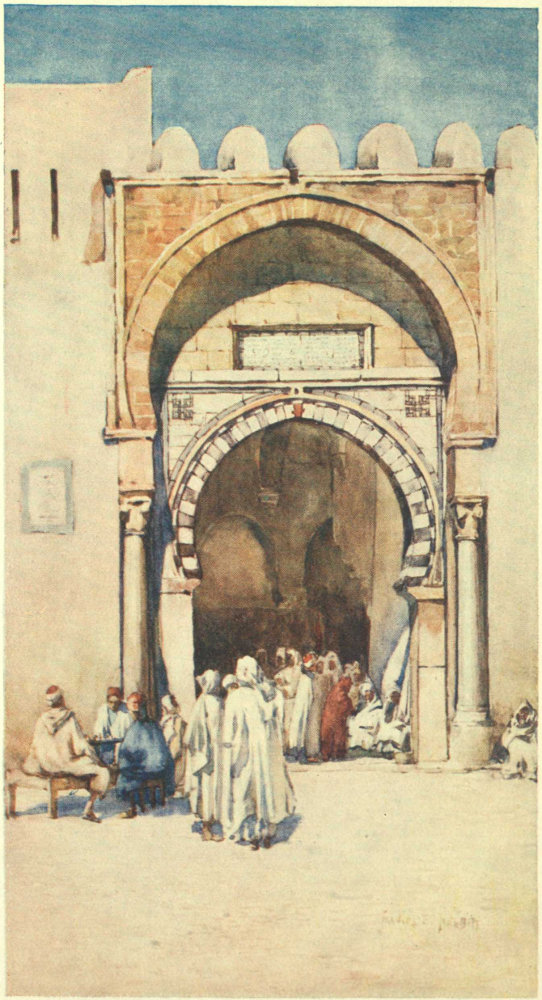
MOORISH GATEWAY, KAIROUAN
Outside the gate, more stalls and booths nestle against the walls, and the large open space beyond is crowded with all the bustle and confusion of a market. Men come and go, or gather in wide circles round the snake charmers and story-tellers. Horses and donkeys furtively steal a meal from the piles of grain and fodder. Camels snarl and growl whilst men pack burdens on their unwilling backs, as the caravans prepare to start on their journey. Other camels hop about on three legs, the fourth being doubled back and bound up in what looks a cruel fashion, but which the Arabs declare to be quite comfortable, and the only effective way to prevent their straying.
Beyond the market, again, are some curious reservoirs, called the Bassins des Aghlabites, which receive water from the Oued Merguelli in time of flood; they were probably constructed by Ziad el Allah, who restored the great Mosque.
Still further on, amongst hedges of prickly pears, or figues de Barbarie, rises the mosque of Sidi Sahab, the barber, the rival to the mosque of Sidi Okba, both as regards sanctity and beauty.
A square minaret slightly decorated with coloured tiles is surrounded by an apparently uninteresting pile of white buildings and a dome, but these walls conceal a series of halls and cloistered courts, full of exquisite 220 Moorish work worthy of the Alhambra, though, alas! like the Alhambra they have suffered somewhat at the hands of the restorer, with his distressing want of taste in colour.
Roman columns support the arches in the quiet courts, the floors are paved with marble, tiles of rich design line the walls, the light filters through coloured glass, set jewel-like in tiny windows, and the stucco work adds to the whole effect a touch of light and grace.
The tomb-mosque itself is a domed building of no great size, where behind an open-work screen lies the sarcophagus in which reposes the body of Abou Zemaa el Beloui, the companion and, as some suppose, the barber of the Prophet. Carpets and embroideries cover this tomb, numbers of lamps and ostrich eggs are suspended before it, and all round are ranged quantities of flags, the standards and colours of Islam. Tradition says, that during his life this singular man carried three hairs from the Prophet’s beard—one under his tongue, another next his heart, and the third on his right arm. These three precious hairs are now united in a silken sachet placed on the dead man’s breast, and whether the reputation of the saint or these relics of the Prophet have the greater power in drawing pilgrims to the shrine, is a doubtful question.
Delicate finish, suited to its smallness of scale, makes a yet more perfect shrine of the tiny forecourt, and dome over the tomb of another Marabout, Sidi Abid el Ghariani. Of all the Moorish work in the city, this Zaouïa is perhaps the gem—at any rate the hand of time has touched it lightly, so that nothing has been done to spoil its charm of colour.
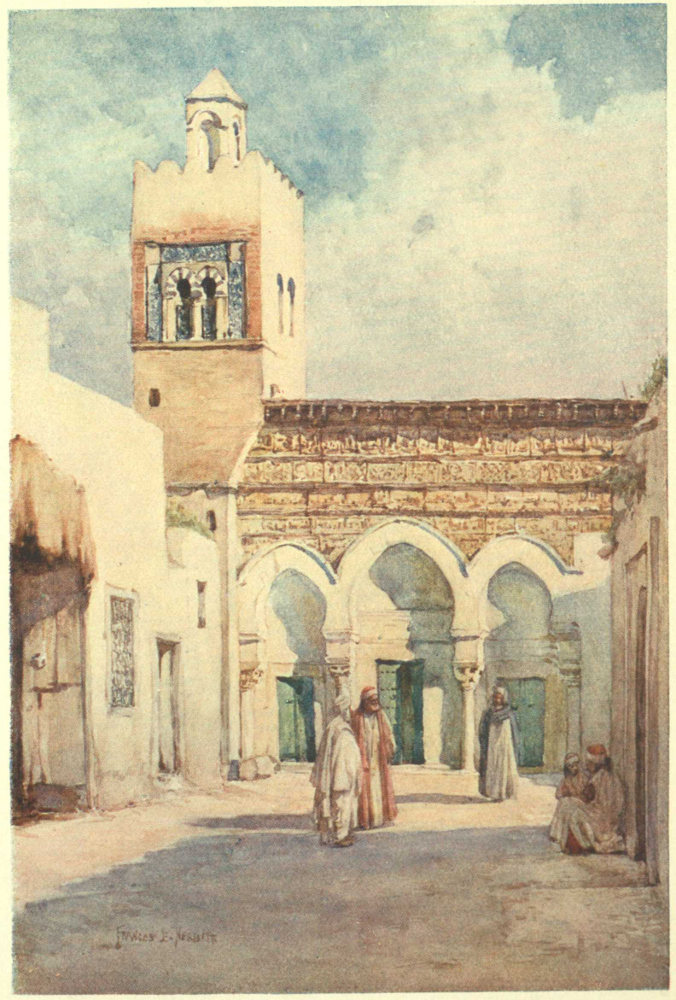
THE MOSQUE OF THE THREE DOORS, KAIROUAN
Quite other considerations make it worth while to go on pilgrimage to the Mosque of the Swords, though its only beauty lies in the distant effect of its seven fluted domes. It is dedicated to a comparatively modern saint, who had great influence in Kairouan. His name was Sidi Amer Abbada, and he began life as a blacksmith. To astonish his admirers he made, and they now say he used, gigantic swords, covered with inscriptions, one of which prophesies the coming of the French. His pipes are the pipes of a nightmare—too huge for mortal man to smoke. As for the colossal bronze anchors he is said to have carried on his shoulders from Porto Farina, quite unaided and alone, are they not now reposing in a courtyard close by? There the sceptical can go and see for themselves and come away abashed, saying, “Truly this was a great Marabout.”
The Djama Thelata Biban, or Mosque of the Three Doors, is noteworthy because of its great age (some six or seven hundred years old) and also for the decorative value of its façade. The plan is not in the least original, the outline is elementary—a square block with an equally square minaret beside it. But it is the treatment of the flat surface that is remarkable. The upper part of the front is shaded by a tiled roof supported by wooden brackets, old and mellow in tone. Underneath comes a broad space of golden stone, adorned by alternate bands 222 of raised inscriptions in Cufic characters, and fragments of Roman carved work. Below this all is white, the surface broken by three archways with old capitals and columns, that cast fascinating shadows on the three brilliant green doors that give the mosque its name. Coloured tiles in the same way relieve the whiteness and add to the charm of the minaret. Unfortunately the building is badly placed across the end of a dull street, so that it cannot be seen at a picturesque angle.
The pleasures of Kairouan are by no means exhausted by merely walking through the streets, visiting the mosques, and wandering outside the walls, not even by watching the life of the people either out of doors or at the cafés.
Sunsets as beautiful as those of Biskra may be enjoyed from the roof. Afterglows, with a depth and glory of red and crimson unrivalled even in Egypt, created by the magic atmosphere of the dry and somewhat dreary plain, which they transform into a land of mystery and romance.
When the moon rises, another scene of enchantment is revealed. The pale moonlight of our island home is unknown in Africa: here the contrast is wonderful, the brilliance positively startles. The first impression on leaving a lighted room is that it has been snowing heavily. Then gradually one begins to grasp the extraordinary depth of the shadows, the absolute clearness of each outline, the suffused glow, the positive warmth that throws such glamour over each common thing. Last of all, one sees that in this moonlight there is 223 colour, soft and low in tone, but yet distinctly recognisable.
As a little change, or perhaps because sunset and moonlight might be thought dull, the authorities kindly decreed that a military tattoo should be held. Gay sounds of martial music, the light tramp of marching feet, the hum of many voices, drew every one to the balcony, to find the street bright with flaming torches. The lights flared up, casting weird shadows over the crowd of eager faces as the wind blew the flames to and fro. The gay uniforms, the lightly stepping, almost dancing feet of the soldiers as they marked time, contrasted strangely with the statuesque pose of the sober citizens, or the wild unkempt figures of men from some distant oasis, or nomads from the desert. How they all enjoyed the show!—soldiers as much as any one else, and the band seemingly most of all.
The terrible rites of the Aïssaouas may be witnessed every night. The sect is powerful in Kairouan, has its own mosque, and they welcome all those whose curiosity is strong enough to overcome their feelings of horror or of self-contempt for wishing to look on at such doings.
The Marabout Aïssa (a name which means Jesus), who came from Morocco, was once wandering in the desert, far from home and friends, and suffered much from hunger. In fact he would have died of starvation had he not been endued with miraculous power, and this enabled him to eat all kinds of impossible food, including snakes, scorpions, fire, glass, and leaves of prickly pear, 224 spines and all. His followers imitate him, or pretend to do so, to this day, having previously worked themselves into a state of frenzy after the manner of the Howling Dervishes. Their feats in this direction, and also with swords and daggers run through their bodies, seem so hideous and disgusting even in the telling, that one wonders how any Europeans can bear to see the sight. Yet numbers do, and get so excited that they forget to be horrified or feel sick till they get home.
A wedding feast is a very different ceremony, so that to be invited to see one in old-world Kairouan is a piece of real good-fortune. After dinner the Arab servants hurried us off, with two French officers and their wives, through the still marvel of a moonlight night. The music of the tom-toms and the trilling cries, half-shrill, half-sweet, of rejoicing women, could be heard long before the house was reached.
The outer gate, decked with boughs, stood wide open, though as yet only the ladies were allowed to enter and cross the courtyard to an inner court full of flickering lights and a bewildering number of restless, ever-moving women. Gay as butterflies they fluttered round us, whilst with pretty gentle ways they patted and stroked our hands and clothes, pulled, pushed, and led us in and out of three tiny rooms, showing us all the preparations, the embroidered linen and hangings, the lights, the robes, the state bedstead, and, last of all, within a circle of elder women seated on the floor, the bride herself. Demure, a little wistful, with a studiously impassive expression, in all her finery of silk and veils, bedizened with jewels, she posed like an image, aloof and very lonely in the crowd.
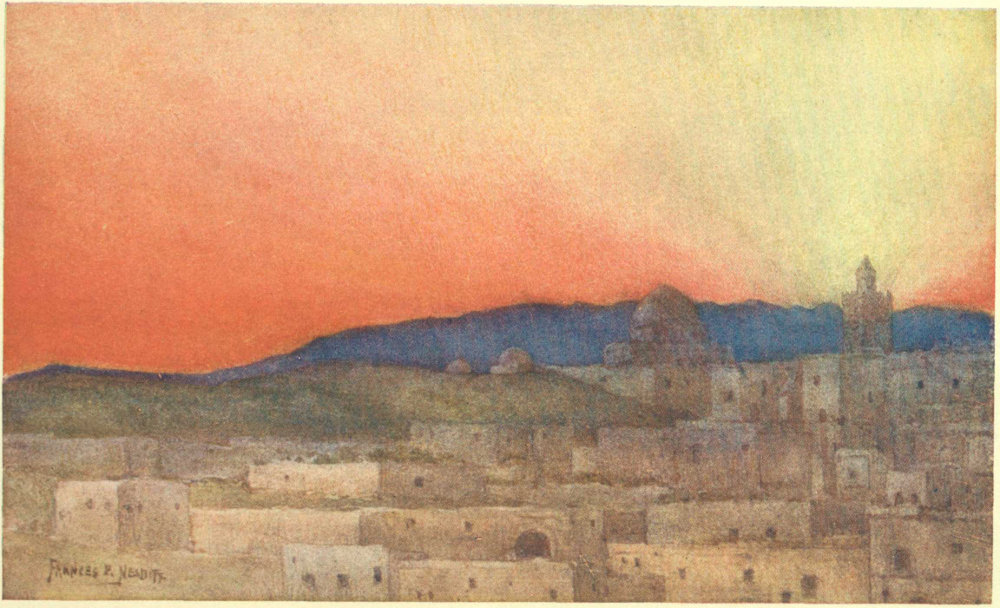
A DESERT AFTERGLOW
Then suddenly the cry was heard, “The bridegroom comes,” and in the twinkling of an eye we found ourselves alone in an empty court, the women had all vanished, though how they packed themselves into those wee rooms was a mystery.
Our loneliness was only momentary, for the men swept in like a flood to the sounds of the usual wild music and much banging of tom-toms. Then a group of Aïssaouas began their prayer or incantations, swaying and shouting as they swung themselves backwards and forwards. Happily the bridegroom was impatient, and stopped the performance before any horrors occurred. Whereupon the men were all hustled off the premises, the French officers very reluctantly going with the rest. As the last man disappeared, out fluttered all the butterflies again. It was the woman’s hour, and they made the most of it. They enthroned the bridegroom, a handsome young man, on a dais, covered his head with a beautiful new burnous, arranged to fall like a veil on either side of his face, which it almost concealed. Like the bride, he was preternaturally solemn, and sat there with his eyes shut, pretending to see nothing, whilst thoroughly enjoying many furtive peeps.
Then the revels began, pretty girls danced round him laughing, with lighted candles held on high. With a certain quaint grace they mingled merciless chaff with all manner of elfish tricks, pinching and giving him saucy kisses, deceiving him with pretences that his bride 226 was coming, even going so far as to play at being the bride themselves, and doing their utmost to make him laugh. Only Rembrandt could have done justice to the delightful effects of light and shade, the marvellous play of colour. The girls, with their bright beauty enhanced by the quaint horned caps, the gay silk veils, and chains and jewels gleaming under the flickering lights, the lace sleeves falling away from their bare arms, and their lithe, graceful forms wrapped in bright-hued silk, were a perfect picture.
The bridegroom bore all the teasing with a stolid countenance and a mock air of meekness—it is considered most unlucky to smile—but at last he received his reward. The real bride stood before her lord, veiled, with her head slightly bowed. He rose, lifted her veil, and kissed her. The little ceremony was at an end.
A B C D E F G H I J K L M N O P Q R S T U V W X Y Z
THE END
Printed by R. & R. Clark, Limited, Edinburgh.
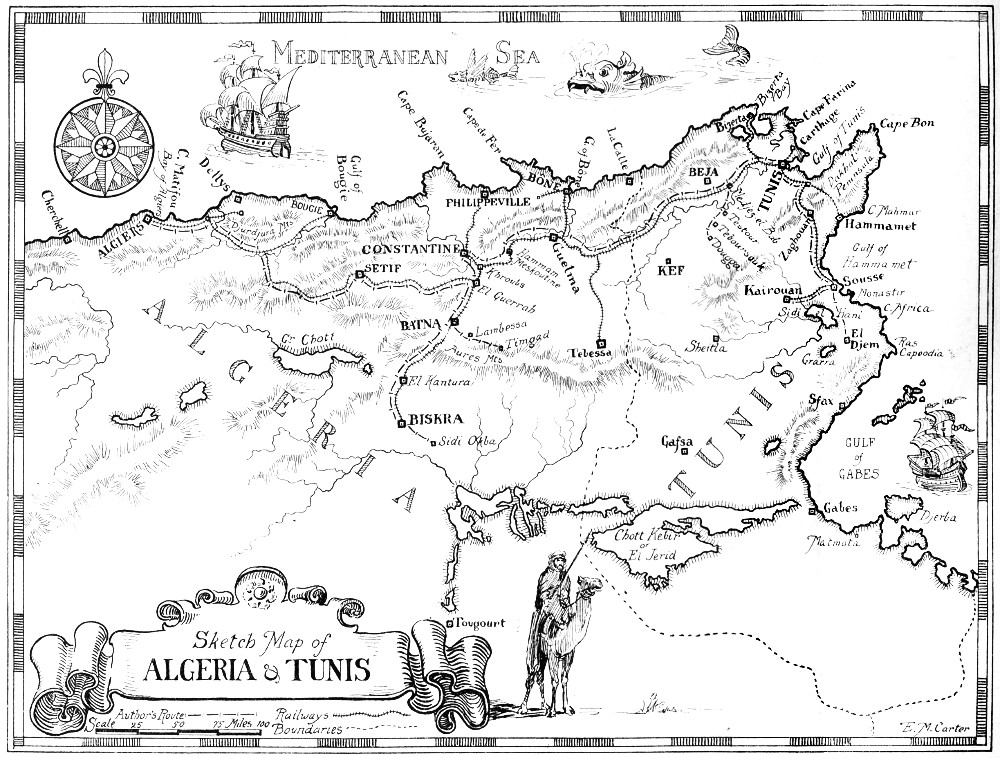
Sketch Map of
ALGERIA & TUNIS
PUBLISHED BY A. AND C. BLACK, SOHO SQUARE, LONDON.
A COMPANION VOLUME
IN THE SAME SERIES
MOROCCO
PAINTED BY A. S. FORREST
DESCRIBED BY S. L. BENSUSANCONTAINING 74 FULL-PAGE ILLUSTRATIONS IN COLOUR
PRICE 20s. NET
Post free, 20s. 6d.A. J. Dawson in The Speaker says:—“It is a carefully finished piece of work, capably written and sincerely thought out; this, with the numerous and beautiful illustrations, makes the whole a very desirable book.”
Published by
A. & C. BLACK, Soho Square, LONDON, W.
AGENTS
America
The Macmillan Company
64 & 66 Fifth Avenue, New York
Canada
The Macmillan Company of Canada, Ltd.
27 Richmond Street West, Toronto.
India
Macmillan & Company, Ltd.
Macmillan Building, Bombay
309 Bow Bazaar Street, Calcutta
EACH CONTAINING FULL-PAGE ILLUSTRATIONS IN COLOUR, REPRODUCED IN THE SAME STYLE AS THOSE IN “ALGERIA AND TUNIS”
PAINTED AND DESCRIBED BY R. TALBOT KELLY, R.B.A.
BURMA
CONTAINING 75 FULL-PAGE ILLUSTRATIONS IN COLOUR
Price 20s. net.
Burlington Magazine.—“Mr. Kelly says but little of Burmese history and architecture, but he has wandered away from the beaten track, and draws the jungle as well as he draws pagodas, rendering without harshness the difficult greens of tropical foliage and the blaze of tropical sunlight.”
The Speaker.—“The result is a narrative delightful in its quiet zest, and a series of pictures that have the hues of landscapes hung in a heaven of dreamland.”
The Athenæum.—“His landscapes—in which nature is seen unforced by the hands of colour-loving men and women, and seen, more often than not, by early morning or evening light—have an exquisite delicacy.”
PAINTED BY WARWICK GOBLE.
DESCRIBED BY PROF. ALEXANDER VAN MILLINGEN D.D.
CONSTANTINOPLE
CONTAINING 63 FULL-PAGE ILLUSTRATIONS IN COLOUR
Price 20s. net.
Constantinople ranks high as one of the picturesque cities of the world, and Mr. Warwick Goble, in his fine series of pictures reproduced in this volume, reveals it to us under many interesting aspects; we see it, for example, at early morning, with its spires and minarets emerging through the haze, when it seems like an enchanted city of the “Thousand and One Nights.” We get glimpses of life in its streets; we are shown its flower-markets, its bazaars, its cafés, its walls, its churches, its mosques, its cemeteries, and several types of its inhabitants form the subject of special sketches.
Dr. Alexander van Millingen, the author of the book, is Professor of History at Robert College, Constantinople, and is a recognised authority on all that pertains to the city. He has written out of the fulness of his knowledge in a way that cannot fail to interest the reader.
PAINTED AND DESCRIBED BY R. TALBOT KELLY
EGYPT
CONTAINING 75 FULL-PAGE ILLUSTRATIONS IN COLOUR
Price 20s. net.
The Academy.—“Amongst books of its class Mr. Kelly’s deserves a high place. It is sincere and distinctive, and the artist records atmosphere and sky with more than ordinary understanding.”
The Bookman.—“Rarely can this old, old country have received more beautiful homage than here—the happily inspired work of a true artist revealing her countless charms.”
Black and White.—“This is a magnificent production of his, abounding with fine pictures beautifully reproduced and teeming with fine descriptive touches and bright anecdotal matter.”
PAINTED BY J. FULLEYLOVE, R.I.
DESCRIBED BY THE REV. J. A. M‘CLYMONT, M.A.
GREECE
CONTAINING 75 FULL-PAGE ILLUSTRATIONS IN COLOUR
Price 20s. net.
The object of the writer is to supply a congenial atmosphere in which the famous scenes and objects depicted by the artist may be intelligently and sympathetically viewed. Some amount of description has been given from recent personal observation, but the letterpress is mainly devoted to the historical associations connected with the different places of which pictures are shown. Some information is also given, incidentally, regarding the condition and prospects of modern Greece.
PAINTED BY J. FULLEYLOVE, R.I.
DESCRIBED BY THE REV. JOHN KELMAN, M.A.
THE HOLY LAND
CONTAINING 92 FULL-PAGE ILLUSTRATIONS, MOSTLY IN COLOUR
Price 20s. net.
Westminster Gazette.—“To those who have been in Palestine Mr. Kelman’s book will recall much and suggest many new ideas. To those who have not, it will give, perhaps, a more accurate impression of the land and the people than any other work on Palestine.”
Daily Chronicle.—“Even people who care nothing for art are interested in faithful representations of the Holy Land as it is seen to-day. And here they have the whole country laid before them in scenes of extraordinary beauty—the mountains so full of history and poetic memories, the ancient river and the accursed sea, the holy city with her relics and her mosques, the brilliant Syrian crowds, and then the open country of ‘those holy fields over whose acres walked those blessed feet.’”
BY MORTIMER MENPES, R.I.
TEXT BY FLORA A. STEEL
INDIA
CONTAINING 75 FULL-PAGE ILLUSTRATIONS IN COLOUR
Price 20s. net.
The Standard.—“There can be no two opinions about this book. It takes us, so to speak, to India without the trouble or expense involved in the journey.”
Notes and Queries.—“This eminent painter has caught—by methods which are partly his secret and partly his discovery—the means of reproducing Indian and Japanese scenes with a fidelity and beauty until recently unattainable.”
The Scotsman.—“The volume is an uncommonly desirable book. If the Horatian maxim be correct, it should carry every point, for it is as happy a mixture as could be made of the profitable and the sweet.”
BY MORTIMER MENPES, R.I.
THE TEXT BY DOROTHY MENPES
JAPAN
CONTAINING 100 FULL-PAGE ILLUSTRATIONS IN COLOUR
Price 20s. net.
Black and White.—“It is a charming volume, and contains some of the most delightful of Mr. Menpes’s Japanese studies. The reading matter, too, is very bright, and accords most agreeably with the delightful pages in which the artist holds unquestionable possession of the stage.”
The Times.—“Mr. Menpes’s pictures are here given in most perfect facsimile, and they form altogether a series of colour-impressions of Japan which may fairly be called unrivalled. Even without the narrative they would show that Mr. Menpes is an enthusiast for Japan, her art, and her people; and very few European artists have succeeded in giving such complete expression to an admiration in which all share.”
PAINTED BY A. S. FORREST
DESCRIBED BY S. L. BENSUSAN
MOROCCO
CONTAINING 74 FULL-PAGE ILLUSTRATIONS IN COLOUR
Price 20s. net.
The World.—“It is certain that the Morocco of to-morrow must needs be very different from the Morocco of to-day; and so we should be grateful for a really handsome presentation, in print and in pictures, of the country as it is. In Morocco, painted by A. S. Forrest, described by S. L. Bensusan, we have the very thing; and this book should soon find a place upon the shelves not only of every lover of past and passing conditions, but of every student of travel and history, and of every one who is capable of being interested in foreign politics.”
Pall Mall Gazette.—“This is a wonderful series of pictures of life in Maghreb-el-Acksa.”
PAINTED AND DESCRIBED BY A. HENRY SAVAGE LANDOR
TIBET AND NEPAL
CONTAINING 75 FULL-PAGE ILLUSTRATIONS (50 IN COLOUR)
Price 20s. net.
The Academy.—“The present writer can only say that, for his part, he believes his author to be sincere and correct, and one of the pluckiest, truest-hearted, and most enterprising men in the world to boot. To this encomium might be added, one of the cleverest, too, for the drawings in colour and black-and-white display a very acute artistic sense and exquisite perception of the beauty and grandeur of mountain scenery.”
The Onlooker.—“The book does not contain a dull page (or a dull illustration) from beginning to end.”
BY LADY BUTLER
PAINTER OF ‘THE ROLL CALL,’ ‘SCOTLAND FOR EVER’
LETTERS from the HOLY LAND
CONTAINING 16 FULL-PAGE ILLUSTRATIONS IN COLOUR FROM PAINTINGS BY THE AUTHOR
Price 7s. 6d. net.
The Outlook.—“Charmingly natural and spontaneous travel impressions with sixteen harmonious illustrations. The glow, spaciousness, and atmosphere of these eastern scenes are preserved in a way that eloquently attests the possibilities of the best colour process work.”
St. James’s Gazette.—“The letters in themselves afford their own justification; the sketches are by Lady Butler, and when we have said that we have said all. Combined, they make a book that is at once a delight to the eye and a pleasure to handle. The coloured illustrations, marvellously well reproduced, provide in a panoramic display faithful representations of the Holy Land as it is seen to-day. They make a singularly attractive collection, worthy of the distinguished artist who painted them.”
PUBLISHED BY A. & C. BLACK · SOHO SQUARE · LONDON · W.